Collection overview
The John Layard 1914–1915 Atchin, New Hebrides Cylinder Collection (C177) is a set of 32 brown wax cylinders that were recorded on the island of Atchin off the north coast of Malakula (Malekula) in Vanuatu between September 1914 and October 1915. The recordist was John Willoughby Layard (1891-1974), a British anthropologist.
Research by Vicky Barnecutt, British Library.
The information from Layard’s notes and publications indicates that all 32 cylinders were recorded on Atchin. Atchin is one of the Small Islands off the north-east coast of Malakula in Vanuatu. The language spoken is Uripiv-Wala-Rano-Atchin [upv]; there are about 5000 people who speak this language, of whom 1,380 are from Atchin (Eberhard et al 2021:32). Layard noted the names of many of the performers and some of the recording locations.
Recordings
Layard noted that most of the songs he recorded came from Atchin, particularly from “evening concerts” performed by the young men of the island; he wrote that he “took a number of phonograph records, both of the songs and of the gong [i.e. wooden slit-gong]-rhythms, some of which have now been transferred onto gramophone plates, which await detailed study by experts” (Layard 1942: 314). In a footnote, he asked that if “any reader skilled in comparative music and the scientific working out of such material would care to undertake this work I should be glad to hear from him” (Layard 1942: 314).
The 32 cylinders in C177 all have “LAYARD ATCHIN” written in ink on the lid, as well as a number or letter identifier. This identifier lists the cylinders as A-E, 2-16 and 50-60 (including 57a and b), It is not clear why Layard used this unusual numbering sequence, but information from Layard’s fieldnotes (Layard n.d.), provided to the True Echoes project by Cristela Garcia-Spitz from the University of California, San Diego1Cristela Garcia-Spitz is the Digital Initiatives Librarian and Curator of the Tuzin Archive for Melanesian Anthropology at UC San Diego Library, indicates that he only recorded these 32 cylinders during his time on Atchin.
| British Library shelfmark | Recording title | Performer name | Recording location | Recording date | Content description | Performer description | Recording notes | Languages | Genre | Recordist | Recording length | Recording trip | Description of cylinder | Collection title | Cylinder location | Images of cylinder containers / documentation | Related print publication: | Related print publication: | Related print publication: | Related print publication: | Related print publication: | Related print publication: |
|---|---|---|---|---|---|---|---|---|---|---|---|---|---|---|---|---|---|---|---|---|---|---|
| C177/267 | Palu-ulen | Unidentified (male chorus) | Atchin, Malekula, New Hebrides Condominium (Vanuatu) | 28 September 1914 – 9 October 1915 | 1. Male vocal group. From Layard's fieldnotes (page 18): "wora nera, followed straight by Ias we" Notation indicates that both wora nera and las we were "sung by e she womu ni" In his fieldnotes (page 18) Layard noted that the Palu-Ulen songs were "sung by Melteg-to and Melteg-mari, Melteg-waru and Melteg-lingi together." | Reasonable quality recording. | Uripiv-Wala-Rano-Atchin | Field recordings | John Willoughby Layard, 1891-1974 | 5'39" | John Layard, 1914-1915 | Brown wax cylinder | John Layard 1914 Atchin, New Hebrides Cylinder Collection | British Library | 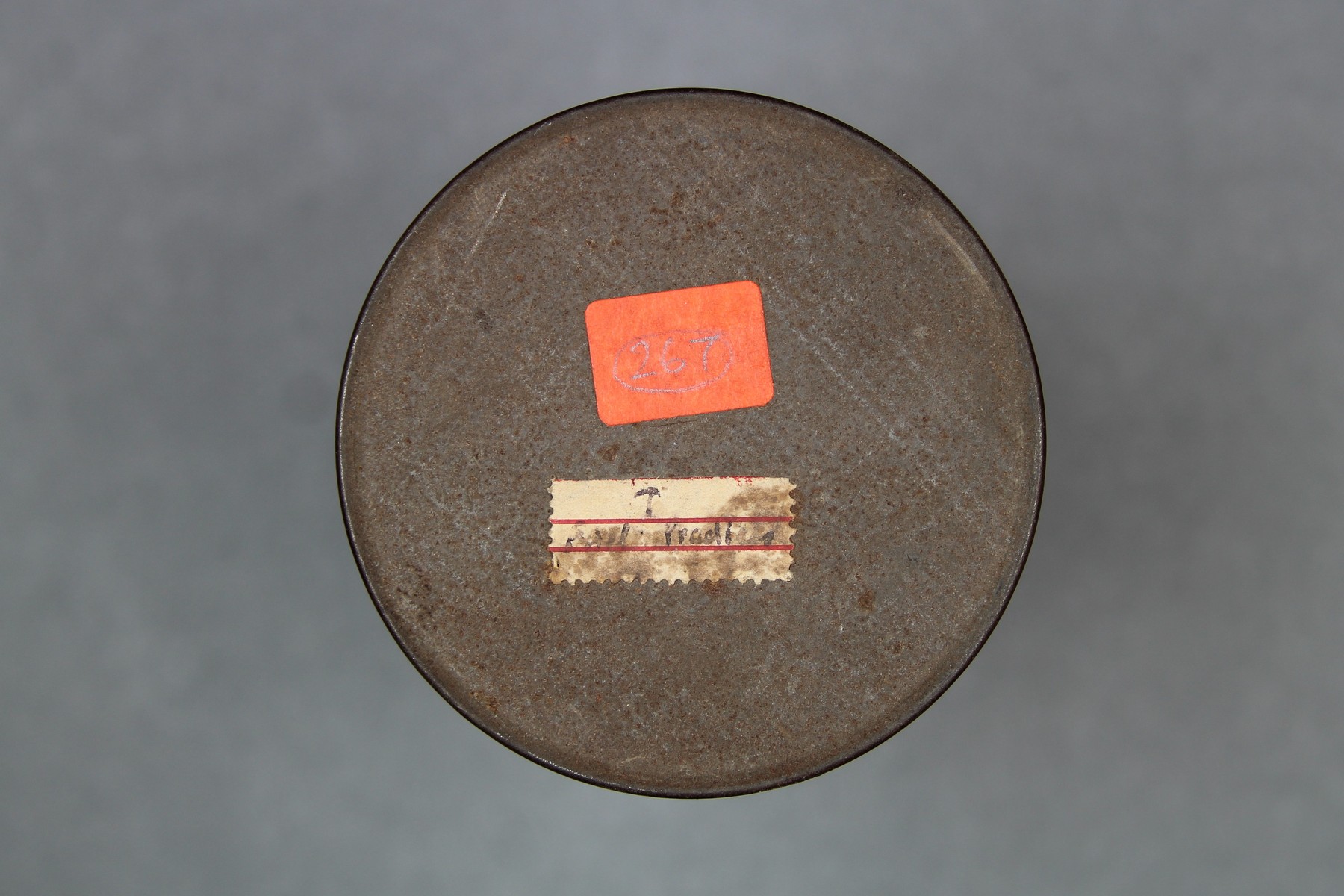 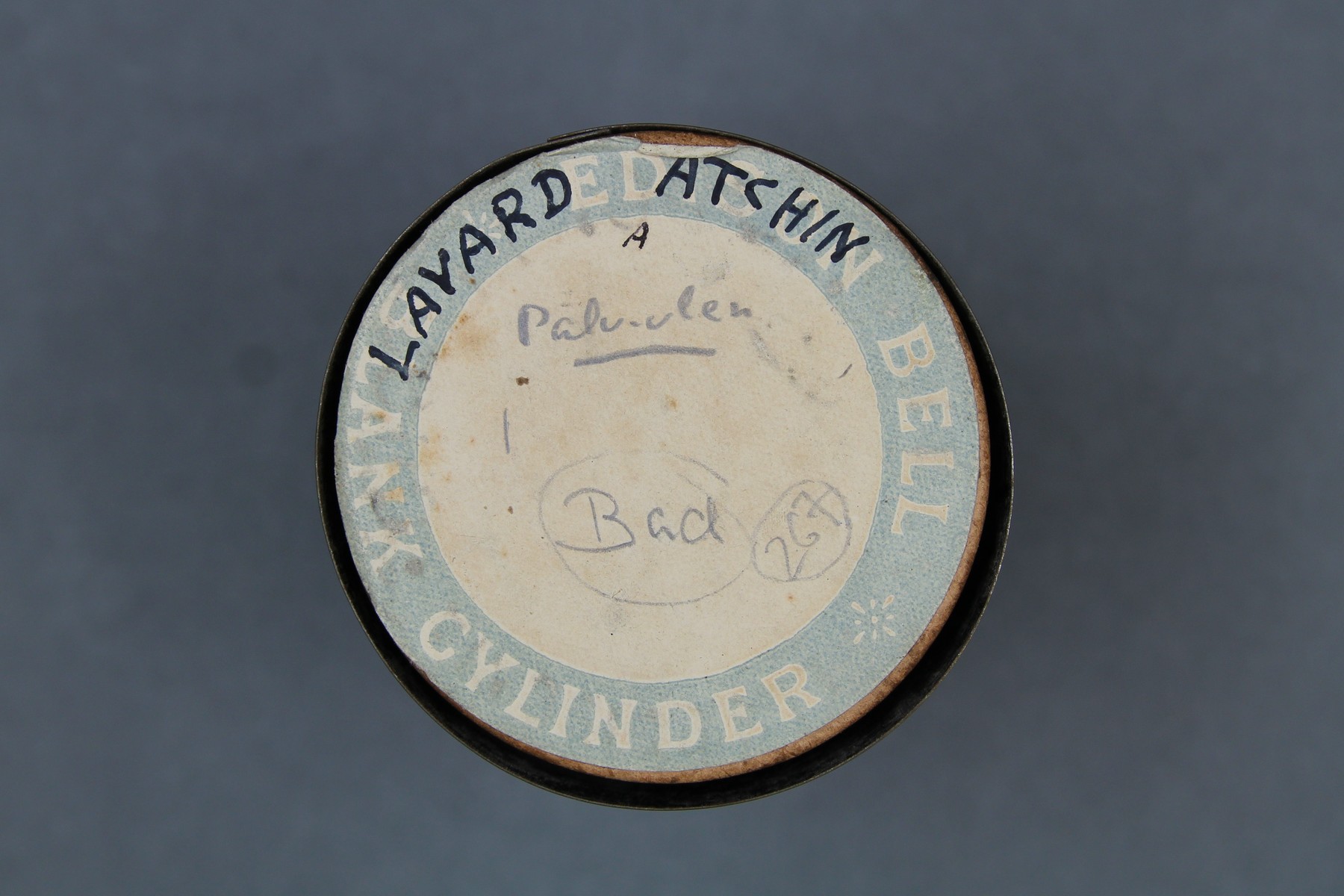     | Layard's fieldnotes are in the John Willoughby Layard papers (MSS 84) in the Special Collections & Archives of the University of California, San Diego. The music notes are compiled in a PDF titled ‘Unpublished Atchin book: “Folk Songs”: Annotated music books, with words and music, hand-written and typed notes, translations.’ from box 47, folder 8. This PDF is held by the British Library. | ||||||
| C177/268 | Male vocal group | Unidentified (male chorus) | Atchin, Malekula, New Hebrides Condominium (Vanuatu) | 28 September 1914 – 9 October 1915 | 1. Ref note followed by male vocal group. 2. Unaccompanied male vocal group. 3. Ref note followed by male vocal group. 4. Male vocal group. From Layard's fieldnotes (page 18): "Wetombara. Towiwi. Nawiri me lambe. Nawiri me lambe again. (Wetombara and Towiwi should be done twice)." Notation indicates that Wetombara, Towiwi and Nawiri were "sung by e she womu ni". In his fieldnotes (page 18) Layard noted that the Palu-Ulen songs were "sung by Melteg-to and Melteg-mari, Melteg-waru and Melteg-lingi together." | Reasonable quality recording with strong signal but some distortion. | Uripiv-Wala-Rano-Atchin | Field recordings | John Willoughby Layard, 1891-1974 | 4'19" | John Layard, 1914-1915 | Brown wax cylinder | John Layard 1914 Atchin, New Hebrides Cylinder Collection | British Library | 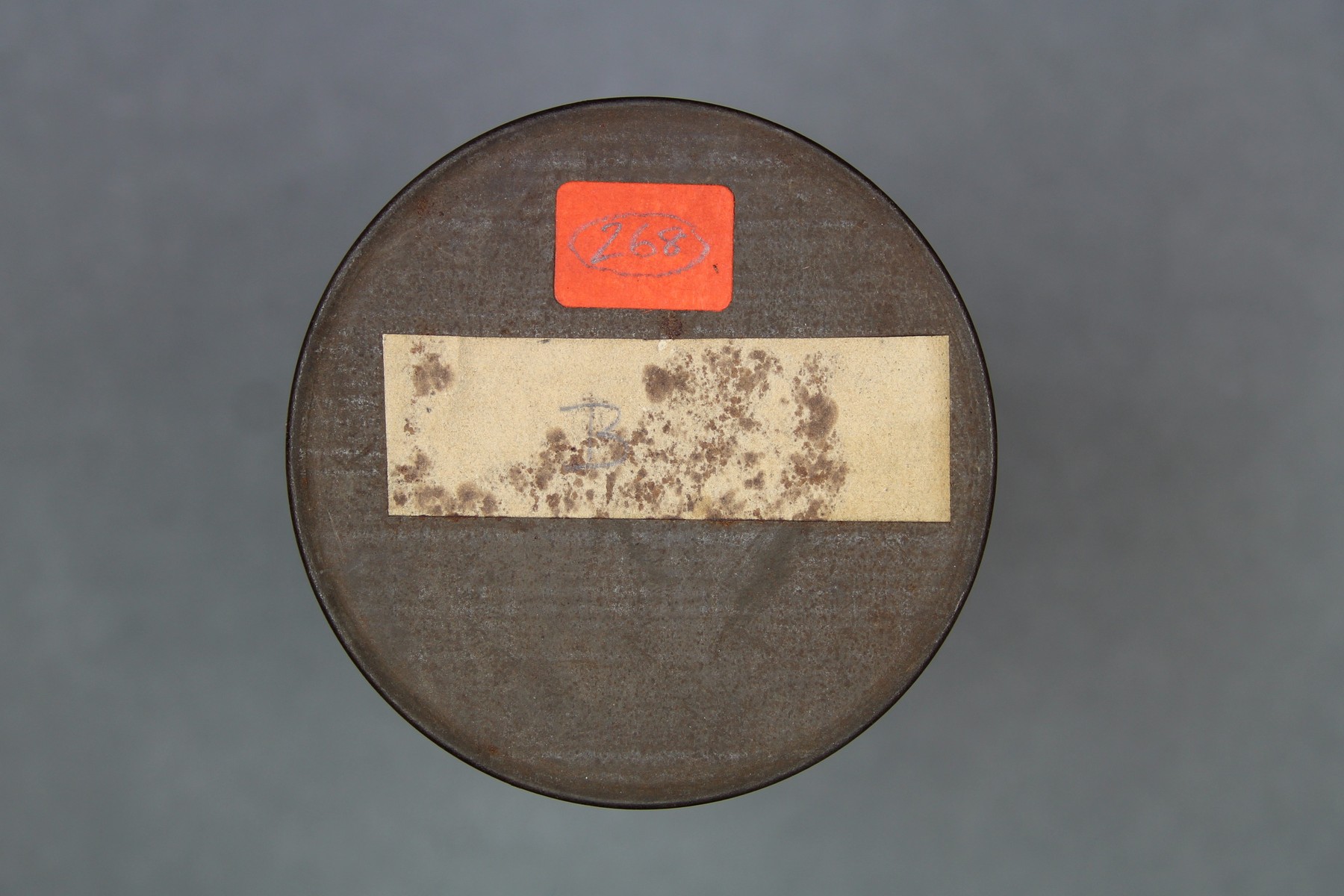 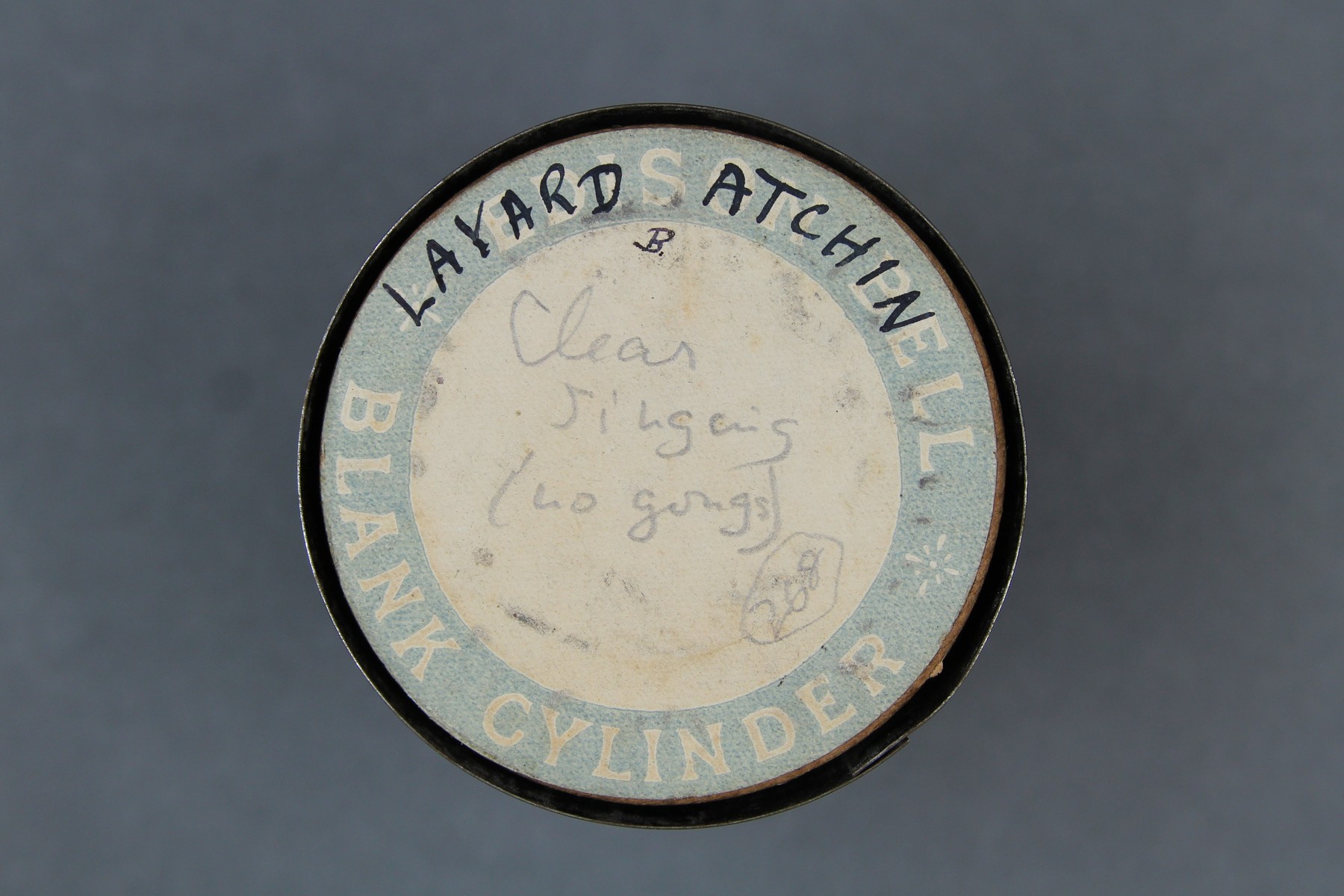     | Layard's fieldnotes are in the John Willoughby Layard papers (MSS 84) in the Special Collections & Archives of the University of California, San Diego. The music notes are compiled in a PDF titled ‘Unpublished Atchin book: “Folk Songs”: Annotated music books, with words and music, hand-written and typed notes, translations.’ from box 47, folder 8. This PDF is held by the British Library. | ||||||
| C177/269 | Male vocal group and solos [1] | Unidentified (male chorus) | Atchin, Malekula, New Hebrides Condominium (Vanuatu) | 28 September 1914 – 9 October 1915 | 1. Unaccompanied male vocal group. 2. Ref note followed by vocal group. From Layard's fieldnotes (page 18): "Neseau turelo. Nawits nororum." Notation indicates that these were "sung by e she womu ni" In his fieldnotes (page 18) Layard noted that the Palu-Ulen songs were "sung by Melteg-to and Melteg-mari, Melteg-waru and Melteg-lingi together." | Reasonable quality recording with strong signal but some distortion. | Uripiv-Wala-Rano-Atchin | Field recordings | John Willoughby Layard, 1891-1974 | 4'03" | John Layard, 1914-1915 | Brown wax cylinder | John Layard 1914 Atchin, New Hebrides Cylinder Collection | British Library | 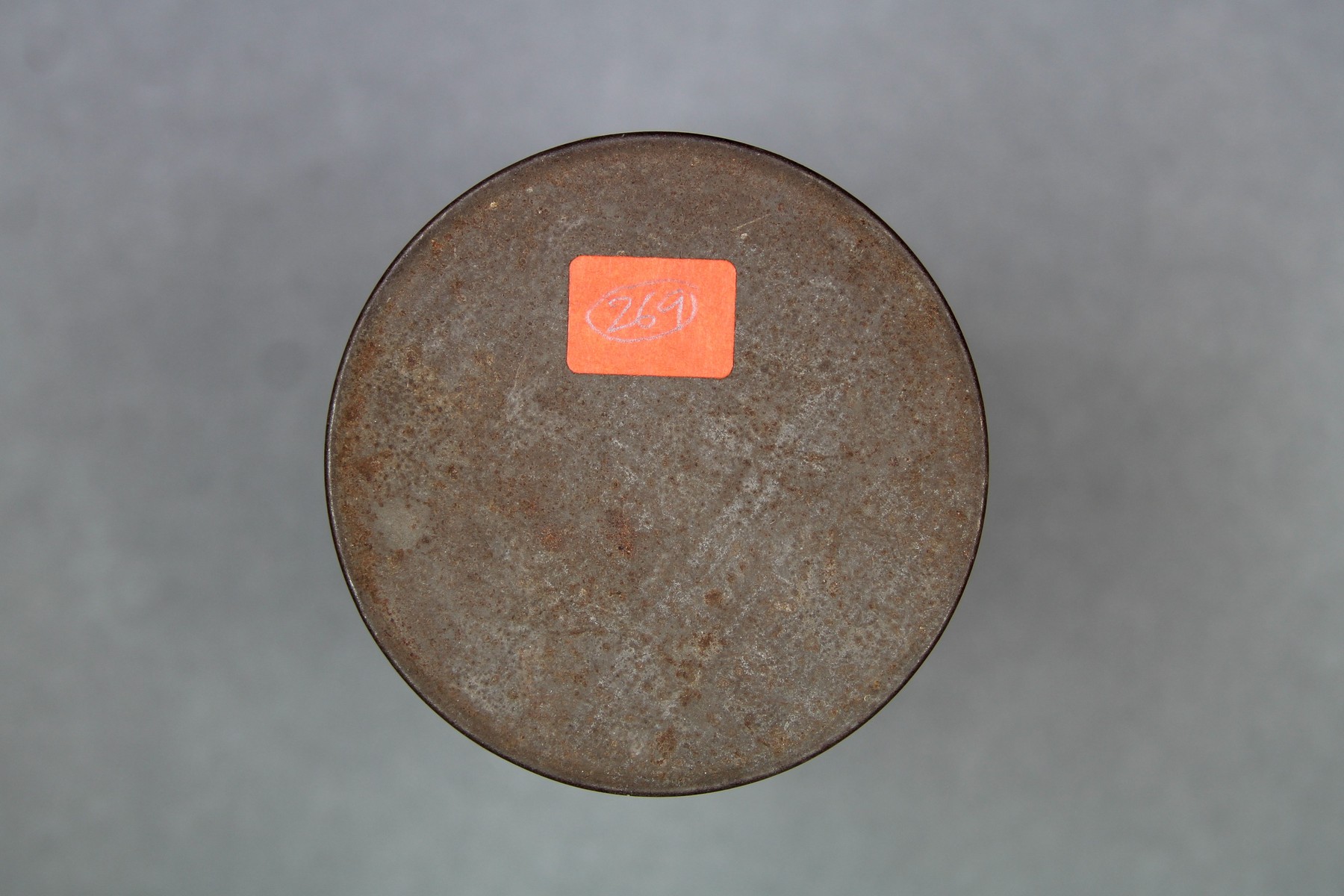 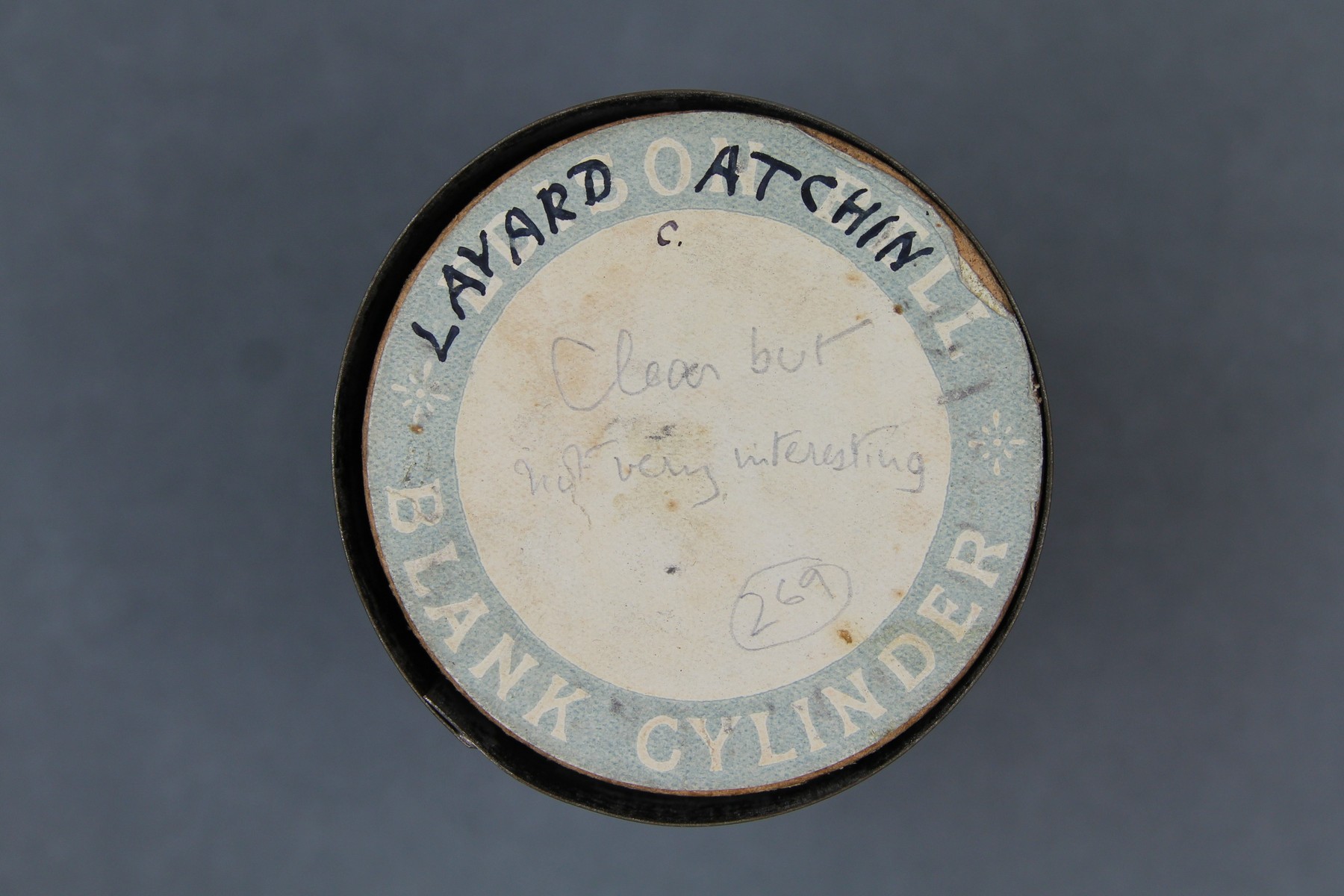     | Layard's fieldnotes are in the John Willoughby Layard papers (MSS 84) in the Special Collections & Archives of the University of California, San Diego. The music notes are compiled in a PDF titled ‘Unpublished Atchin book: “Folk Songs”: Annotated music books, with words and music, hand-written and typed notes, translations.’ from box 47, folder 8. This PDF is held by the British Library. | ||||||
| C177/270 | Male vocal group and solos [2] | Unidentified (singer, male) | Atchin, Malekula, New Hebrides Condominium (Vanuatu) | 28 September 1914 – 9 October 1915 | 1. Ref note followed by male vocal group (seemingly a continuation of C177/269). 2-4. Unaccompanied male vocal solo. From Layard's fieldnotes (page 18): "Pitseroto, pitseroto sung? (sts. through twice)" Notation indicates that these were "sung by e she womu ni" In his fieldnotes (page 18) Layard noted that the Palu-Ulen songs were "sung by Melteg-to and Melteg-mari, Melteg-waru and Melteg-lingi together." | Reasonable quality recording with strong signal but some distortion. | Uripiv-Wala-Rano-Atchin | Field recordings | John Willoughby Layard, 1891-1974 | 4'30" | John Layard, 1914-1915 | Brown wax cylinder | John Layard 1914 Atchin, New Hebrides Cylinder Collection | British Library | 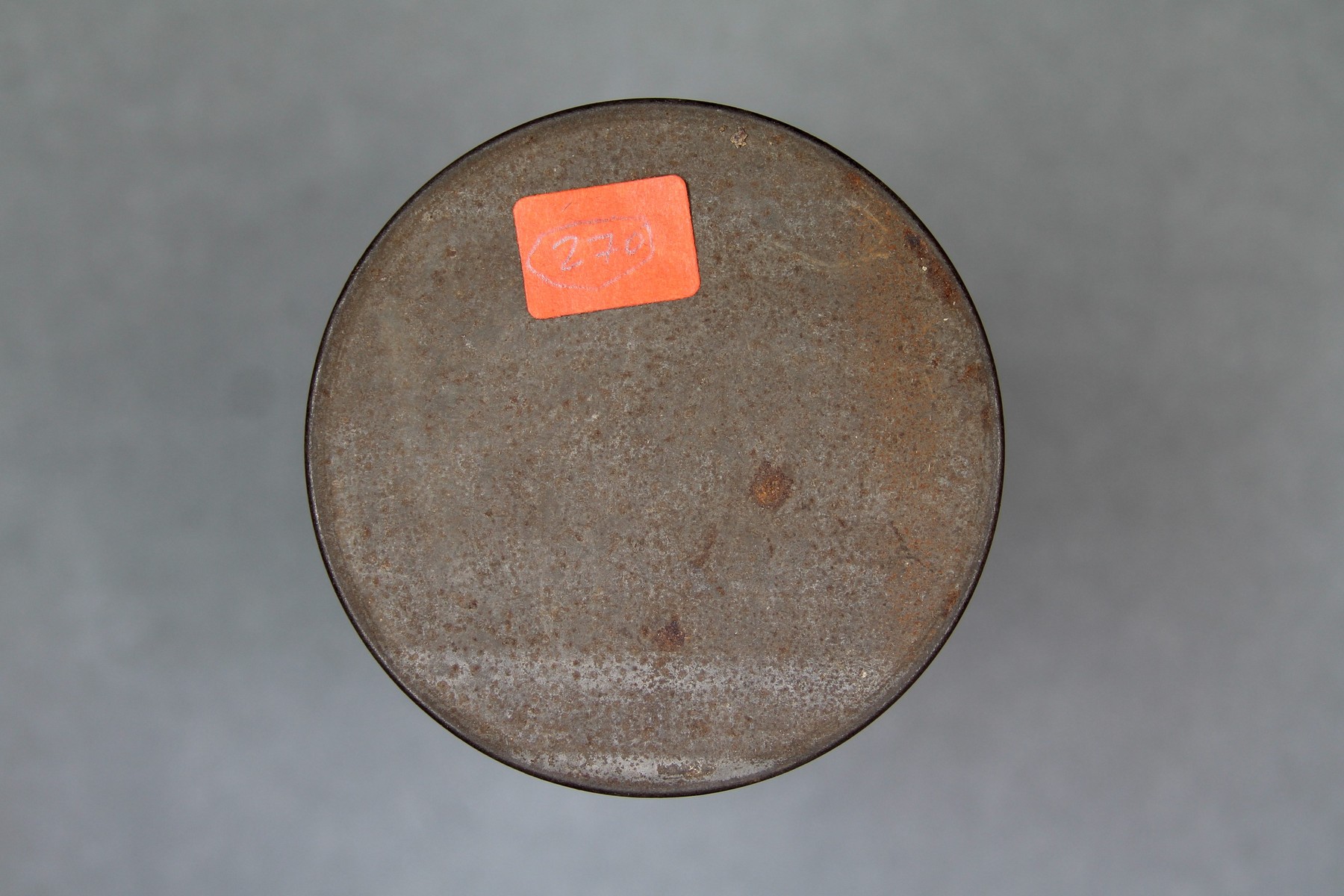 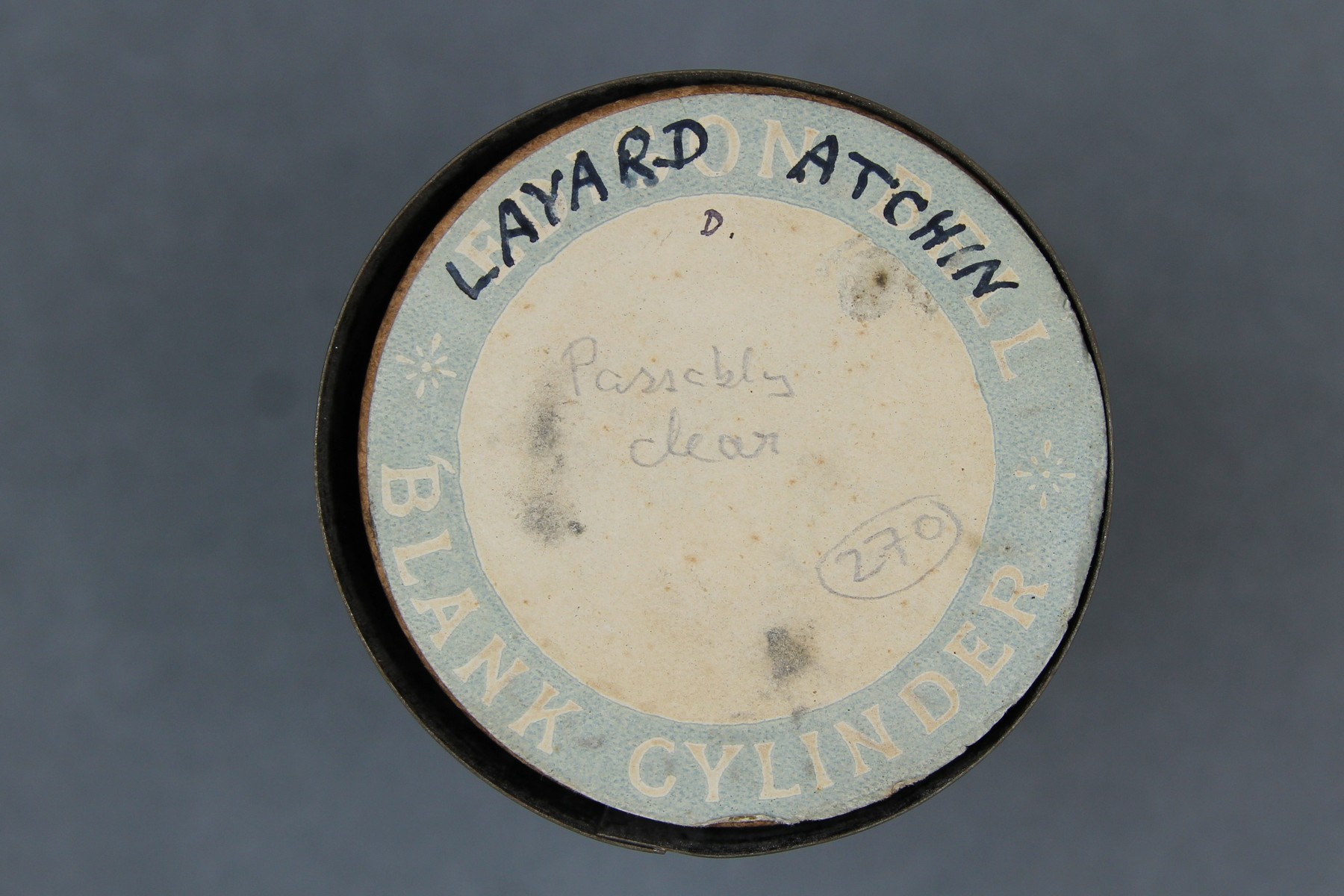     | Layard's fieldnotes are in the John Willoughby Layard papers (MSS 84) in the Special Collections & Archives of the University of California, San Diego. The music notes are compiled in a PDF titled ‘Unpublished Atchin book: “Folk Songs”: Annotated music books, with words and music, hand-written and typed notes, translations.’ from box 47, folder 8. This PDF is held by the British Library. | ||||||
| C177/271 | Palu-ulen songs | Unidentified (male chorus) | Atchin, Malekula, New Hebrides Condominium (Vanuatu) | 28 September 1914 – 9 October 1915 | 1-2. Unaccompanied male vocal group. In his fieldnotes (page 18) Layard noted that the Palu-Ulen songs were "sung by Melteg-to and Melteg-mari, Melteg-waru and Melteg-lingi together." | Reasonable quality recording. | Uripiv-Wala-Rano-Atchin | Field recordings | John Willoughby Layard, 1891-1974 | 5'01" | John Layard, 1914-1915 | Brown wax cylinder | John Layard 1914 Atchin, New Hebrides Cylinder Collection | British Library | 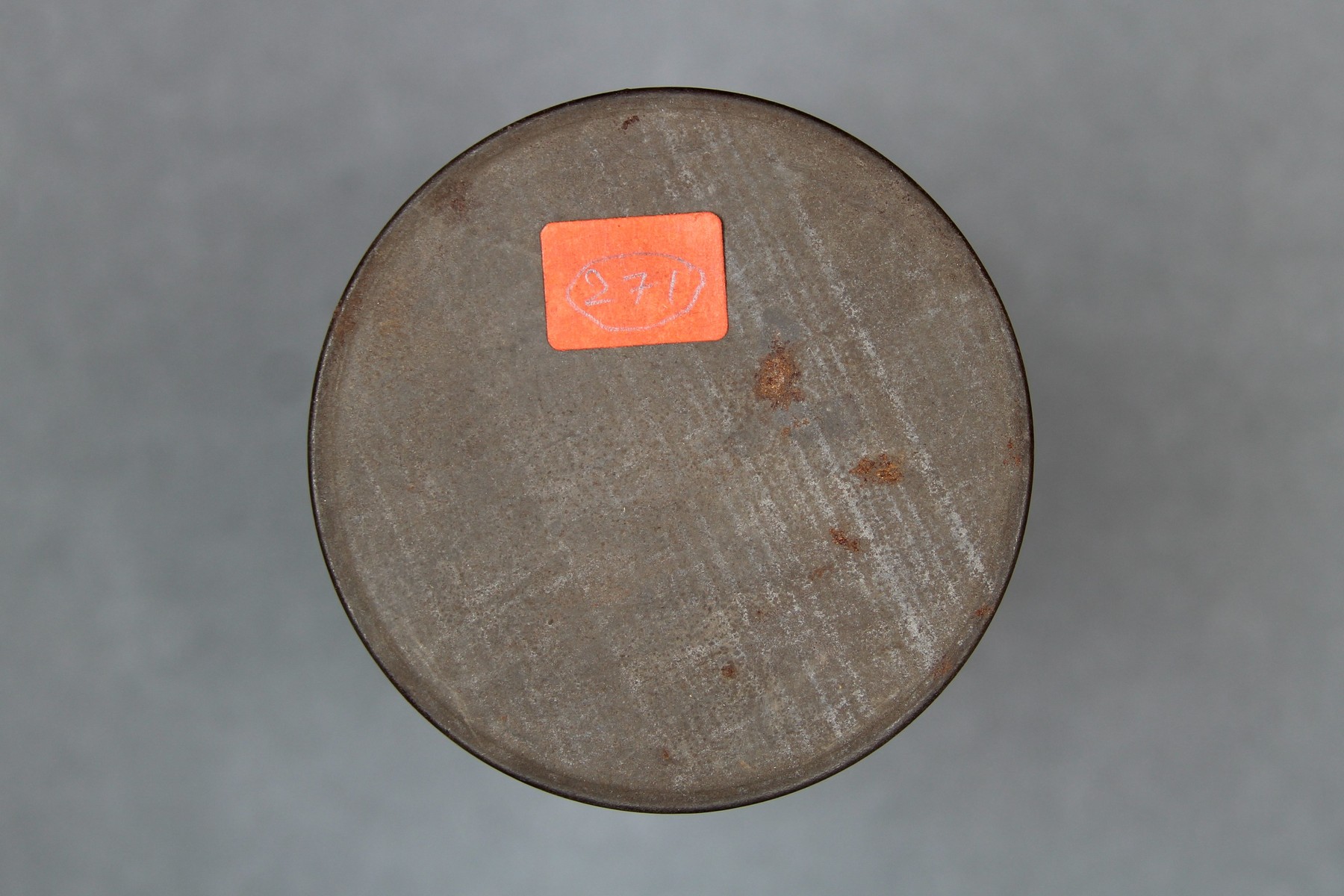      | Layard's fieldnotes are in the John Willoughby Layard papers (MSS 84) in the Special Collections & Archives of the University of California, San Diego. The music notes are compiled in a PDF titled ‘Unpublished Atchin book: “Folk Songs”: Annotated music books, with words and music, hand-written and typed notes, translations.’ from box 47, folder 8. This PDF is held by the British Library. | ||||||
| C177/272 | Songs of Durenambwe / sung by Meldektaus (Olep) | Meldektaus (singer, male) | Atchin, Malekula, New Hebrides Condominium (Vanuatu) | 28 September 1914 – 9 October 1915 | 1-5. Unaccompanied male vocal solo - recording technician noted "track 3 is the 'failure'". Song – Song – Failure / – Song – Continuation / of last song. From Layard's fieldnotes (page 104): “Songs of Durei-na-mbwe sung by Melteg-taus (of Olep) III Song -- Song -- Failure Song -- Continuation of last song” | Reasonable quality recording. | Uripiv-Wala-Rano-Atchin | Field recordings | John Willoughby Layard, 1891-1974 | 4'13" | John Layard, 1914-1915 | Brown wax cylinder | John Layard 1914 Atchin, New Hebrides Cylinder Collection | British Library | 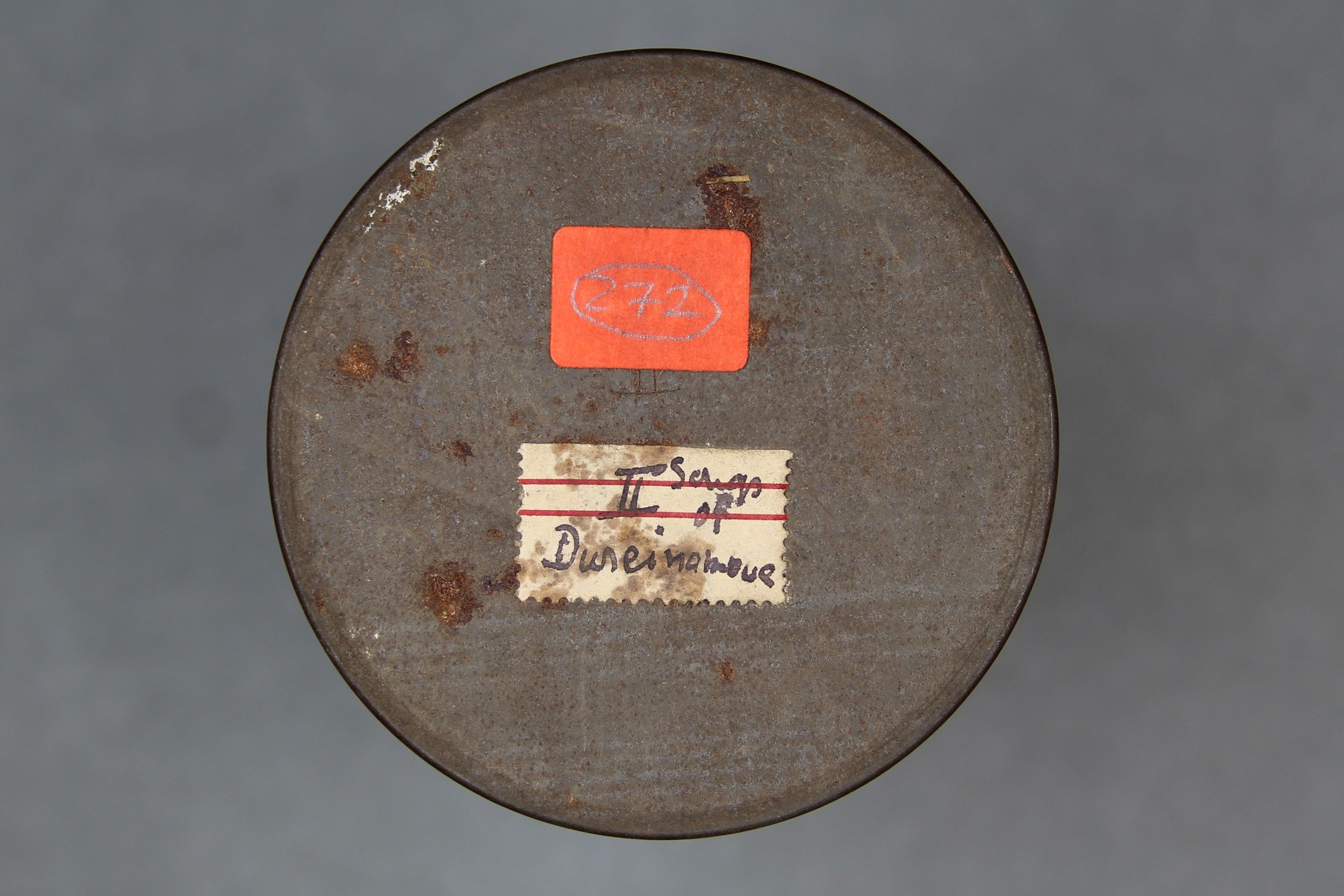 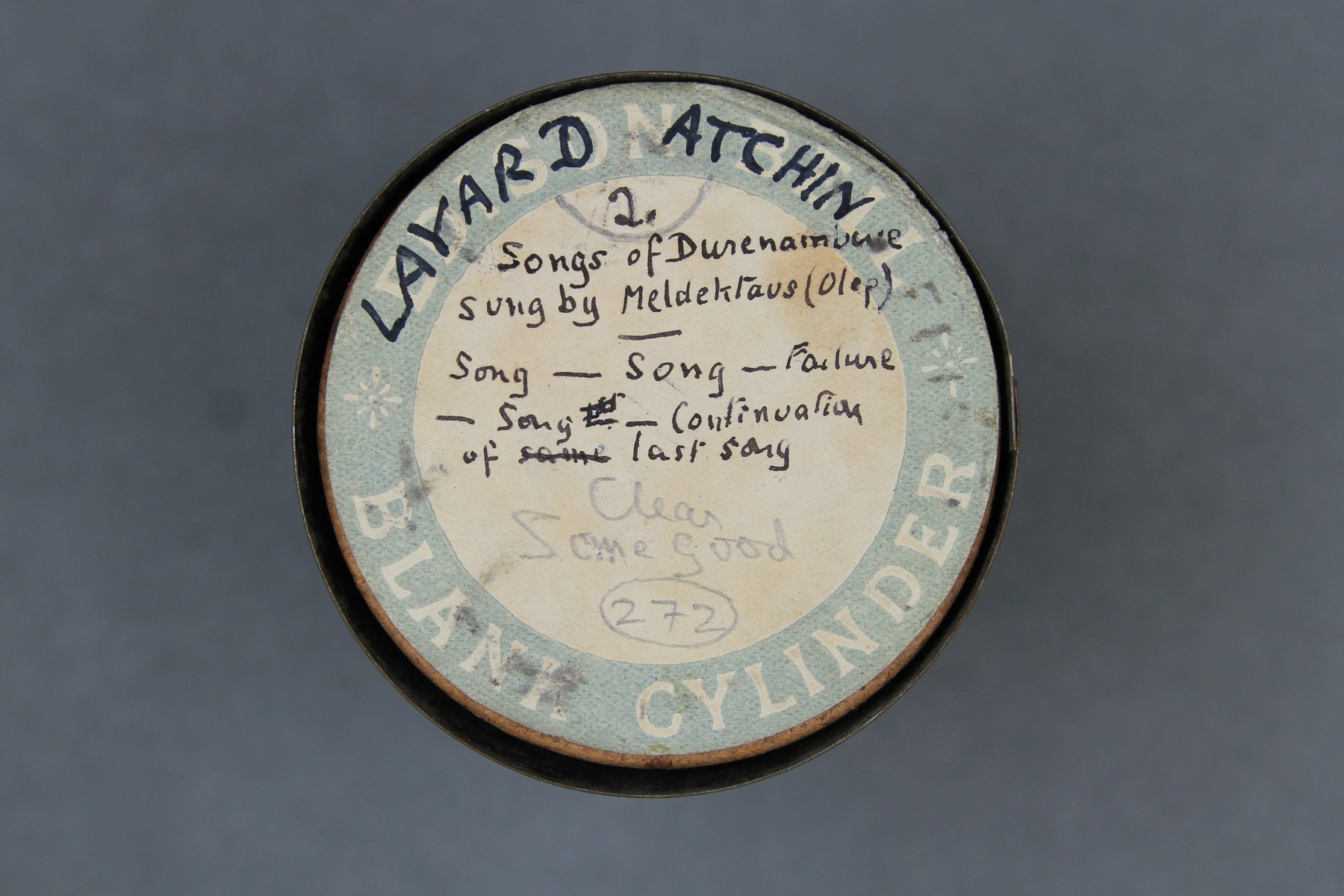     | Layard's fieldnotes are in the John Willoughby Layard papers (MSS 84) in the Special Collections & Archives of the University of California, San Diego. The music notes are compiled in a PDF titled ‘Unpublished Atchin book: “Folk Songs”: Annotated music books, with words and music, hand-written and typed notes, translations.’ from box 47, folder 8. This PDF is held by the British Library. | ||||||
| C177/273 | Songs from Welewelen | Unidentified (mixed chorus); unidentified (percussion) | Atchin, Malekula, New Hebrides Condominium (Vanuatu) | 28 September 1914 – 9 October 1915 | 1-4. Mixed vocal group accompanied by percussion. Songs from Welewelen / "dance along boat" / Olep & Pwetertsüs dancing / at Emil Parav. From Layard's fieldnotes (page 104): “Songs from WELEWELEN, “Boat consecration” Olep and Pweter-tsuts dancing at Emil Parav.” | Reasonable quality recording but weak signal and some surface noise due to cracked and bandaged cylinder. | Uripiv-Wala-Rano-Atchin | Field recordings | John Willoughby Layard, 1891-1974 | 4'46" | John Layard, 1914-1915 | Brown wax cylinder | John Layard 1914 Atchin, New Hebrides Cylinder Collection | British Library | 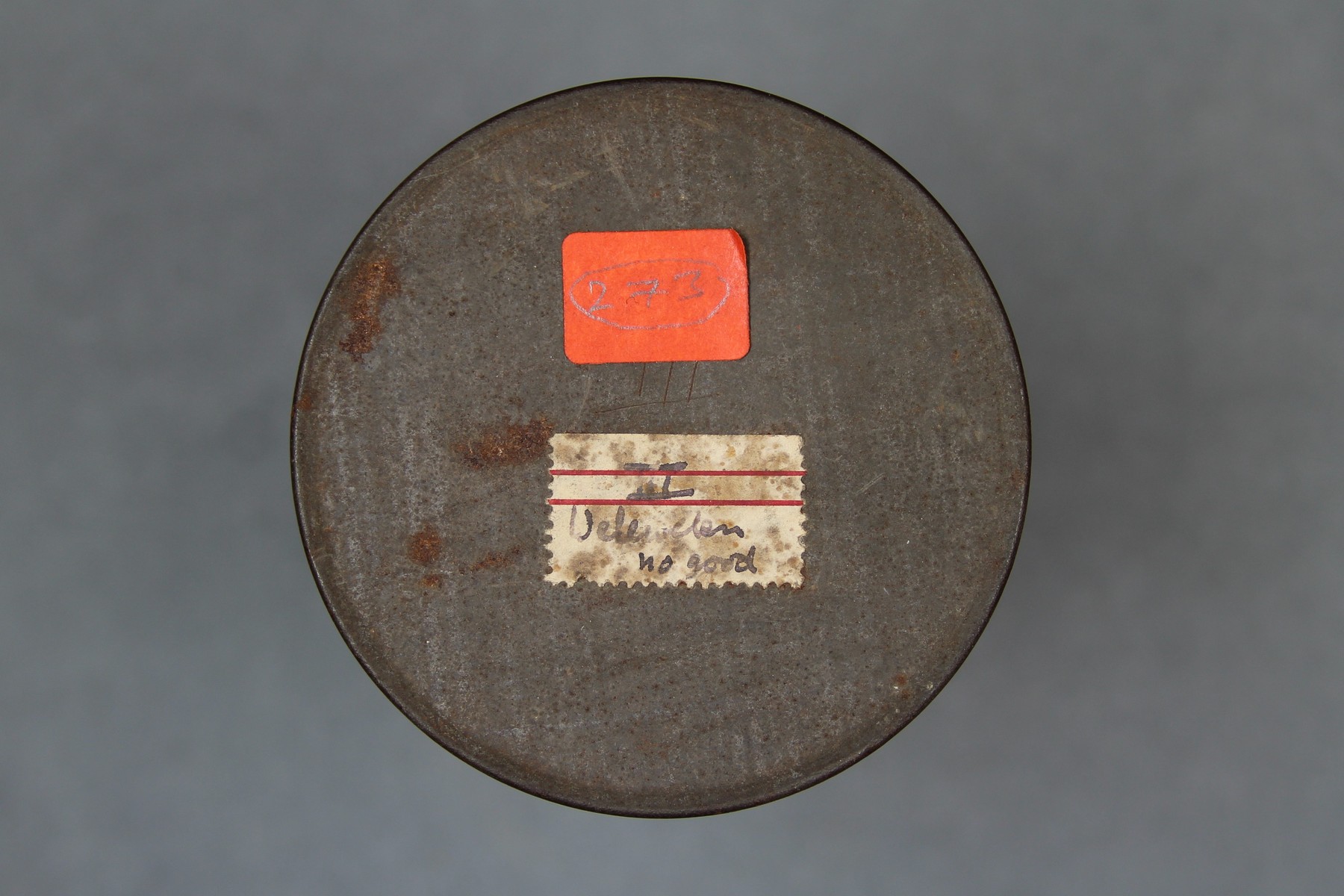      | Layard's fieldnotes are in the John Willoughby Layard papers (MSS 84) in the Special Collections & Archives of the University of California, San Diego. The music notes are compiled in a PDF titled ‘Unpublished Atchin book: “Folk Songs”: Annotated music books, with words and music, hand-written and typed notes, translations.’ from box 47, folder 8. This PDF is held by the British Library. | ||||||
| C177/274 | Songs in honour of Meldeksale | Unidentified (singer, male) | Atchin, Malekula, New Hebrides Condominium (Vanuatu) | 28 September 1914 – 9 October 1915 | 1-2. Unaccompanied male vocal solo. 1) Meldeksale songs / 2) Meldekwasengawül / (broken in middle). From Layard's fieldnotes (page 104): “Songs in honour of Melteg-sale (Fieldnote p.212) 1. Melteg-sale-ronge 2. Melteg-wa-sangawül (broken in middle)” | Reasonable quality recording but with deep rumble throughout. | Uripiv-Wala-Rano-Atchin | Field recordings | John Willoughby Layard, 1891-1974 | 8'00" | John Layard, 1914-1915 | Brown wax cylinder | John Layard 1914 Atchin, New Hebrides Cylinder Collection | British Library |       | Layard's fieldnotes are in the John Willoughby Layard papers (MSS 84) in the Special Collections & Archives of the University of California, San Diego. The music notes are compiled in a PDF titled ‘Unpublished Atchin book: “Folk Songs”: Annotated music books, with words and music, hand-written and typed notes, translations.’ from box 47, folder 8. This PDF is held by the British Library. | ||||||
| C177/275 | Tunes on Nambu marur | Meltektaus (pipes); Melteris (pipes); Meldeksongurei (pipes) | Atchin, Malekula, New Hebrides Condominium (Vanuatu) | 28 September 1914 – 9 October 1915 | 1-4. Ref note followed by musical instrument. Recording technician noted "some kind of very breathy aerophone". 1.) Dureinambwe, played by Meltektaus / 2.) Welalen, p. by Melteris / 3.) Naleng nato, / 4.) Selven (bilong Maki) / 3 & 4 played by / Meldeksongurei. From Layard's fieldnotes (page 104): "Tunes on Na-mbu marur (open pipes) 1. Durei-na-mbwe, played by Melteg-taus. VI 2. Welalen, played by Mal-teres. 3. Na-leng Na-to, played by Melteg-tsung-wurei. 4. Seluen (belong Maki), " " " " ." Nambu Marur – na-mbu\marur ‘open musical pipes’ (Capell and Layard 1980:119)". | Reasonable quality recording but with very weak signal and surface noise. | Uripiv-Wala-Rano-Atchin | Field recordings | John Willoughby Layard, 1891-1974 | 5'54" | John Layard, 1914-1915 | Brown wax cylinder | John Layard 1914 Atchin, New Hebrides Cylinder Collection | British Library | 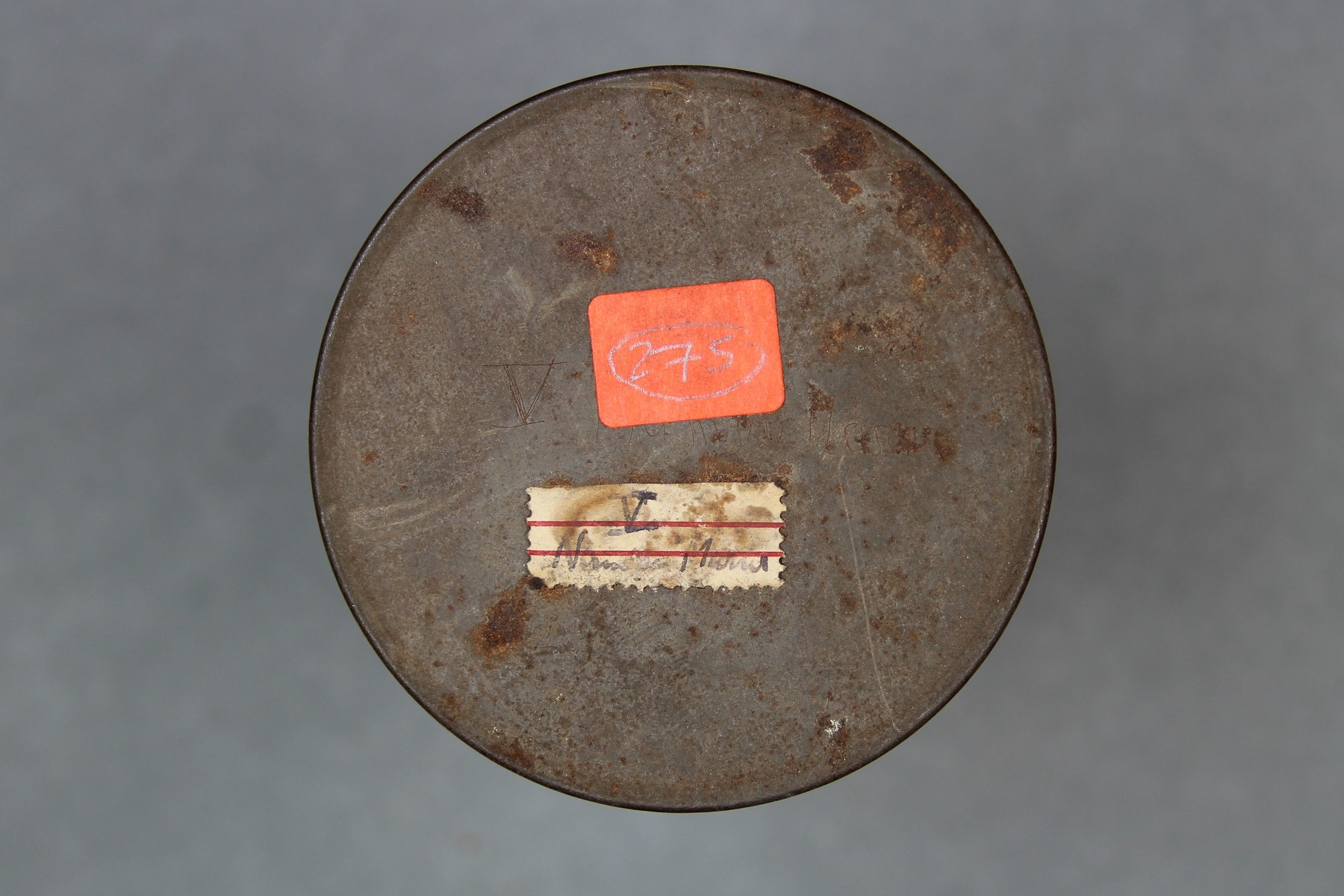 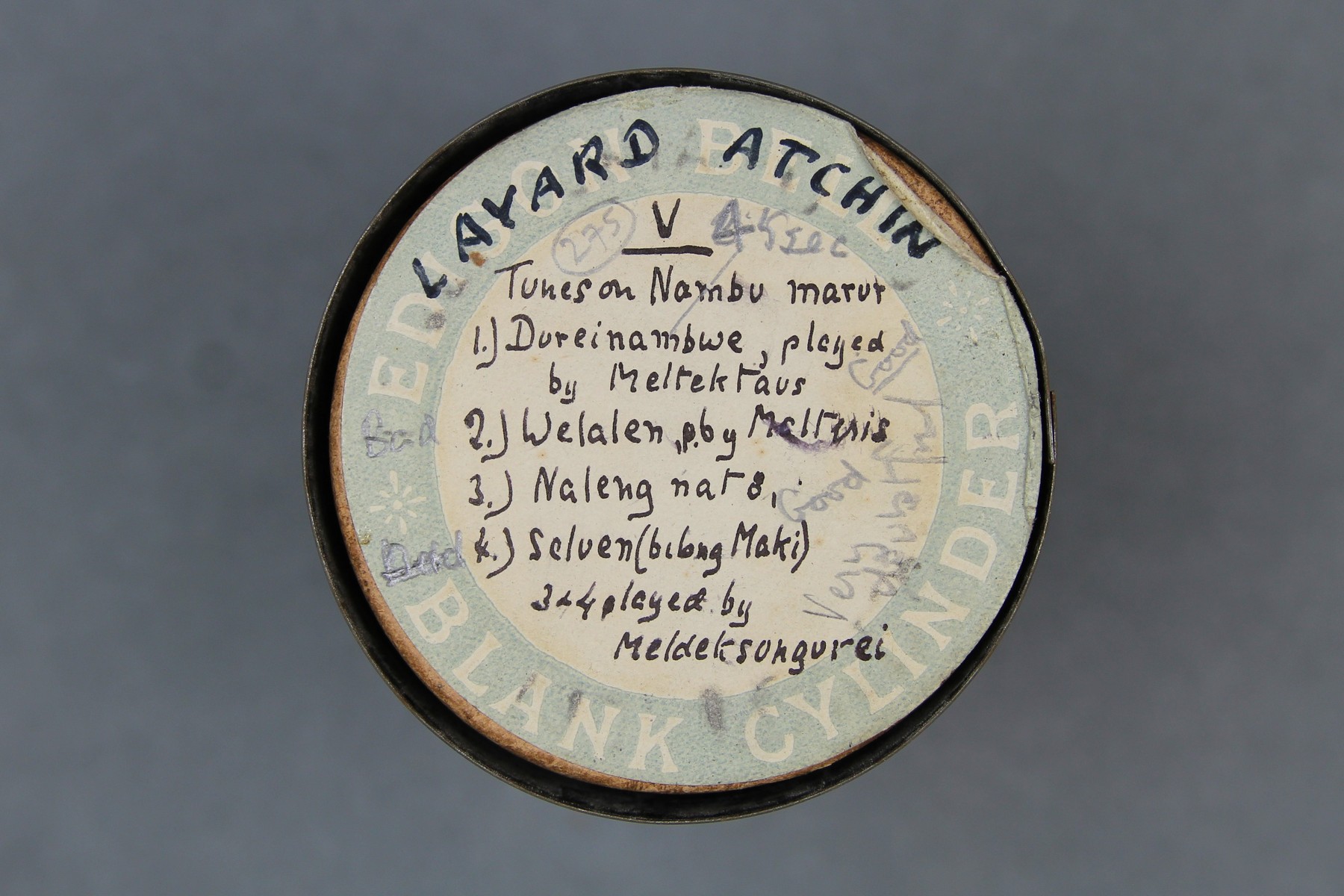     | Layard's fieldnotes are in the John Willoughby Layard papers (MSS 84) in the Special Collections & Archives of the University of California, San Diego. The music notes are compiled in a PDF titled ‘Unpublished Atchin book: “Folk Songs”: Annotated music books, with words and music, hand-written and typed notes, translations.’ from box 47, folder 8. This PDF is held by the British Library. | ||||||
| C177/276 | Songs taken at Dureinambwe, Emil Marur [1] | Unidentified (mixed chorus) | Atchin, Malekula, New Hebrides Condominium (Vanuatu) | 28 September 1914 – 9 October 1915 | 1-5. Unaccompanied mixed vocal group. From Layard's fieldnotes (page 104): “Songs taken at DUREI-NA-MBWE, at Emil Marur” | Poor quality recording with fluctuating speeds and 'cutter bounce' resulting in rumbling noise. | Uripiv-Wala-Rano-Atchin | Field recordings | John Willoughby Layard, 1891-1974 | 4'58" | John Layard, 1914-1915 | Brown wax cylinder | John Layard 1914 Atchin, New Hebrides Cylinder Collection | British Library | 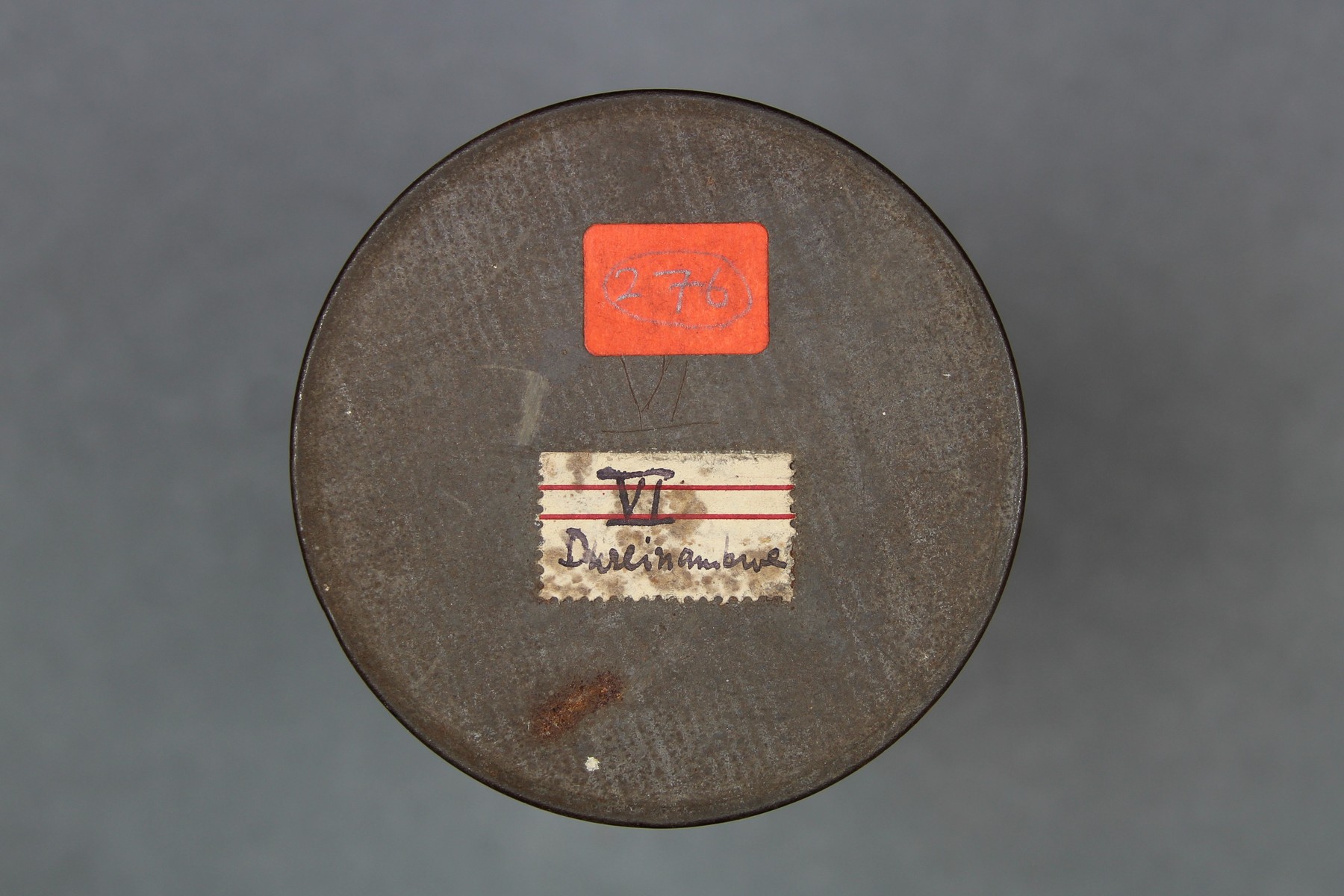 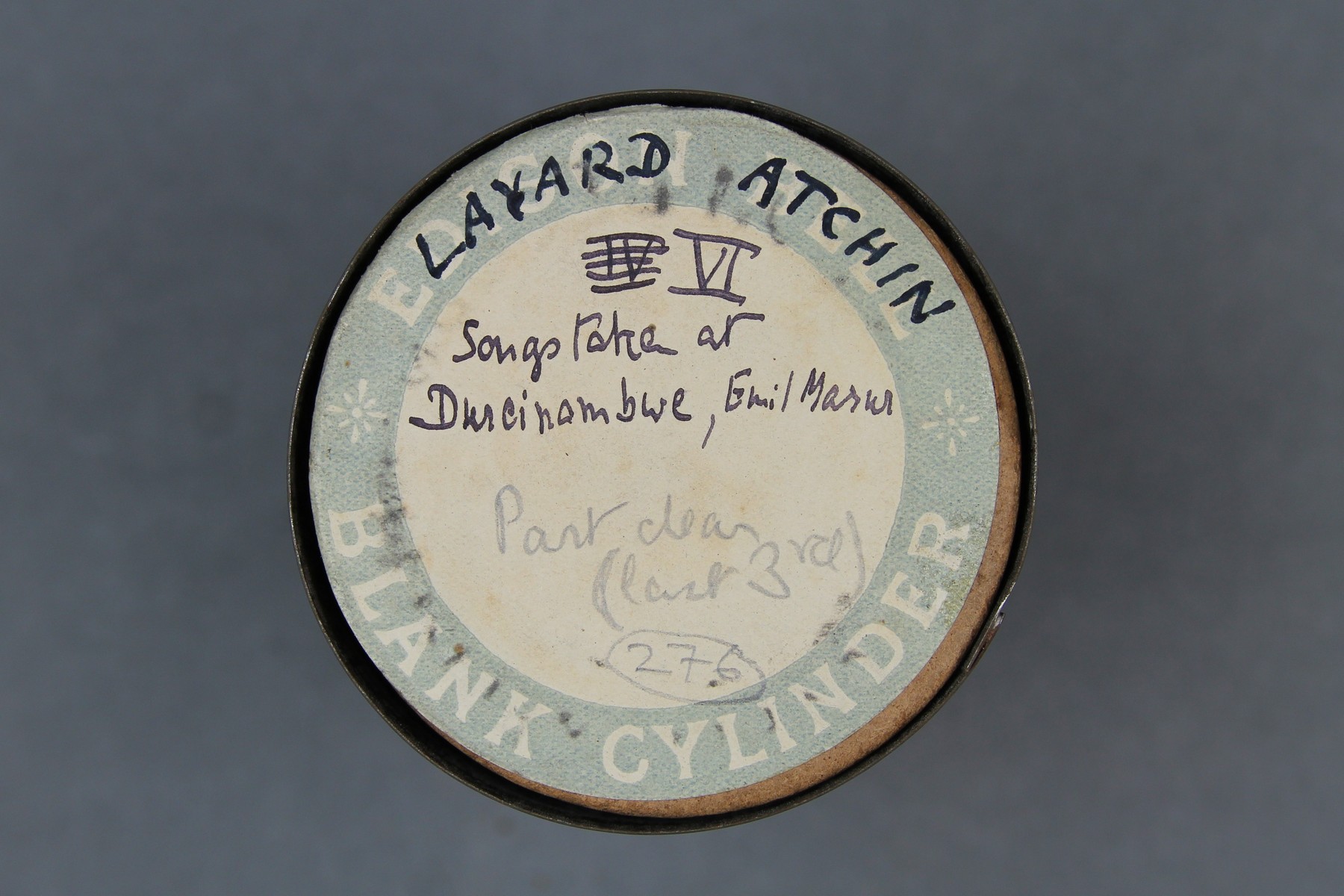     | Layard's fieldnotes are in the John Willoughby Layard papers (MSS 84) in the Special Collections & Archives of the University of California, San Diego. The music notes are compiled in a PDF titled ‘Unpublished Atchin book: “Folk Songs”: Annotated music books, with words and music, hand-written and typed notes, translations.’ from box 47, folder 8. This PDF is held by the British Library. | ||||||
| C177/277 | Songs taken at Dureinambwe, Emil Marur [2] | Unidentified (mixed chorus) | Atchin, Malekula, New Hebrides Condominium (Vanuatu) | 28 September 1914 – 9 October 1915 | 1-6. Mixed vocal group. From Layard's fieldnotes (page 104): “Songs taken at DUREI-NA-MBWE, at Emil Marur, spoilt by beating of feet on ground” | Poor quality recording due to cutter bounce. | Uripiv-Wala-Rano-Atchin | Field recordings | John Willoughby Layard, 1891-1974 | 3'12" | John Layard, 1914-1915 | Brown wax cylinder | John Layard 1914 Atchin, New Hebrides Cylinder Collection | British Library |       | Layard's fieldnotes are in the John Willoughby Layard papers (MSS 84) in the Special Collections & Archives of the University of California, San Diego. The music notes are compiled in a PDF titled ‘Unpublished Atchin book: “Folk Songs”: Annotated music books, with words and music, hand-written and typed notes, translations.’ from box 47, folder 8. This PDF is held by the British Library. | ||||||
| C177/278 | Tavü signals [1] | Meldekwaru (conch shell trumpet) | Atchin, Malekula, New Hebrides Condominium (Vanuatu) | 28 September 1914 – 9 October 1915 | 1-2. Ref note followed by unaccompanied wind instrument playing on one note. 1. For Mererpekes / 2. For Naru. Blown by Meldekwaru. Tavü - conch shell trumpet, conch shell blown at ceremonial exchange of tuskers. (Capell and Layard 1980:143) From Layard's fieldnotes (page 104): “Tavü (Conch Shell Trumpet) signals, blown by Melteg-waru 1. Circle-tusker 2. Curved tusker” | Reasonable quality recording with strong signal. | Uripiv-Wala-Rano-Atchin | Field recordings | John Willoughby Layard, 1891-1974 | 4'32" | John Layard, 1914-1915 | Brown wax cylinder | John Layard 1914 Atchin, New Hebrides Cylinder Collection | British Library |  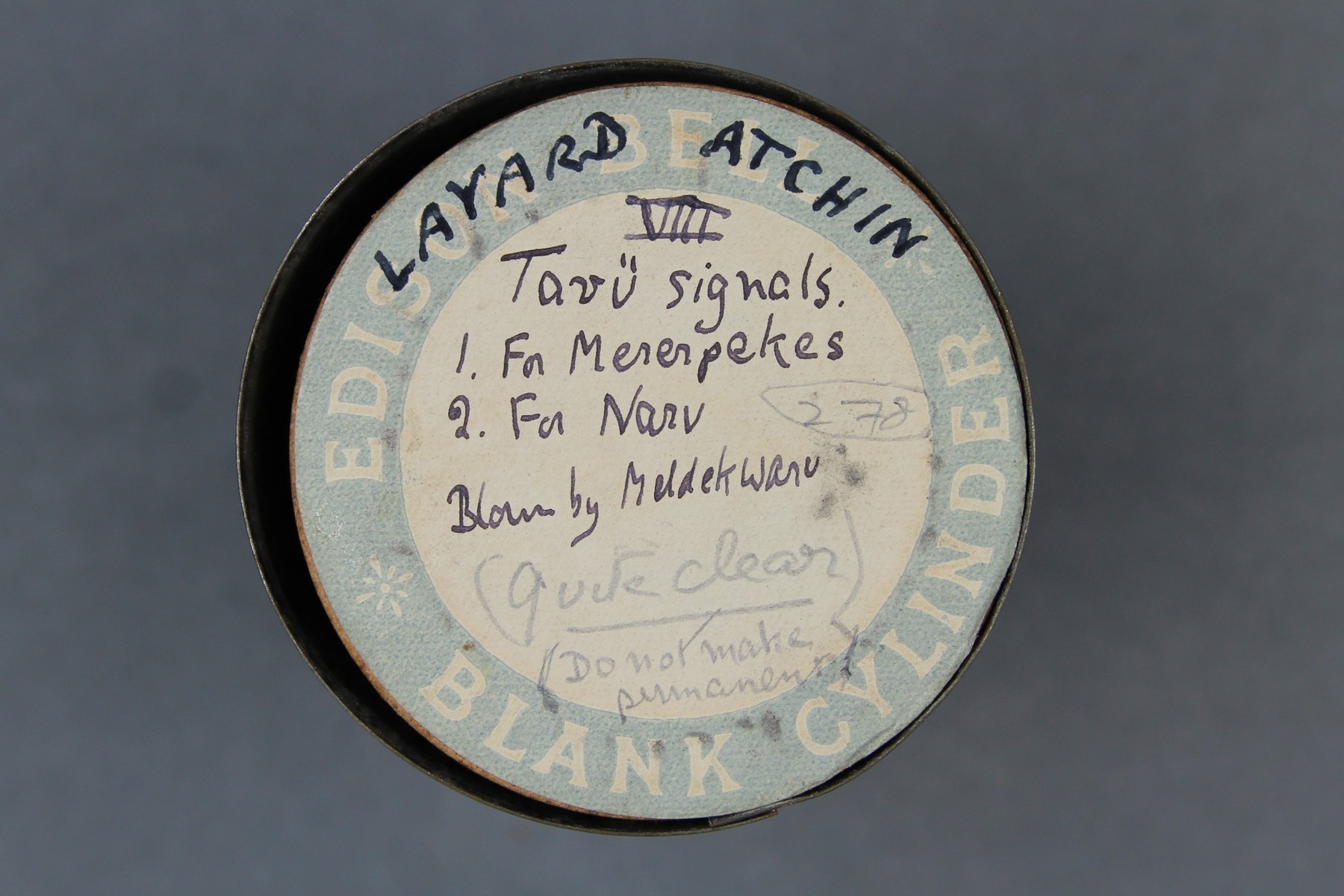     | Layard's fieldnotes are in the John Willoughby Layard papers (MSS 84) in the Special Collections & Archives of the University of California, San Diego. The music notes are compiled in a PDF titled ‘Unpublished Atchin book: “Folk Songs”: Annotated music books, with words and music, hand-written and typed notes, translations.’ from box 47, folder 8. This PDF is held by the British Library. | ||||||
| C177/279 | Tavü signals [2] | Meltegwaru (conch shell trumpet); Meldeksale (conch shell trumpet) | Atchin, Malekula, New Hebrides Condominium (Vanuatu) | 28 September 1914 – 9 October 1915 | 1-2. Unaccompanied aerophone. 1. For Mererpekes, by / Meltegwaru, / 2. For Niwara, by / Meldeksale. Tavü - conch shell trumpet, conch shell blown at ceremonial exchange of tuskers. (Capell and Layard 1980:143) From Layard's fieldnotes (page 104): “Tavü (Conch Shell Trumpet) signals 1. Circle-tusker, played by Melteg-waru 2. Re-entrant tusker, played by Melteg-sale.” | Good quality recording with strong signal and little surface noise. | Uripiv-Wala-Rano-Atchin | Field recordings | John Willoughby Layard, 1891-1974 | 3'51" | John Layard, 1914-1915 | Brown wax cylinder | John Layard 1914 Atchin, New Hebrides Cylinder Collection | British Library |  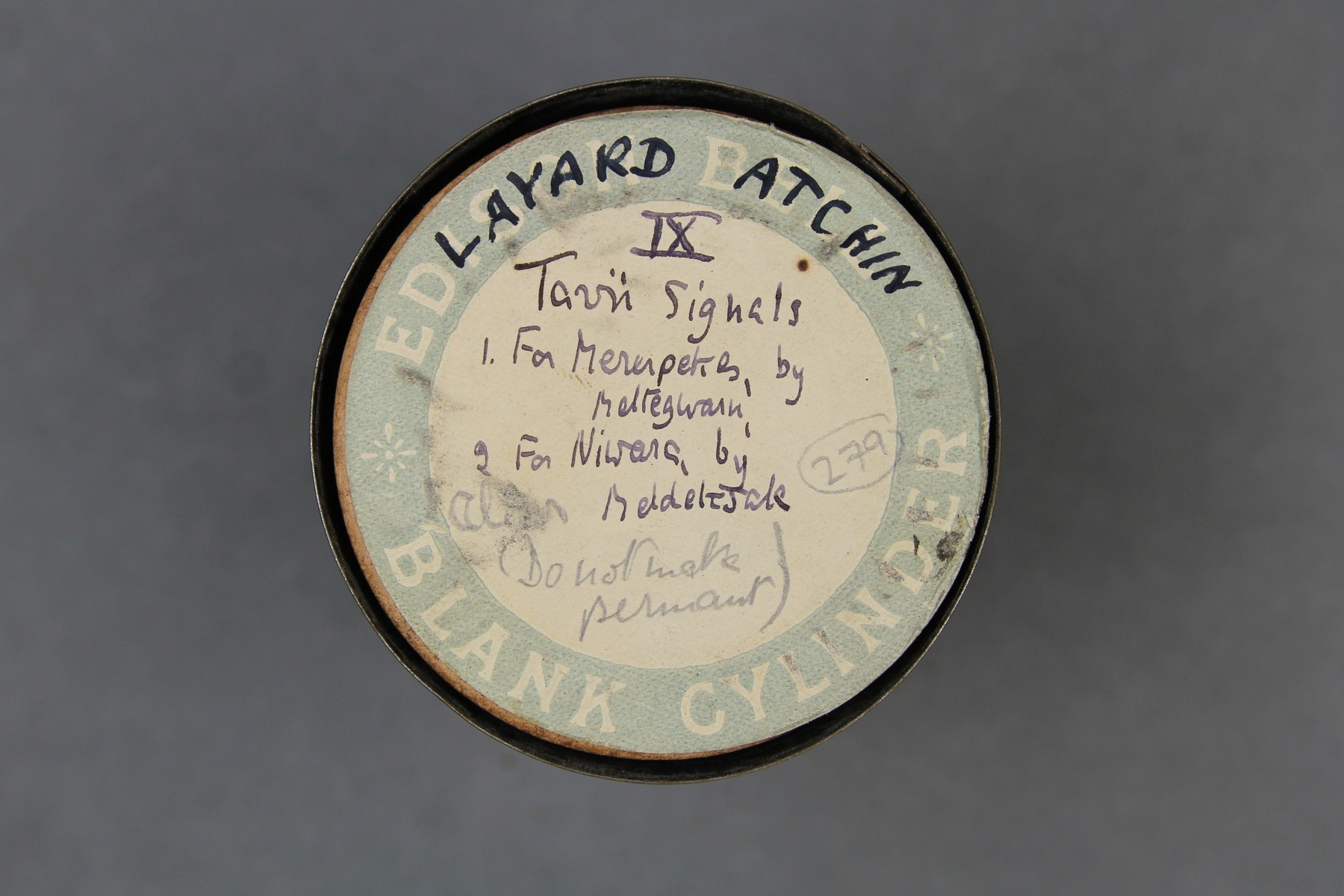     | Layard's fieldnotes are in the John Willoughby Layard papers (MSS 84) in the Special Collections & Archives of the University of California, San Diego. The music notes are compiled in a PDF titled ‘Unpublished Atchin book: “Folk Songs”: Annotated music books, with words and music, hand-written and typed notes, translations.’ from box 47, folder 8. This PDF is held by the British Library. | ||||||
| C177/280 | Tavü signals [3] | Meldekwaru (conch shell trumpet) | Atchin, Malekula, New Hebrides Condominium (Vanuatu) | 28 September 1914 – 9 October 1915 | 1-2. Unaccompanied wind instrument. 1. For Tama͜uẹr, by / 2. For Mererpekes, by Meldekwaru. Tavü - conch shell trumpet, conch shell blown at ceremonial exchange of tuskers. (Capell and Layard 1980:143) From Layard's fieldnotes (page 104): “Tavü (Conch Shell Trumpet) signals 1. Castrated re-entrant-tusker, played by ? 2. Circle-tusker, played by Melteg-waru.” | Good quality recording with strong signal and little surface noise. | Uripiv-Wala-Rano-Atchin | Field recordings | John Willoughby Layard, 1891-1974 | 4'08" | John Layard, 1914-1915 | Brown wax cylinder | John Layard 1914 Atchin, New Hebrides Cylinder Collection | British Library |       | Layard's fieldnotes are in the John Willoughby Layard papers (MSS 84) in the Special Collections & Archives of the University of California, San Diego. The music notes are compiled in a PDF titled ‘Unpublished Atchin book: “Folk Songs”: Annotated music books, with words and music, hand-written and typed notes, translations.’ from box 47, folder 8. This PDF is held by the British Library. | ||||||
| C177/281 | Drums beaten at Palu-ulen (morning) Amal / olep | Unidentified (percussion); unidentified (spoken, male) | Atchin, Malekula, New Hebrides Condominium (Vanuatu) | 28 September 1914 – 9 October 1915 | 1. Drumming, male voices audible towards end of recording. Nambwe Noso̊s for / first 135 seconds, then / nambwe rildralin. mbwe - gong ; nambwe - gong-signal (Capell and Layard 1980:119) From Layard's fieldnotes (page 17): "Begins with na-mbwe no-sos. After 45 secs. it dies down and stops, and then begins again. This is the signal for the dancers to leave MEL-NAMUL (where they stop to give the gong- beaters time to get ready). Nambwe nosos is beaten all the time the dancers are running across the dancing-ground (see p.444-) ar wela parav. After 135 secs. from the beginning it changes to nambwe rildralen, which is the gong for bureburine nosos, when the dances return in a deep serpentine course to the pal-pal. The record ends in the middle of this. When they reach the pal-pal they sing WELEN-NI-MBEK songs, and the gongs are played for WELEN-NI-MBEK." From Layard's fieldnotes (page 104) “Gongs beaten at Palu-ulen in the morning at Olep Na-mbwe nosȯs for first 135 seconds. Then Na-mbwe rildralen.“ | Good quality recording with clear signal and little surface noise. | Uripiv-Wala-Rano-Atchin | Field recordings | John Willoughby Layard, 1891-1974 | 6'17" | John Layard, 1914-1915 | Brown wax cylinder | John Layard 1914 Atchin, New Hebrides Cylinder Collection | British Library | 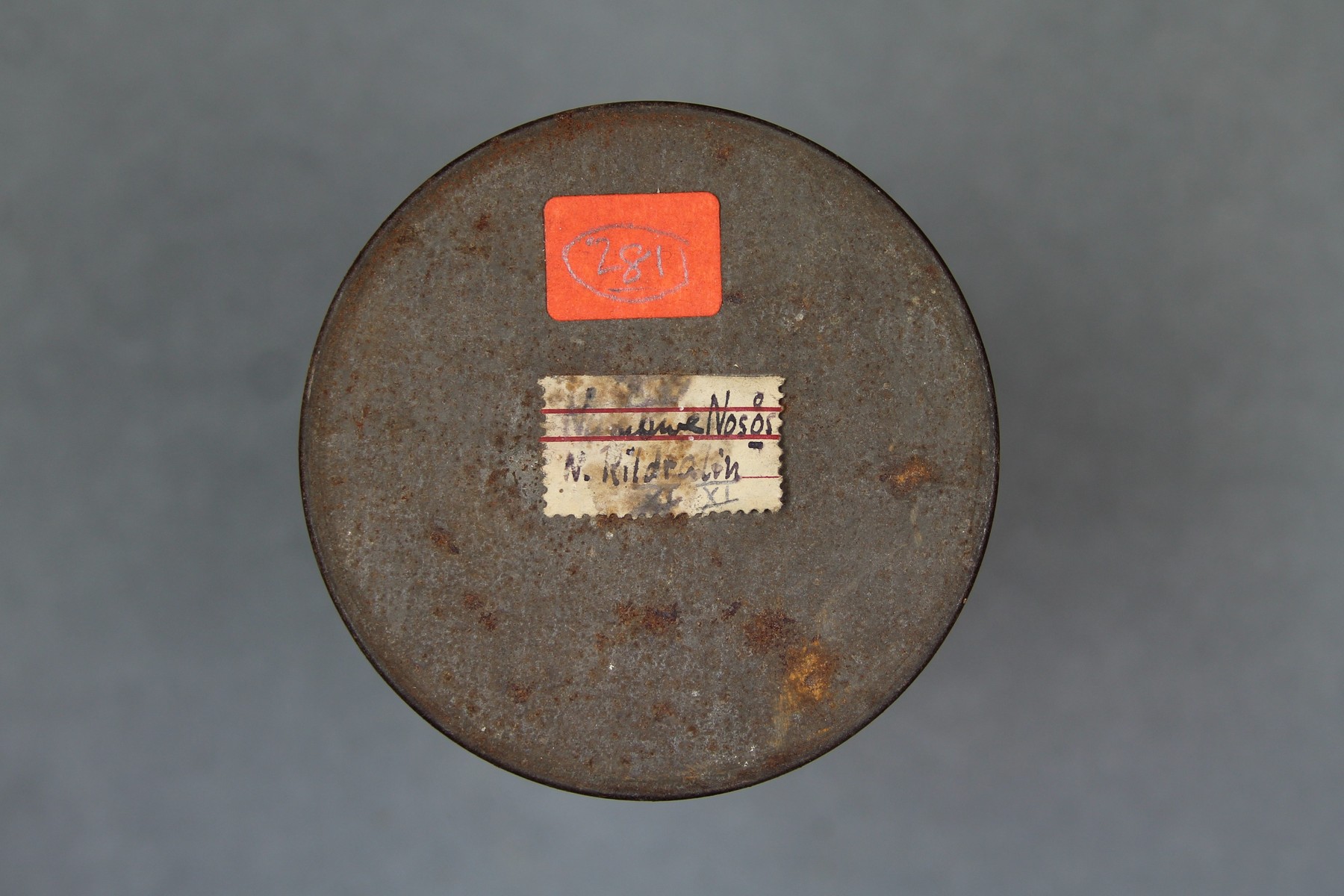 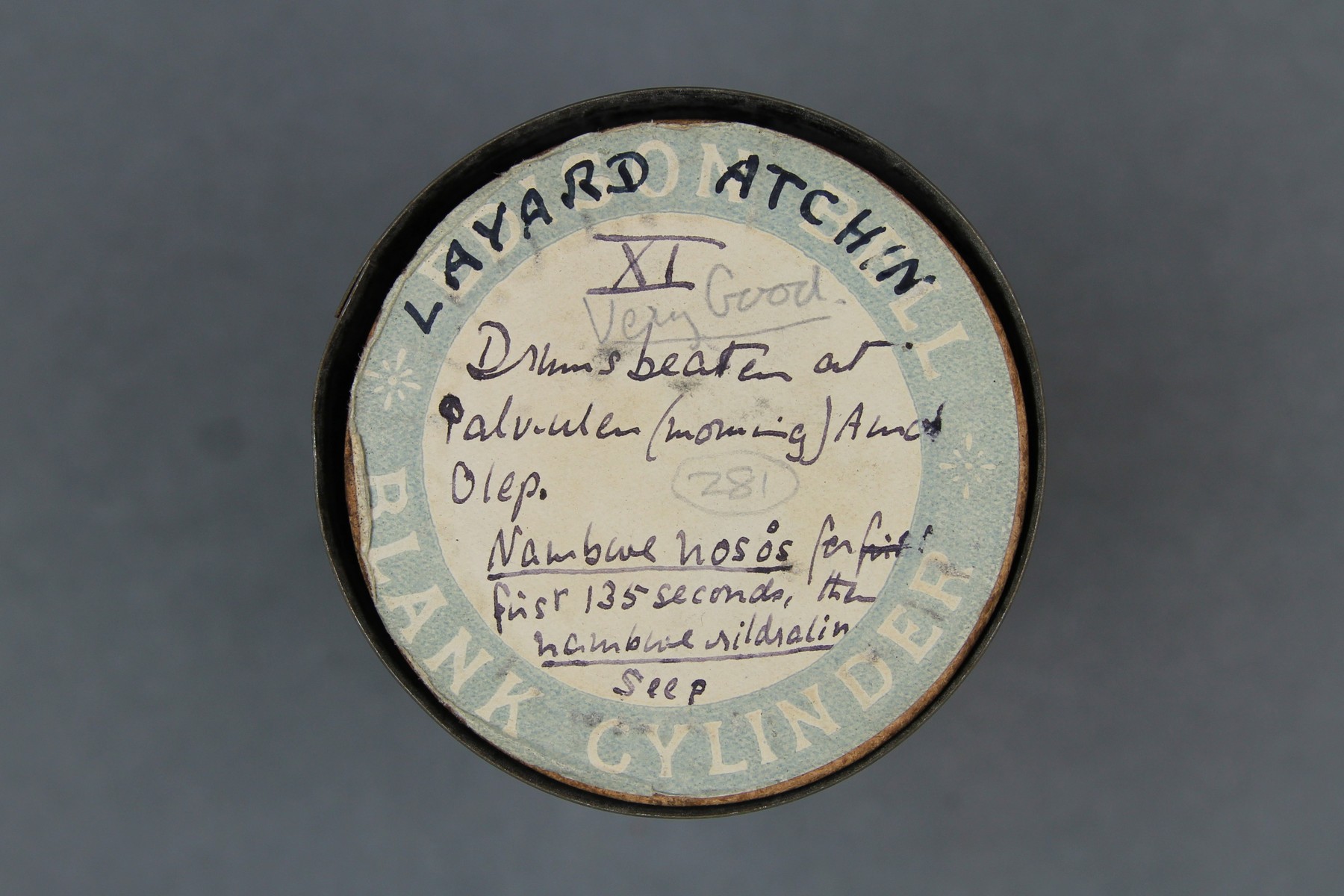     | Layard's fieldnotes are in the John Willoughby Layard papers (MSS 84) in the Special Collections & Archives of the University of California, San Diego. The music notes are compiled in a PDF titled ‘Unpublished Atchin book: “Folk Songs”: Annotated music books, with words and music, hand-written and typed notes, translations.’ from box 47, folder 8. This PDF is held by the British Library. | ||||||
| C177/282 | Drumming | Unidentified (percussion) | Atchin, Malekula, New Hebrides Condominium (Vanuatu) | 28 September 1914 – 9 October 1915 | 1-3. Ref note followed by drumming. 1. Welenimbek (twice over) / 2. Welenimbek (once) / 3. Maki: Selven (drums for) / called Ewala & Etur. From Layard’s fieldnotes (page 104): “WELENIMBEK (twice over) WELENIMBEK (once) MAKI:- SELUEN (gongs for, called e wala and e tur" | Uripiv-Wala-Rano-Atchin | Field recordings | John Willoughby Layard, 1891-1974 | 4'44" | John Layard, 1914-1915 | Brown wax cylinder | John Layard 1914 Atchin, New Hebrides Cylinder Collection | British Library | 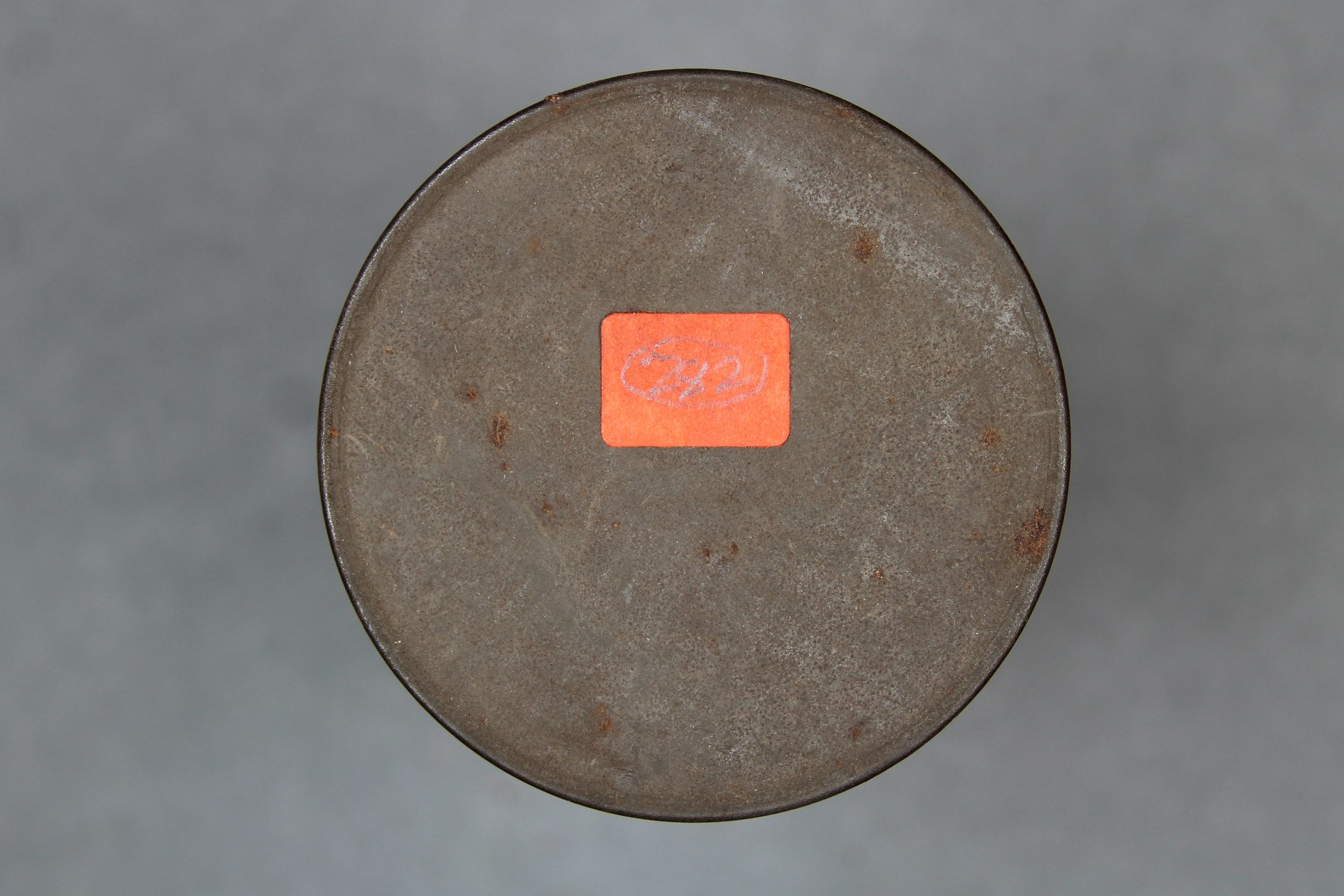 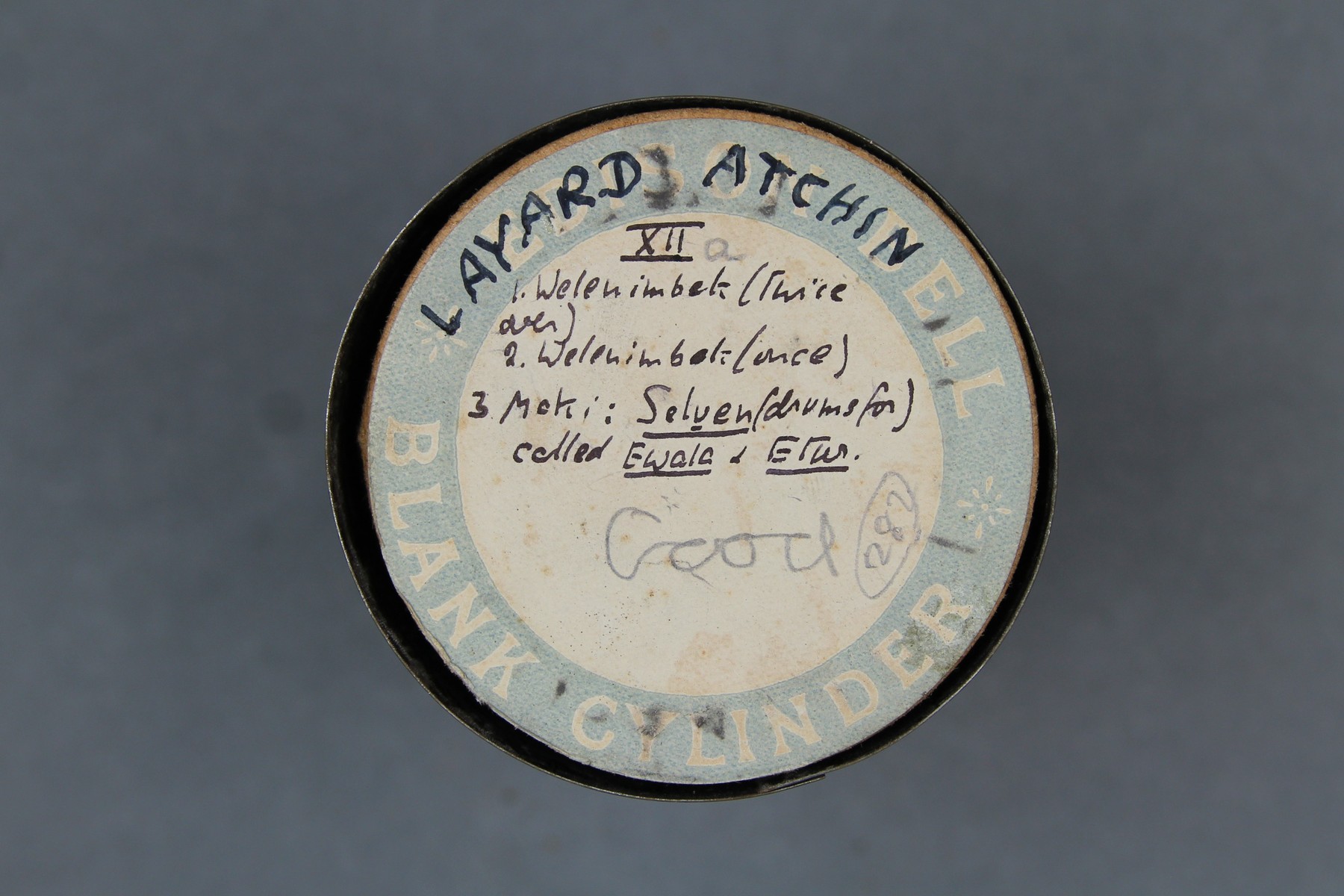     | Layard's fieldnotes are in the John Willoughby Layard papers (MSS 84) in the Special Collections & Archives of the University of California, San Diego. The music notes are compiled in a PDF titled ‘Unpublished Atchin book: “Folk Songs”: Annotated music books, with words and music, hand-written and typed notes, translations.’ from box 47, folder 8. This PDF is held by the British Library. | |||||||
| C177/283 | Songs of Welenimbek taken at Palu-ulen, Amal Olep | Unidentified (male chorus); unidentified (percussion) | Atchin, Malekula, New Hebrides Condominium (Vanuatu) | 28 September 1914 – 9 October 1915 | 1-2. Male vocal group with drumming accompaniment (in addition to the rhythmic thumping made by recording process). 1&2 Songs of Welenimbek / taken at Palu-ulen, Amal Olep. 2 Song + Gong. From Layard’s fieldnotes (page 104): “Songs of WELENIMBEK, taken at Palu-ulen at Olep” | Reasonable quality recording but with weak signal. | Uripiv-Wala-Rano-Atchin | Field recordings | John Willoughby Layard, 1891-1974 | 3'25" | John Layard, 1914-1915 | Brown wax cylinder | John Layard 1914 Atchin, New Hebrides Cylinder Collection | British Library | 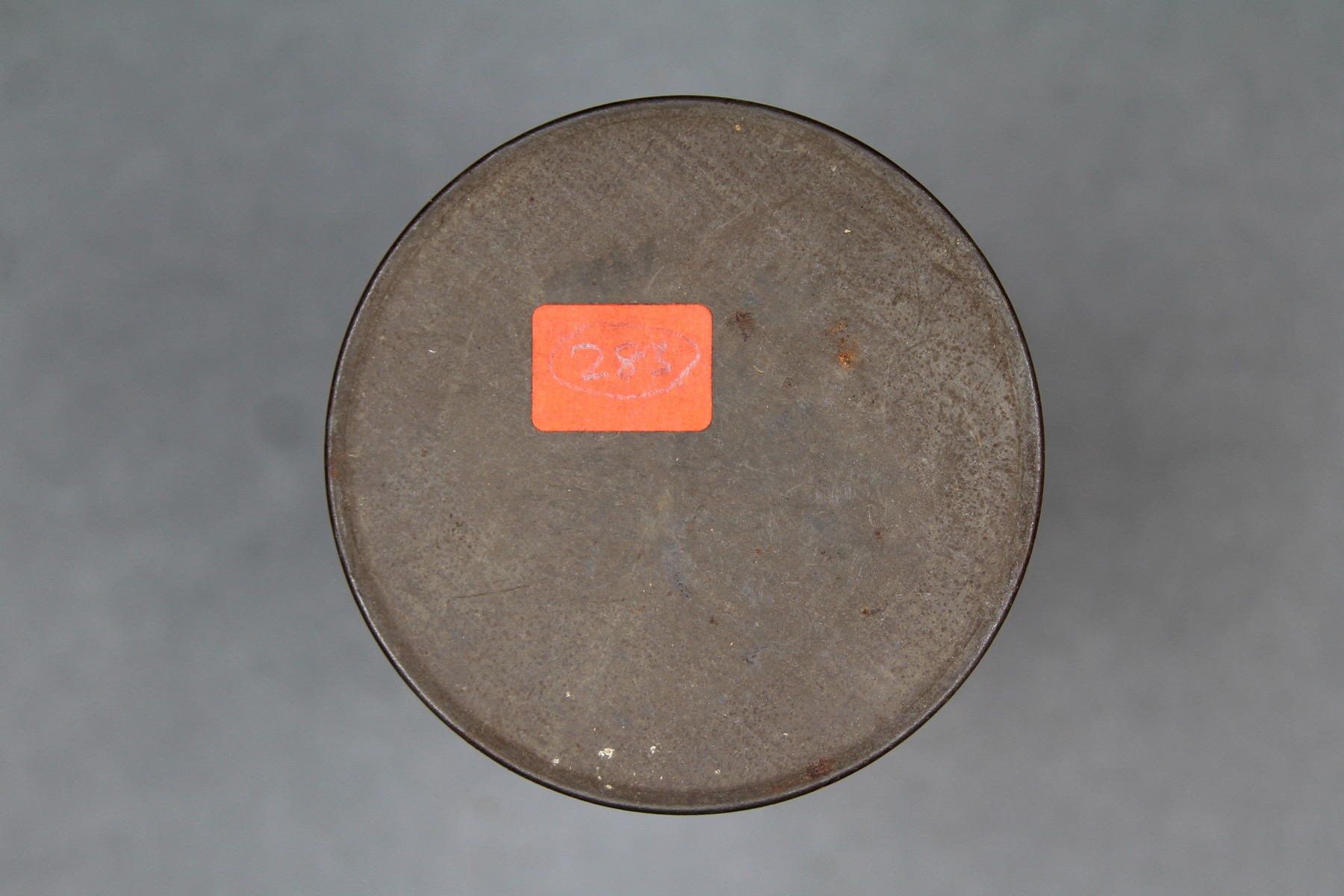 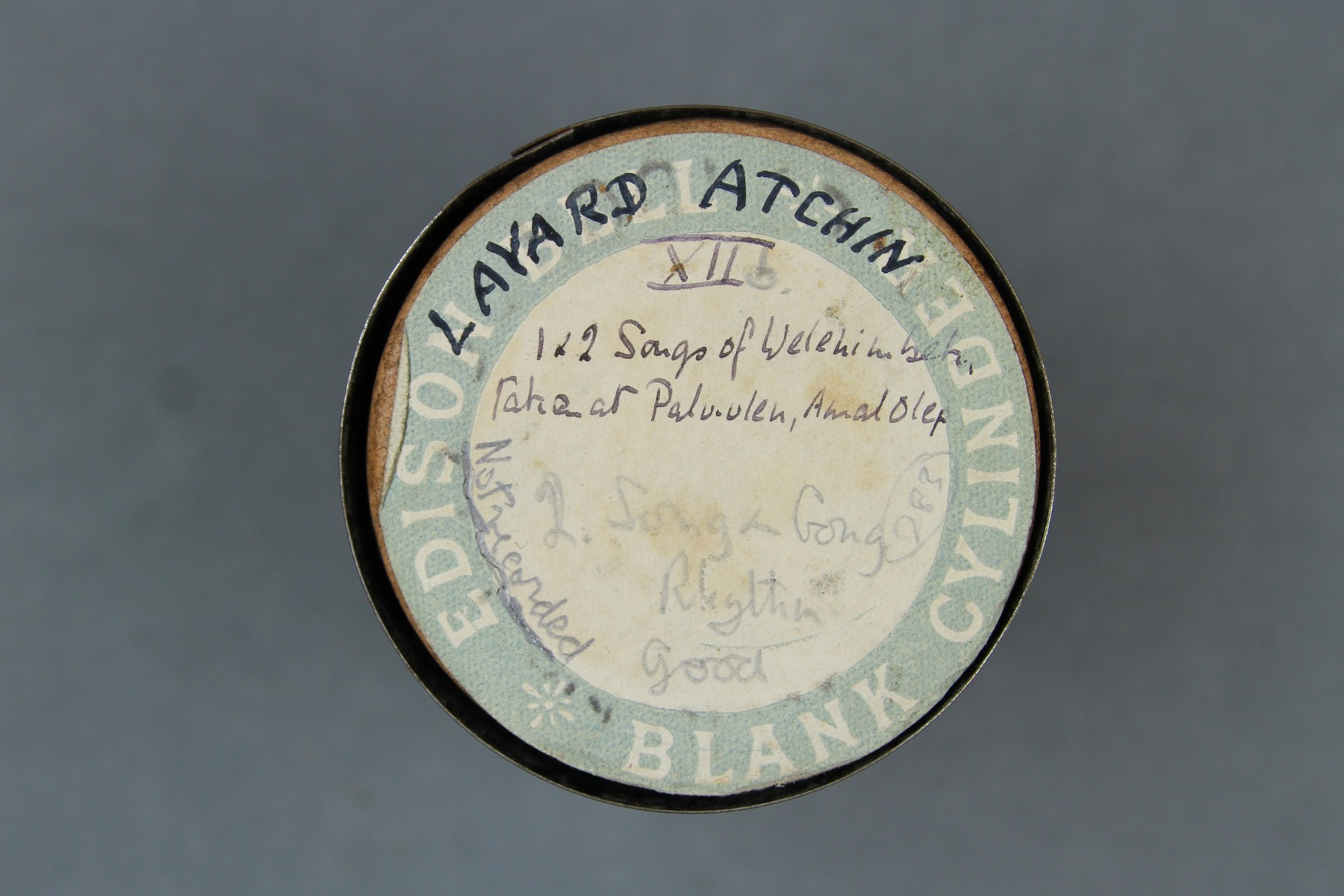     | Layard's fieldnotes are in the John Willoughby Layard papers (MSS 84) in the Special Collections & Archives of the University of California, San Diego. The music notes are compiled in a PDF titled ‘Unpublished Atchin book: “Folk Songs”: Annotated music books, with words and music, hand-written and typed notes, translations.’ from box 47, folder 8. This PDF is held by the British Library. | ||||||
| C177/284 | Drums for Maki | Unidentified (percussion) | Atchin, Malekula, New Hebrides Condominium (Vanuatu) | 28 September 1914 – 9 October 1915 | 1-3. Ref notes followed by drumming. 1. Ewala, then short pause / then Etur / 2. Nambwe Walain (beaten / during Narel) / 3. Maki emawun / (artev tavü) / 4. Nambwe epalpal (Pwetur) / (for a quarrel). mbwe - gong ; nambwe - gong-signal (Capell and Layard 1980:119) From Layard's fieldnotes (page 17): "Visitors approach. 30 secs. ar wala (dance with ne- Shul 40. secs. Back again 50. secs. ar wala. From Layard's fieldnotes (page 104) “Gongs for Maki: 1. e wala, then short pause, then e tur. } 2. na-mbwe walaim (beaten during na-rel) } 3. Maki e ma wun (ar tev tavü) } V 4. na-mbwe e pal-pal (for a quarrel) (on pwetur gong only)” 60. secs. Back again. 75.s “ ar wala. 85. “ Back again 105. “ Give ne-shul. 115. “ Gong stops" | Reasonable quality recording but with surface noise due to cracked and bandaged cylinder (the bandage may obscure a fourth track). | Uripiv-Wala-Rano-Atchin | Field recordings | John Willoughby Layard, 1891-1974 | 6'54" | John Layard, 1914-1915 | Brown wax cylinder | John Layard 1914 Atchin, New Hebrides Cylinder Collection | British Library | 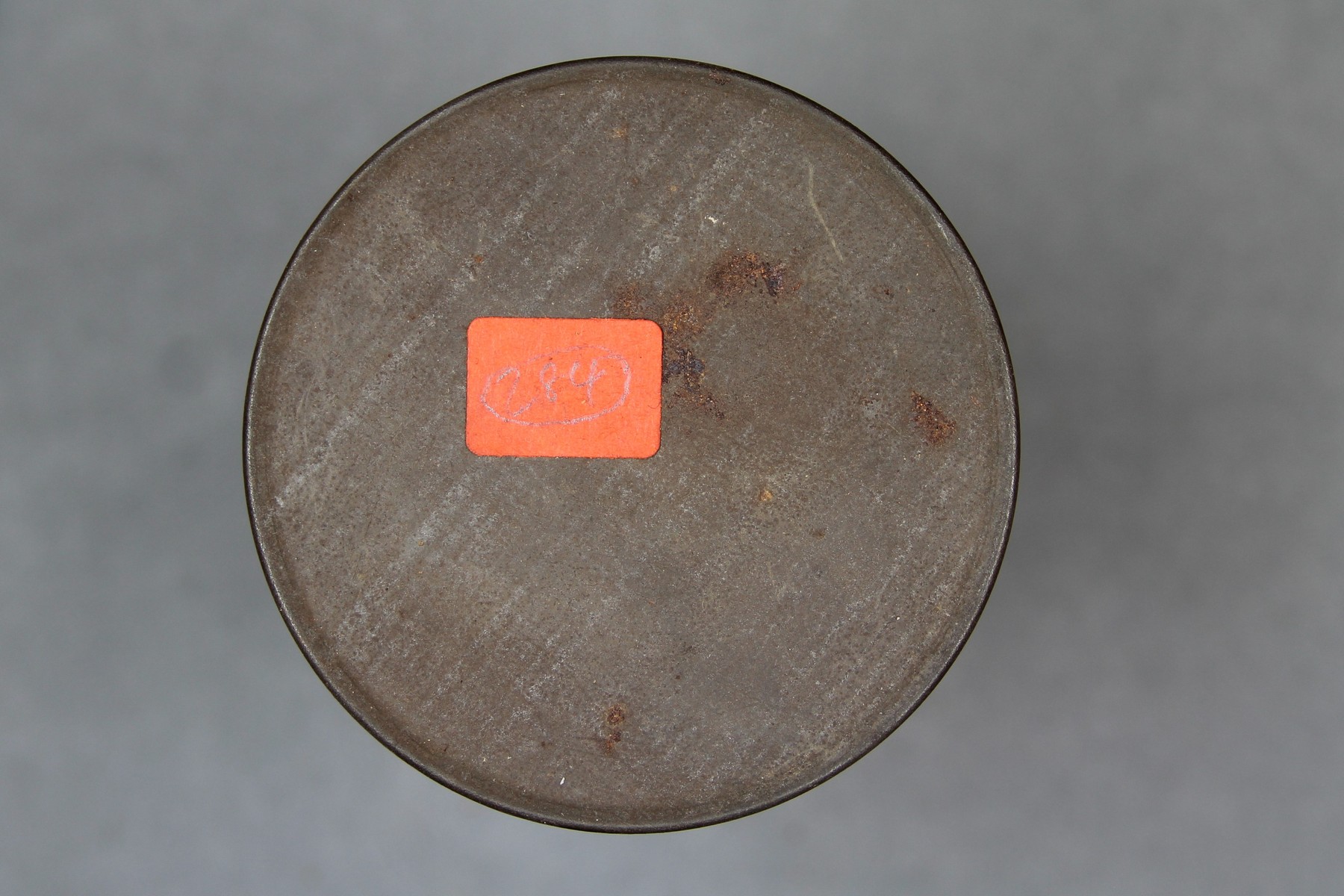      | Layard's fieldnotes are in the John Willoughby Layard papers (MSS 84) in the Special Collections & Archives of the University of California, San Diego. The music notes are compiled in a PDF titled ‘Unpublished Atchin book: “Folk Songs”: Annotated music books, with words and music, hand-written and typed notes, translations.’ from box 47, folder 8. This PDF is held by the British Library. | ||||||
| C177/285 | Nambwe Lui | Unidentified (percussion); unidentified (spoken, male) | Atchin, Malekula, New Hebrides Condominium (Vanuatu) | 28 September 1914 – 9 October 1915 | 1. Drumming, with male speech audible near end. From SAMI: "Probably a continuation of 'Drums for Maki' on C177/284?" mbwe - gong ; nambwe - gong-signal (Capell and Layard 1980:119) From Layard’s fieldnotes (page 104): “Na-mbwe Lui." | Good quality recording with clear signal and little surface noise. | Uripiv-Wala-Rano-Atchin | Field recordings | John Willoughby Layard, 1891-1974 | 4'49" | John Layard, 1914-1915 | Brown wax cylinder | John Layard 1914 Atchin, New Hebrides Cylinder Collection | British Library | 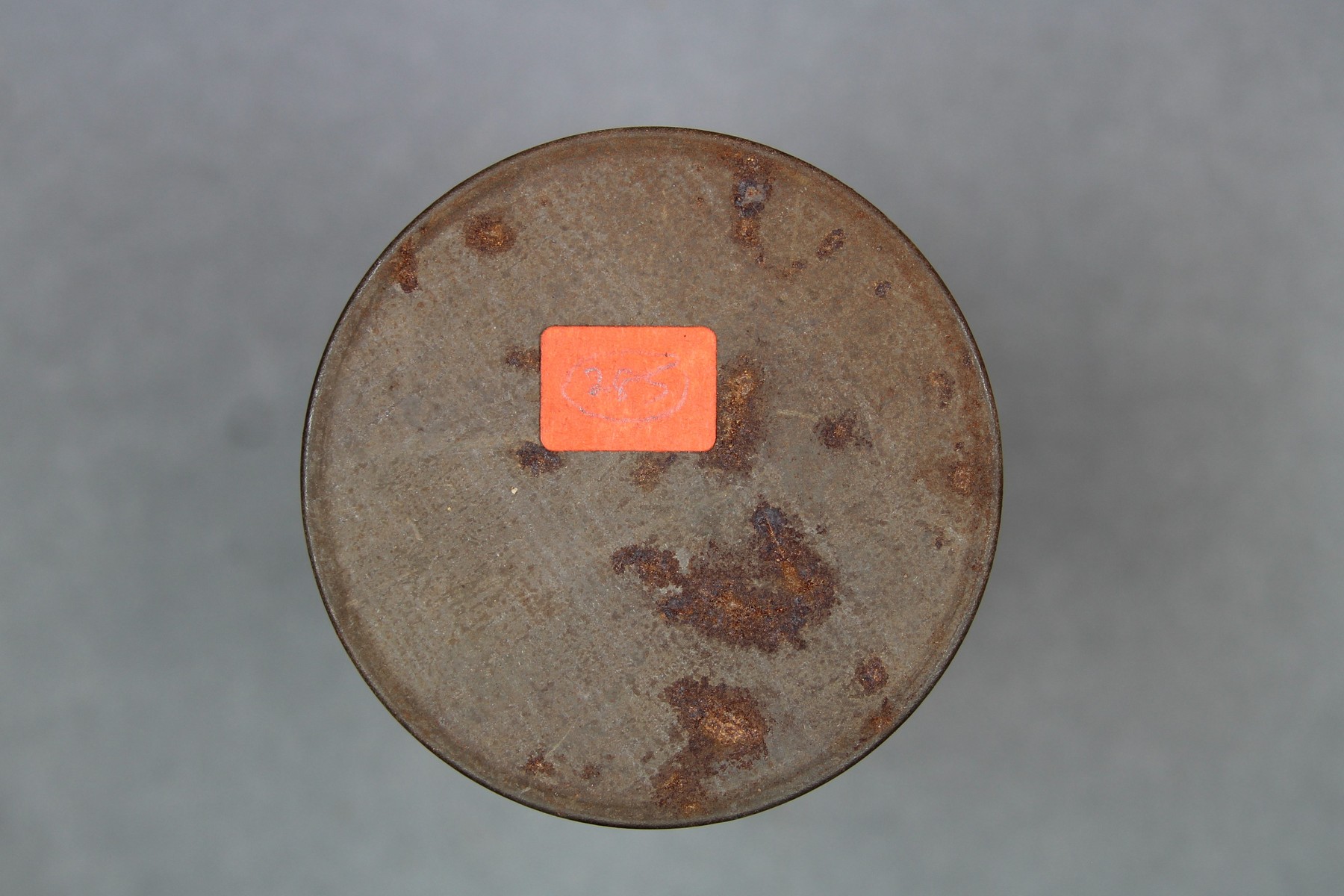 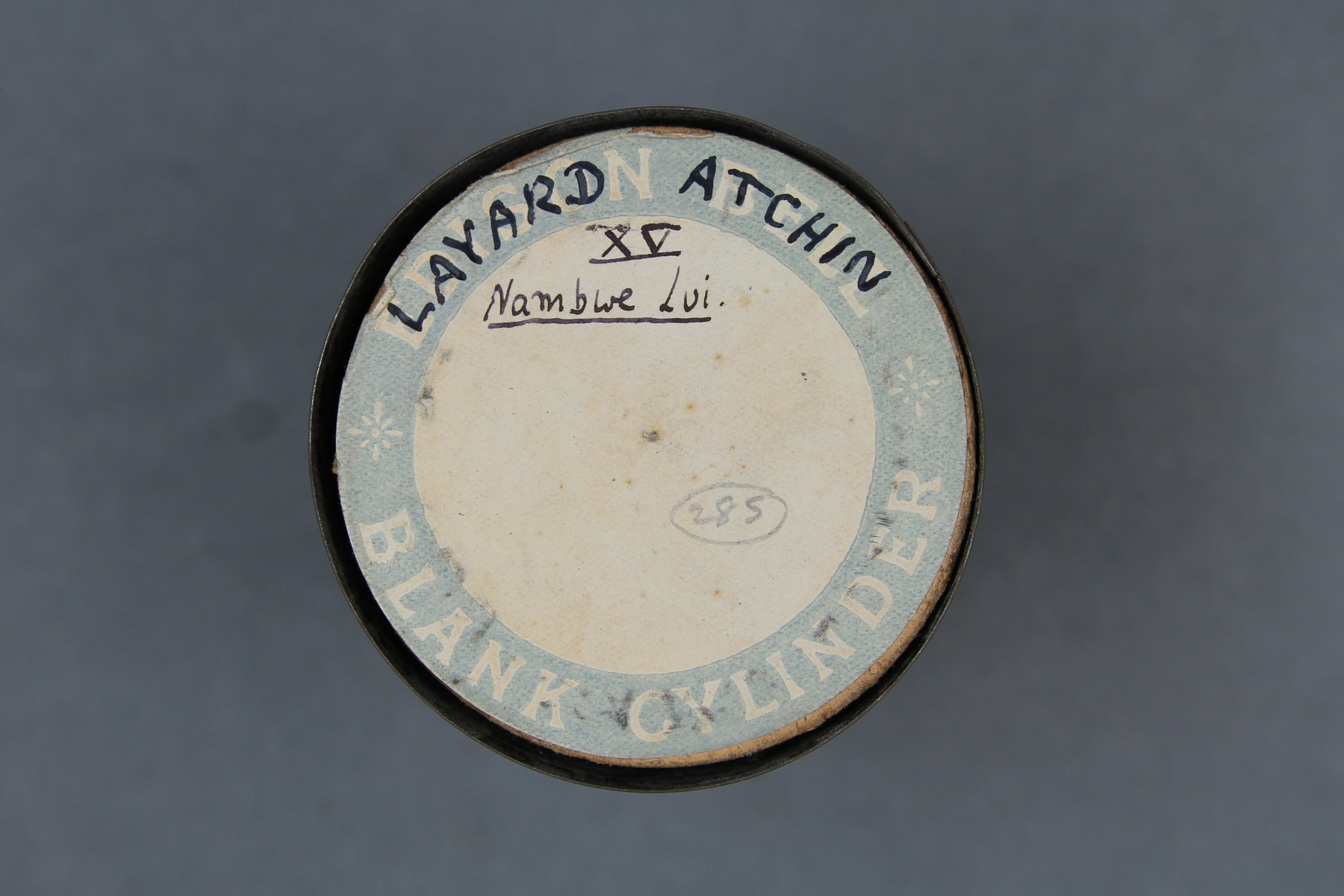     | Layard's fieldnotes are in the John Willoughby Layard papers (MSS 84) in the Special Collections & Archives of the University of California, San Diego. The music notes are compiled in a PDF titled ‘Unpublished Atchin book: “Folk Songs”: Annotated music books, with words and music, hand-written and typed notes, translations.’ from box 47, folder 8. This PDF is held by the British Library. | ||||||
| C177/286 | Nambwe Humanen | Unidentified (percussion); unidentified (spoken) | Atchin, Malekula, New Hebrides Condominium (Vanuatu) | 28 September 1914 – 9 October 1915 | 1-2. Drumming with male vocals. 1. Nambwe Humanen / 2. ditto, with song, / Orongdengdeng. mbwe - gong ; nambwe - gong-signal (Capell and Layard 1980:119) From Layard's fieldnotes (page 17): "Na-mbwe humanen. Tsoron only. This is played through the whole of the dance on field- note pp. 471-3. For approx.. first 80 secs., the couples arrive and the e hori comes and dances round his rokare. When the gongs are beaten fast they all shuffle away and jump (plainly marked by gongs). The gong stops and when it starts again they come back again, until at the fast beating they again shuffle away and he shuffles down the middle. At the end they jump again. The gong starts again and they come back and cast off, etc., and so away." From Layard's fieldnotes (page 105): “Na-mbwe Humanen Ditto, with song, orongdengdeng.” | Good quality recording with clear signal and little surface noise. | Uripiv-Wala-Rano-Atchin | Field recordings | John Willoughby Layard, 1891-1974 | 5'41" | John Layard, 1914-1915 | Brown wax cylinder | John Layard 1914 Atchin, New Hebrides Cylinder Collection | British Library | 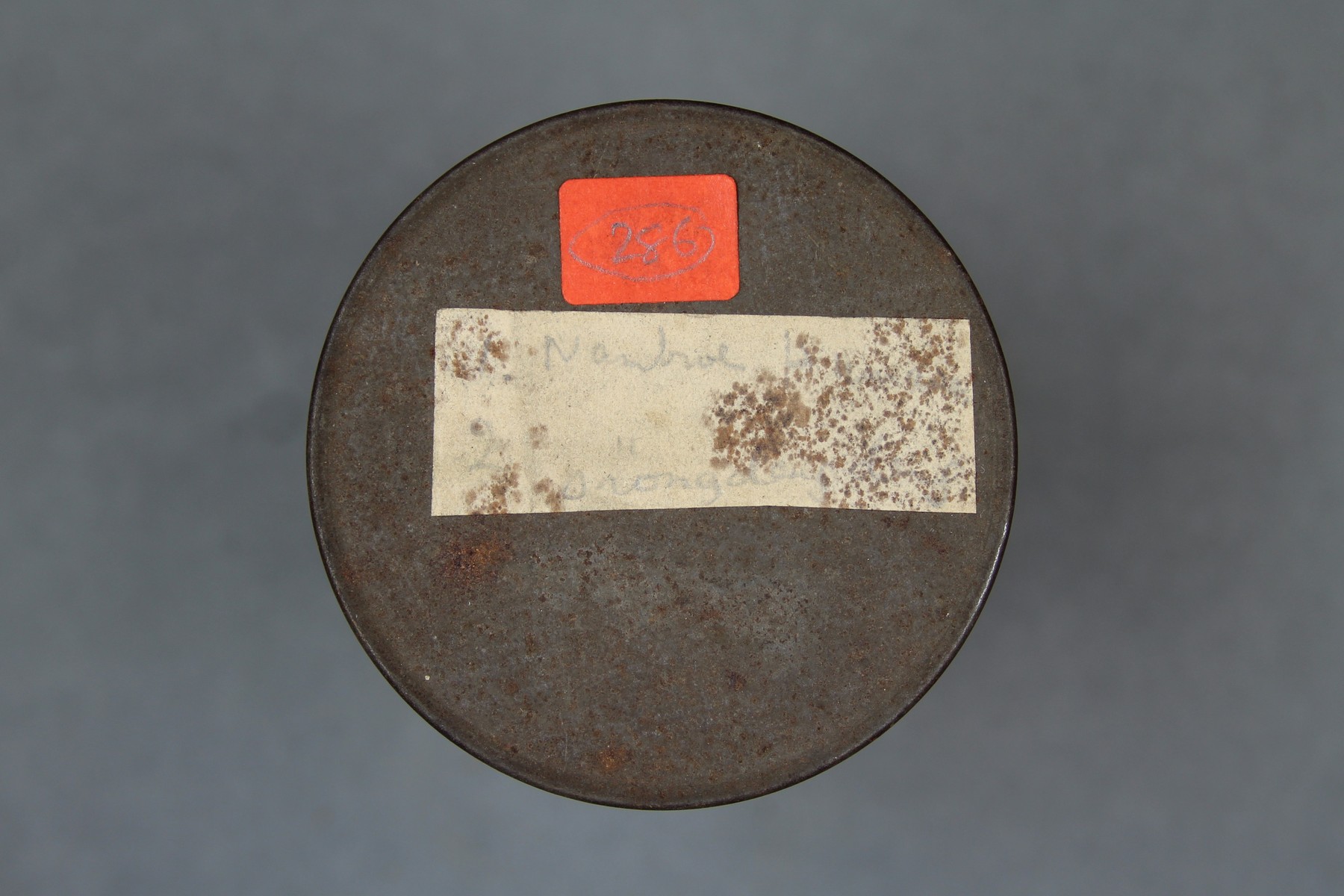 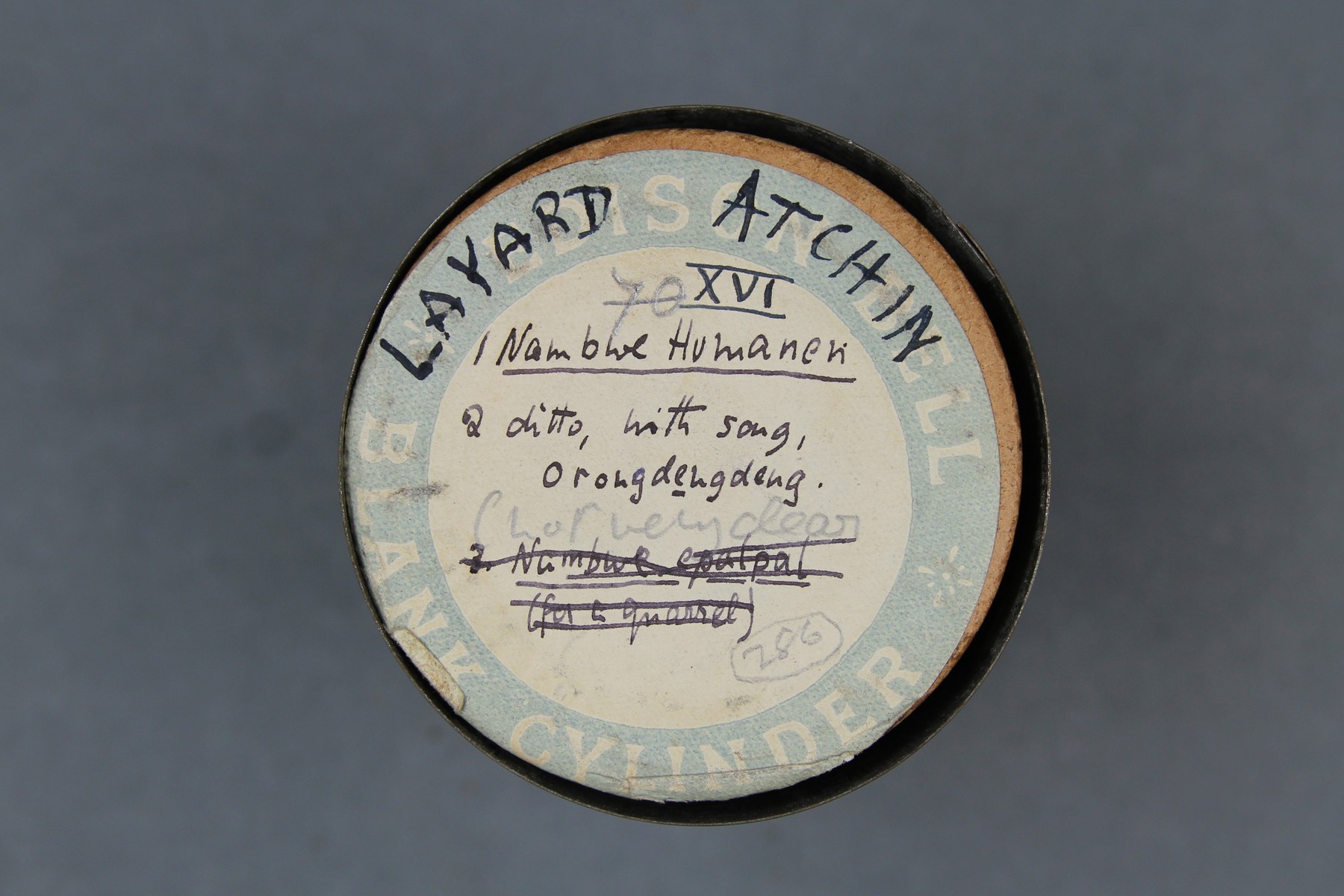     | Layard's fieldnotes are in the John Willoughby Layard papers (MSS 84) in the Special Collections & Archives of the University of California, San Diego. The music notes are compiled in a PDF titled ‘Unpublished Atchin book: “Folk Songs”: Annotated music books, with words and music, hand-written and typed notes, translations.’ from box 47, folder 8. This PDF is held by the British Library. | ||||||
| C177/287 | Nambwe noso̊s (twice) | Unidentified (percussion) | Atchin, Malekula, New Hebrides Condominium (Vanuatu) | 28 September 1914 – 9 October 1915 | 1-2. Drumming. From SAMI: "NB Ref note played on a reed instrument, thought to be A flat". mbwe - gong ; nambwe - gong-signal (Capell and Layard 1980:119) From Layard’s fieldnotes (page 19): “50. Na-mbwe no-sös. I. na-mbwe nosos. e bure-bure-ni - -------------c. ½ way through. Pause. e ter-ter hore. e ter-ter hore again.” | Good quality recording with clear signal and little surface noise. | Uripiv-Wala-Rano-Atchin | Field recordings | John Willoughby Layard, 1891-1974 | 6'07" | John Layard, 1914-1915 | Brown wax cylinder | John Layard 1914 Atchin, New Hebrides Cylinder Collection | British Library | 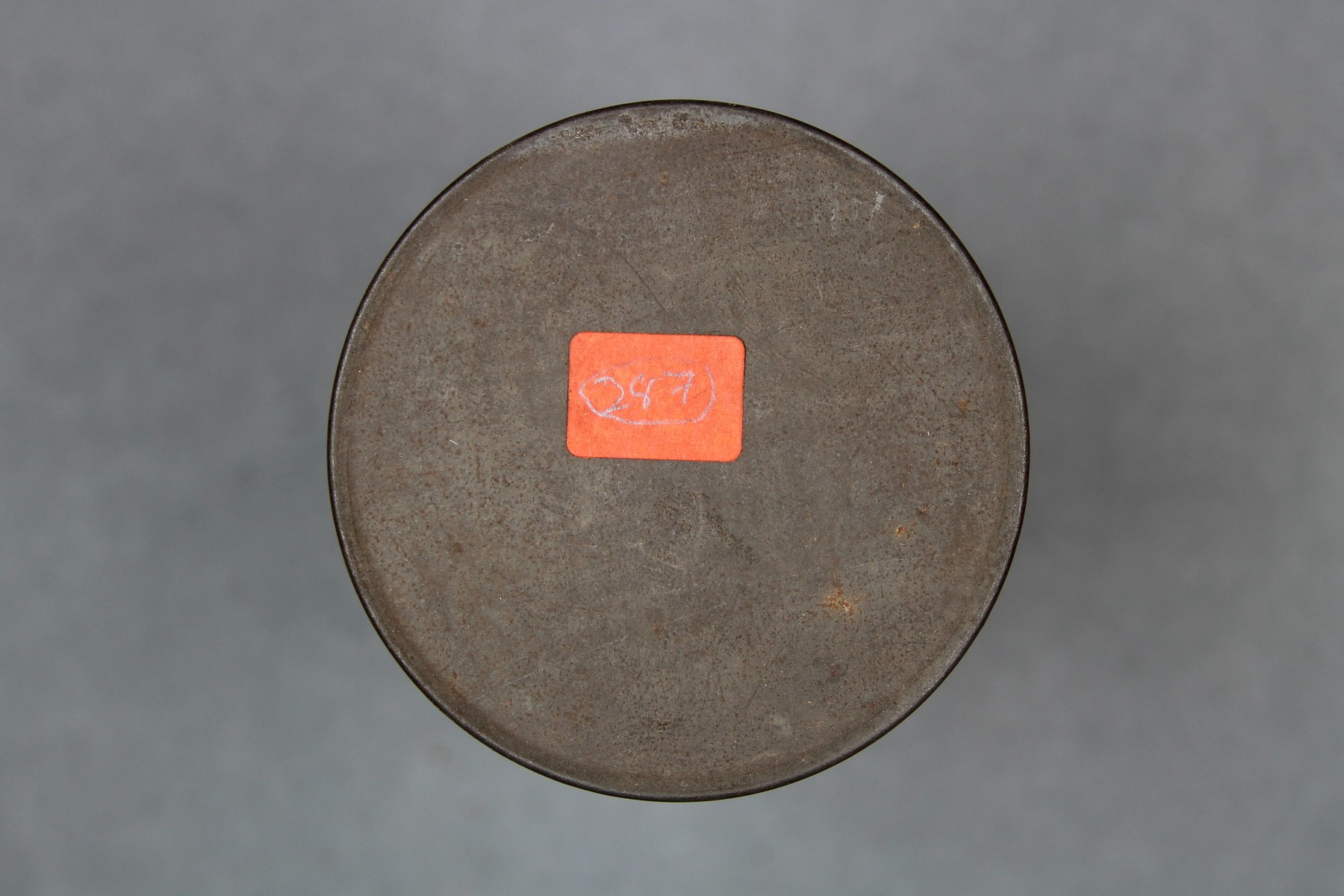      | Layard's fieldnotes are in the John Willoughby Layard papers (MSS 84) in the Special Collections & Archives of the University of California, San Diego. The music notes are compiled in a PDF titled ‘Unpublished Atchin book: “Folk Songs”: Annotated music books, with words and music, hand-written and typed notes, translations.’ from box 47, folder 8. This PDF is held by the British Library. | ||||||
| C177/288 | Arasar Tu'aen | Unidentified (percussion) | Atchin, Malekula, New Hebrides Condominium (Vanuatu) | 28 September 1914 – 9 October 1915 | 1. Ref note (probably A flat) followed by drumming. From Layard’s fieldnotes (page 19): “Asar-en. I. Asar. Pause Tuha-en (only sounded for giving of pigs or mats - ni-mbwen - )” From Layard's fieldnotes (page 105): “Arasar, Tuhaen." | Good quality recording with clear signal and little surface noise. | Uripiv-Wala-Rano-Atchin | Field recordings | John Willoughby Layard, 1891-1974 | 5'17" | John Layard, 1914-1915 | Brown wax cylinder | John Layard 1914 Atchin, New Hebrides Cylinder Collection | British Library | 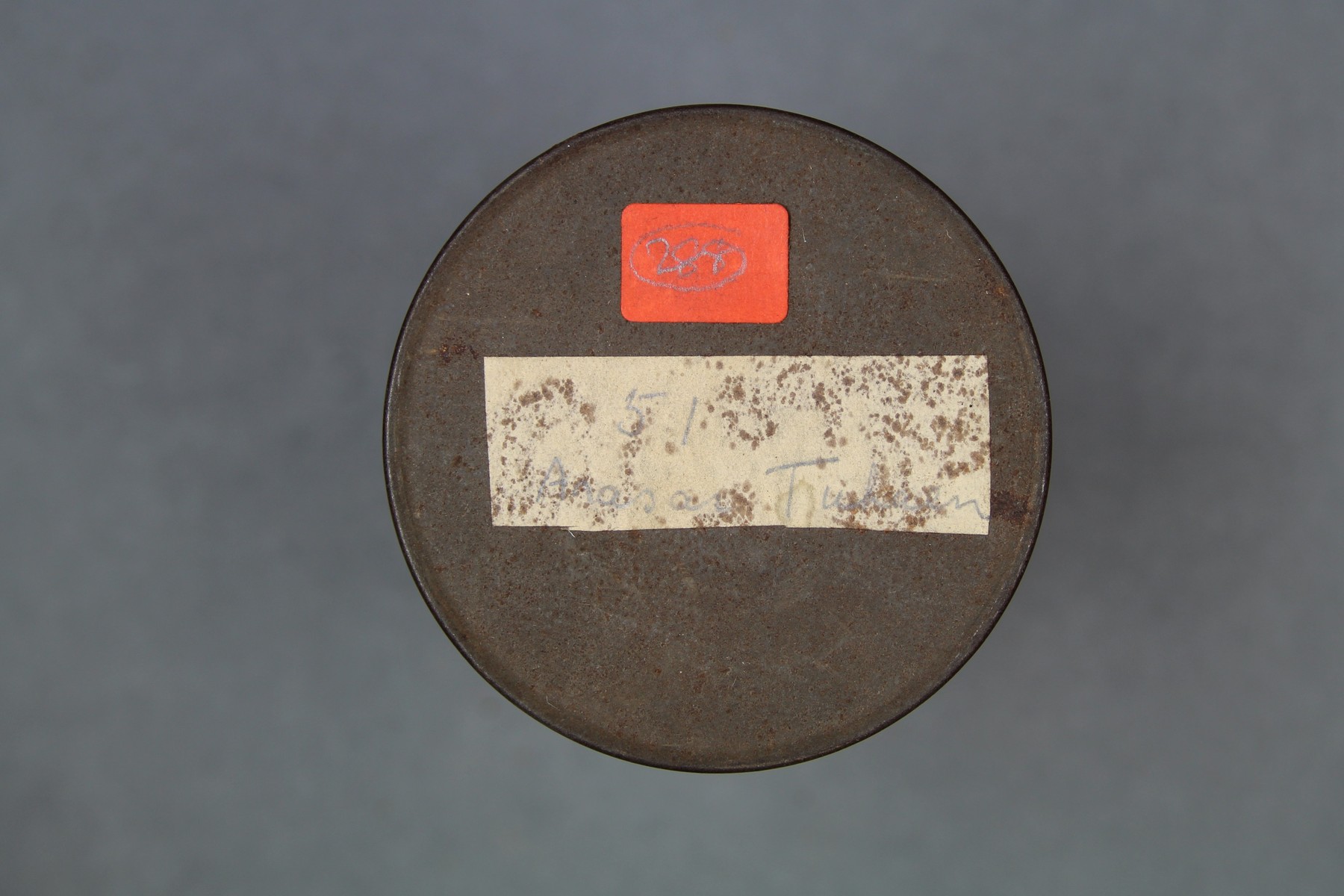      | Layard's fieldnotes are in the John Willoughby Layard papers (MSS 84) in the Special Collections & Archives of the University of California, San Diego. The music notes are compiled in a PDF titled ‘Unpublished Atchin book: “Folk Songs”: Annotated music books, with words and music, hand-written and typed notes, translations.’ from box 47, folder 8. This PDF is held by the British Library. | ||||||
| C177/289 | Botemöw | Unidentified (percussion) | Atchin, Malekula, New Hebrides Condominium (Vanuatu) | 28 September 1914 – 9 October 1915 | 1. Ref note (probably A flat) followed by drumming. From Layard’s fieldnotes (page 19): “Bot-mew (danced on eve of Maki.)” | Good quality recording with clear signal and little surface noise. | Uripiv-Wala-Rano-Atchin | Field recordings | John Willoughby Layard, 1891-1974 | 4'53" | John Layard, 1914-1915 | Brown wax cylinder | John Layard 1914 Atchin, New Hebrides Cylinder Collection | British Library |  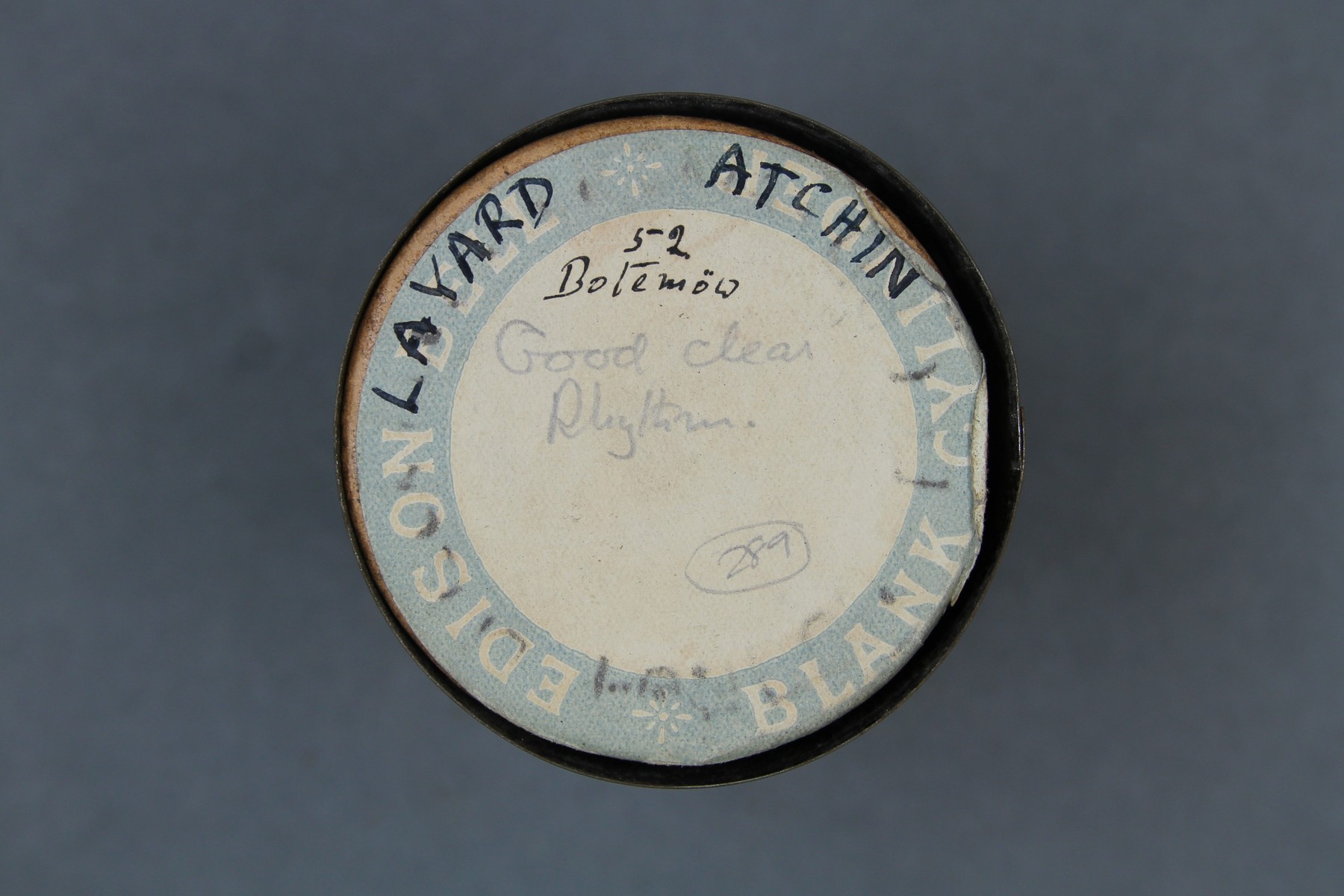     | Layard's fieldnotes are in the John Willoughby Layard papers (MSS 84) in the Special Collections & Archives of the University of California, San Diego. The music notes are compiled in a PDF titled ‘Unpublished Atchin book: “Folk Songs”: Annotated music books, with words and music, hand-written and typed notes, translations.’ from box 47, folder 8. This PDF is held by the British Library. | ||||||
| C177/290 | N. Rildralen | Unidentified (percussion) | Atchin, Malekula, New Hebrides Condominium (Vanuatu) | 28 September 1914 – 9 October 1915 | 1. Ref note (probably A flat) followed by drumming. mbwe - gong ; nambwe - gong-signal (Capell and Layard 1980:119) From Layard’s fieldnotes (page 19): “Na-mbwe ril-dralen” | Good quality recording with clear signal and little surface noise. | Uripiv-Wala-Rano-Atchin | Field recordings | John Willoughby Layard, 1891-1974 | 5'18" | John Layard, 1914-1915 | Brown wax cylinder | John Layard 1914 Atchin, New Hebrides Cylinder Collection | British Library | 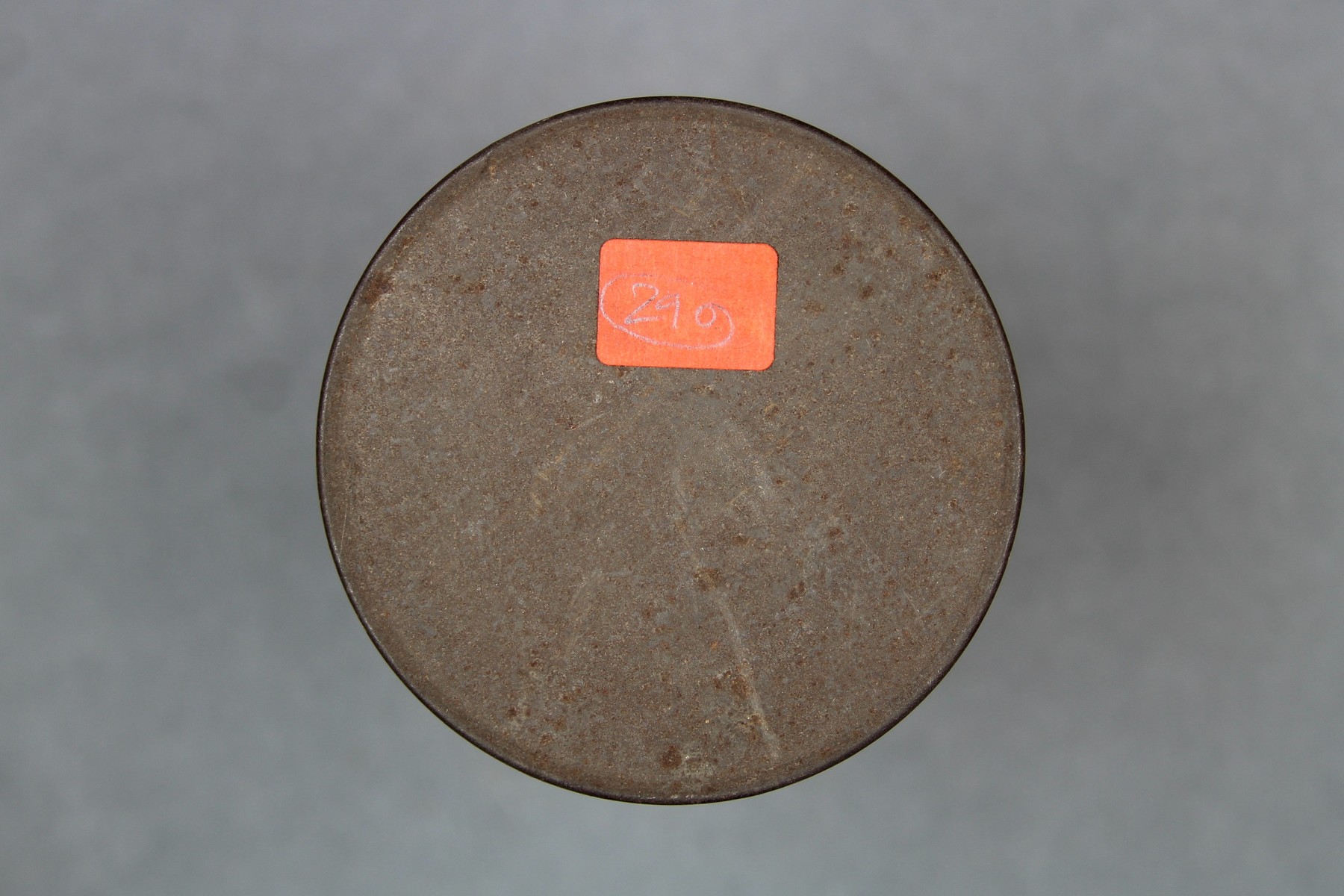 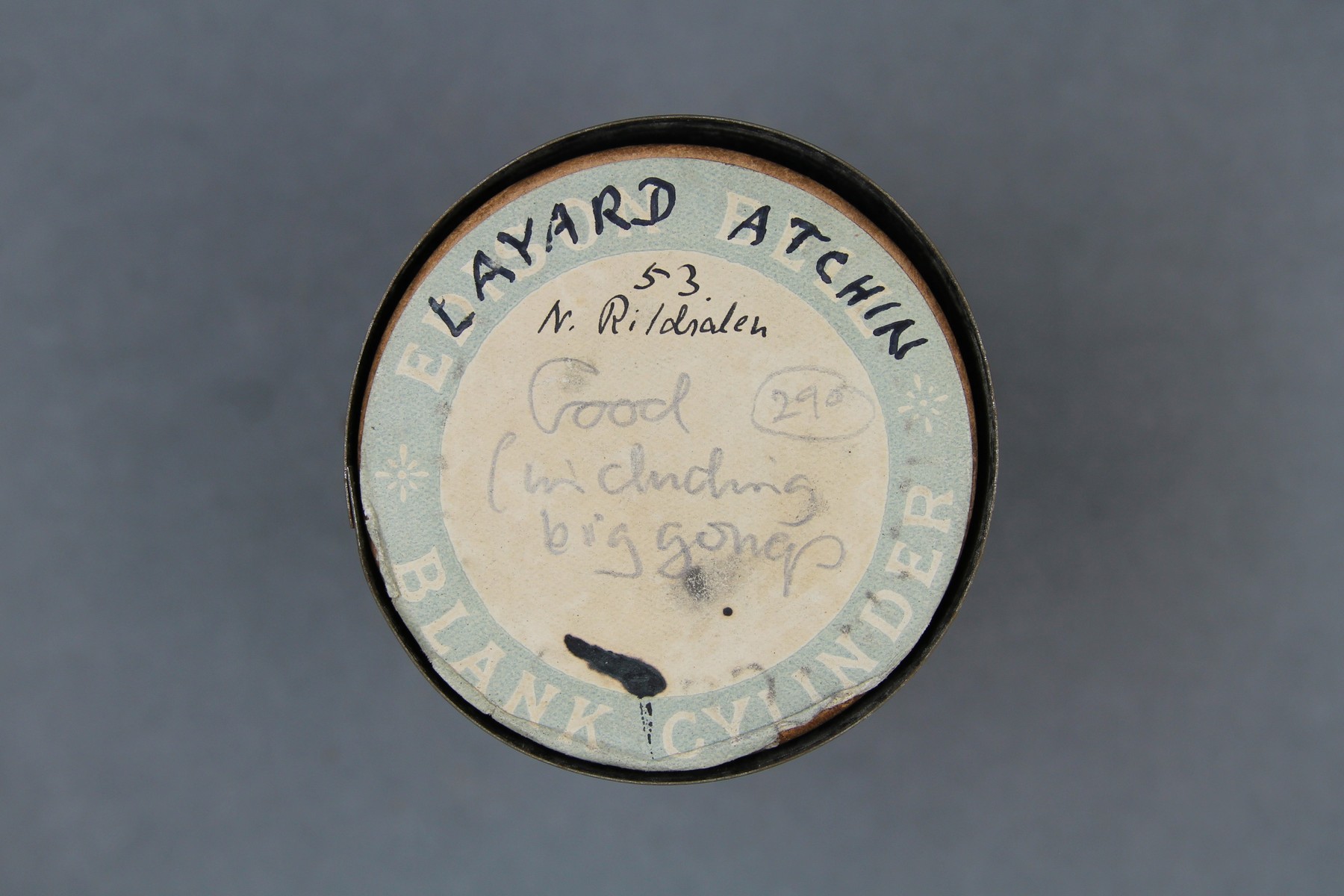     | Layard's fieldnotes are in the John Willoughby Layard papers (MSS 84) in the Special Collections & Archives of the University of California, San Diego. The music notes are compiled in a PDF titled ‘Unpublished Atchin book: “Folk Songs”: Annotated music books, with words and music, hand-written and typed notes, translations.’ from box 47, folder 8. This PDF is held by the British Library. | ||||||
| C177/291 | N. Rildralen. 2 Ser'aen | Unidentified (percussion) | Atchin, Malekula, New Hebrides Condominium (Vanuatu) | 28 September 1914 – 9 October 1915 | 1. Ref note (probably A flat) followed by drumming. mbwe - gong ; nambwe - gong-signal (Capell and Layard 1980:119) From Layard’s fieldnotes (page 19): “Na-mbwe ril-dralen. About ¾’ from the beginning Na-mbwe Serahen. For metsen. Rildralen followed straight by serahen without e bure- bure-ni.” From Layard's fieldnotes (page 105): "Na-mbwe rildralen and serhaen" | Reasonable quality recording with clear signal but with surface noise due to cracked cylinder. | Uripiv-Wala-Rano-Atchin | Field recordings | John Willoughby Layard, 1891-1974 | 5'49" | John Layard, 1914-1915 | Brown wax cylinder | John Layard 1914 Atchin, New Hebrides Cylinder Collection | British Library | 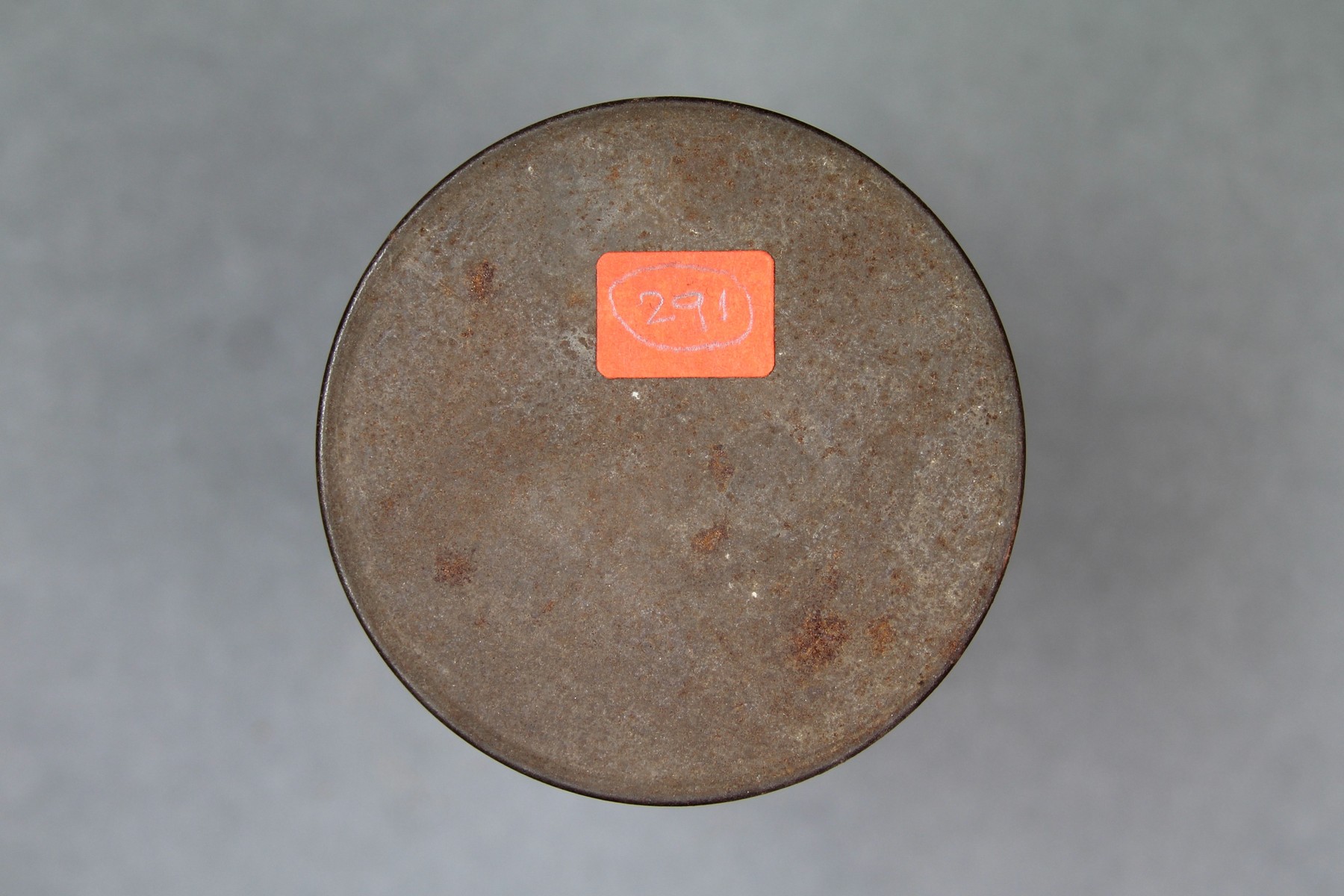 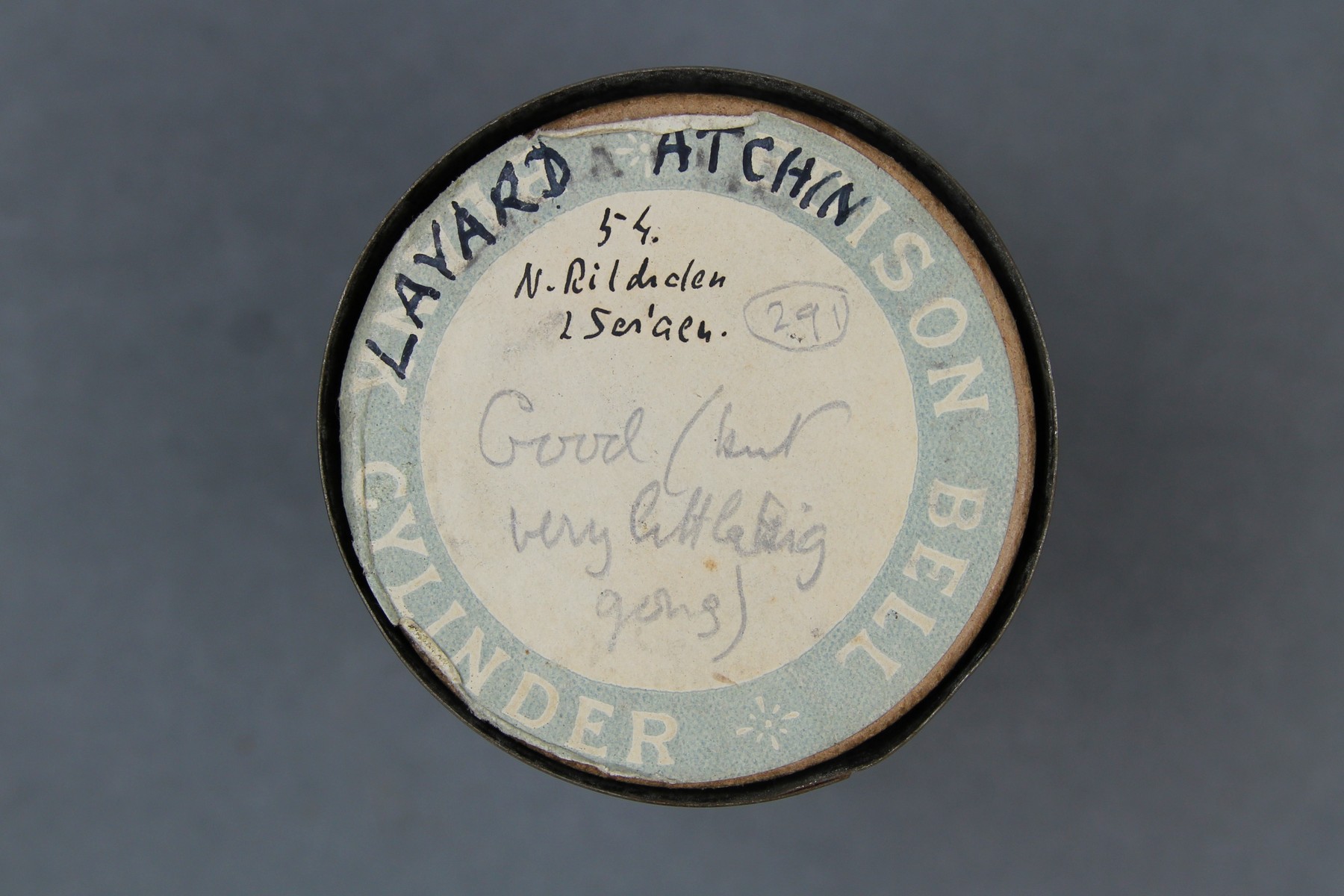     | Layard's fieldnotes are in the John Willoughby Layard papers (MSS 84) in the Special Collections & Archives of the University of California, San Diego. The music notes are compiled in a PDF titled ‘Unpublished Atchin book: “Folk Songs”: Annotated music books, with words and music, hand-written and typed notes, translations.’ from box 47, folder 8. This PDF is held by the British Library. | ||||||
| C177/292 | Etutu tuloni | Unidentified (percussion) | Atchin, Malekula, New Hebrides Condominium (Vanuatu) | 28 September 1914 – 9 October 1915 | 1. Inaudible due to cutter bounce. 2. Ref note (probably A flat) followed by drumming. From Layard’s fieldnotes (page 19): “E tututuloni – first by mother-gong, and, that being no good, by tsoron.” From Layard's fieldnotes (page 105): “e tu-tu-tu-loni, first on mother gong, but this not coming out well, then on portable gonglets.” | Track 2 is good quality with clear signal and little surface noise. | Uripiv-Wala-Rano-Atchin | Field recordings | John Willoughby Layard, 1891-1974 | 5'01" | John Layard, 1914-1915 | Brown wax cylinder | John Layard 1914 Atchin, New Hebrides Cylinder Collection | British Library |  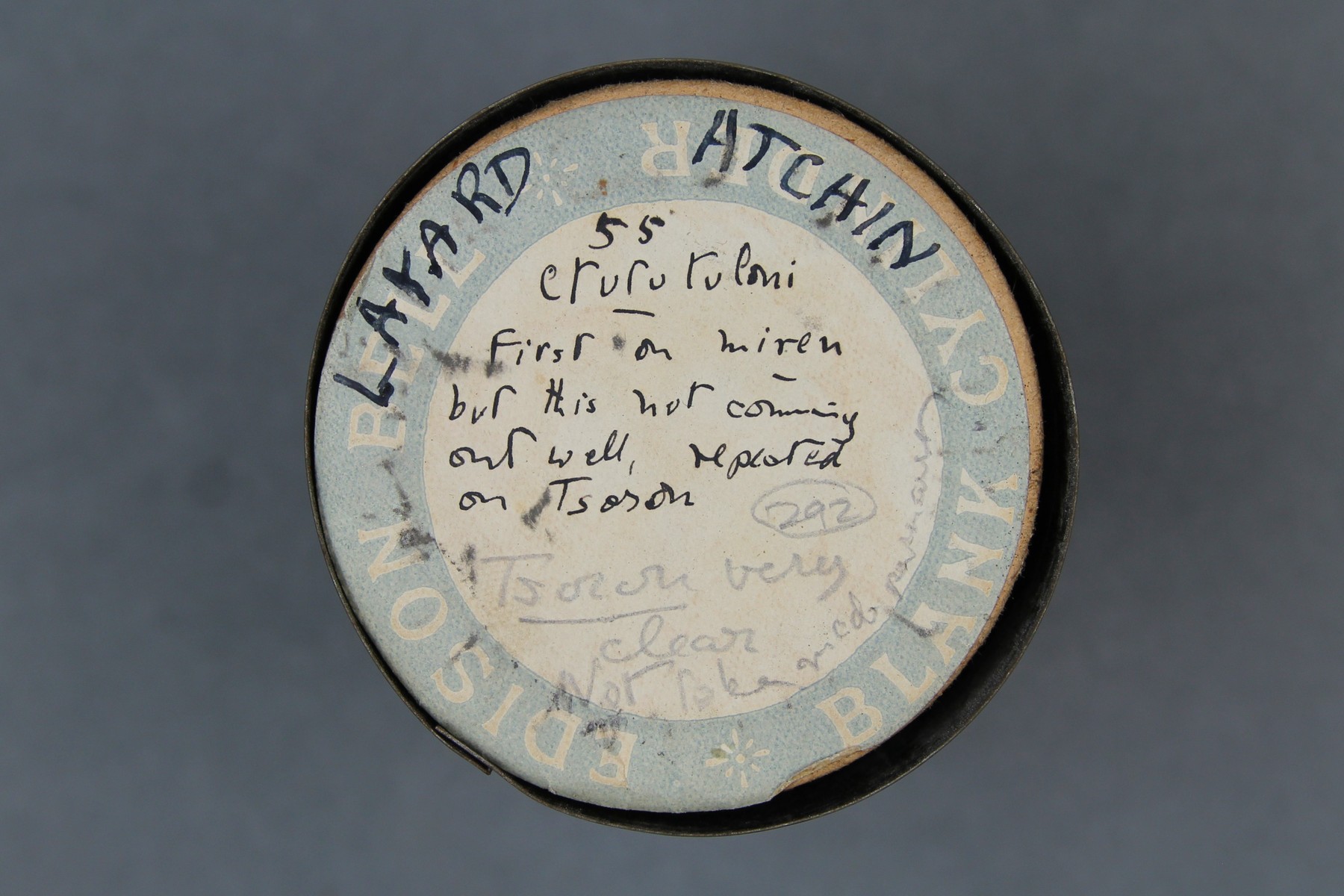     | Layard's fieldnotes are in the John Willoughby Layard papers (MSS 84) in the Special Collections & Archives of the University of California, San Diego. The music notes are compiled in a PDF titled ‘Unpublished Atchin book: “Folk Songs”: Annotated music books, with words and music, hand-written and typed notes, translations.’ from box 47, folder 8. This PDF is held by the British Library. | ||||||
| C177/293 | Welenimbek [1] | Unidentified (percussion); unidentified (male chorus) | Atchin, Malekula, New Hebrides Condominium (Vanuatu) | 28 September 1914 – 9 October 1915 | 1. Drumming with two shouts at end. 2-3. Male duet with drumming accompaniment. From Layard’s fieldnotes (page 19): “Welenimbek. When they cry they stop, and then start dancing again with a new song (see also 59)” | Good quality recording with clear signal and little surface noise. | Uripiv-Wala-Rano-Atchin | Field recordings | John Willoughby Layard, 1891-1974 | 4'11" | John Layard, 1914-1915 | Brown wax cylinder | John Layard 1914 Atchin, New Hebrides Cylinder Collection | British Library | 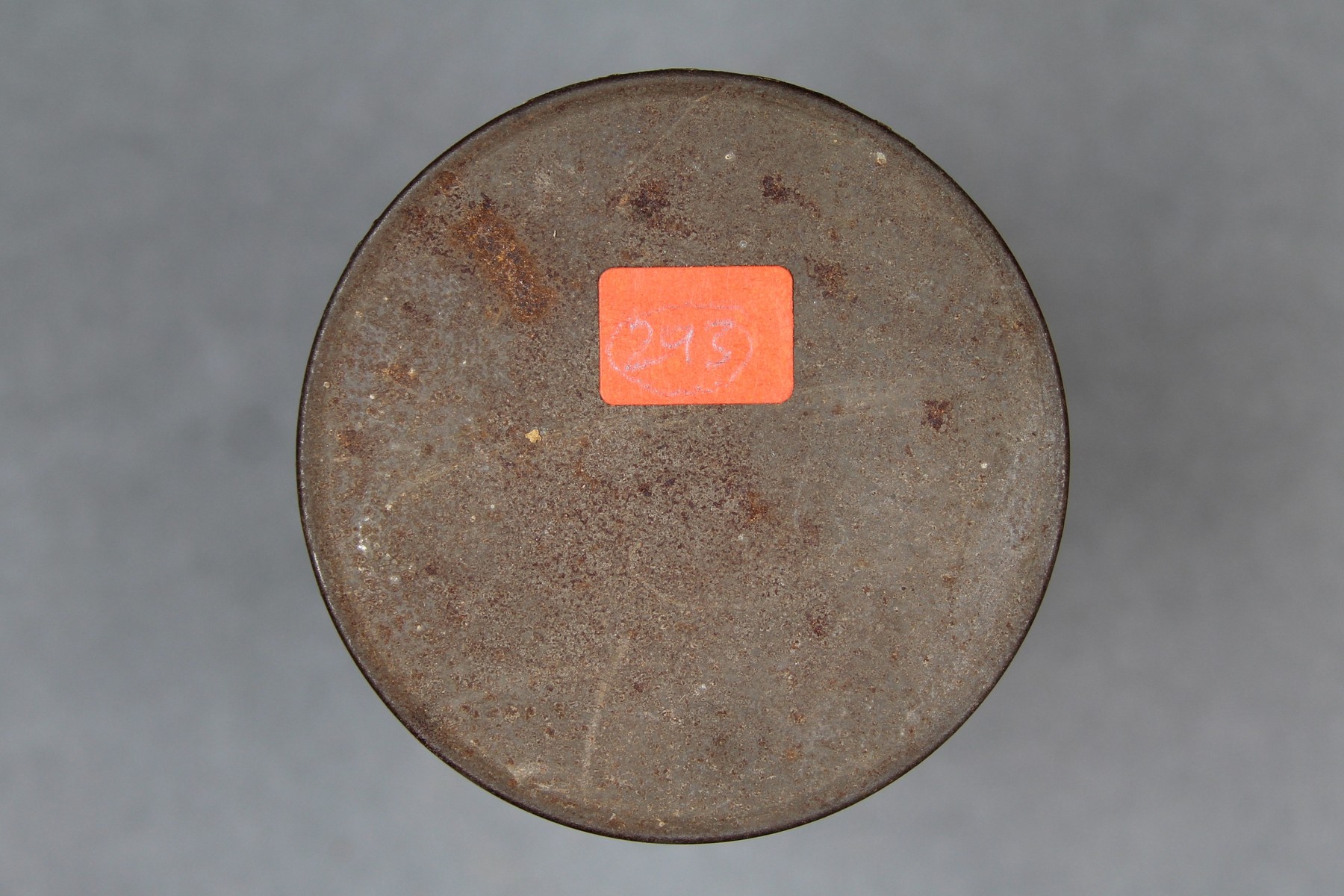 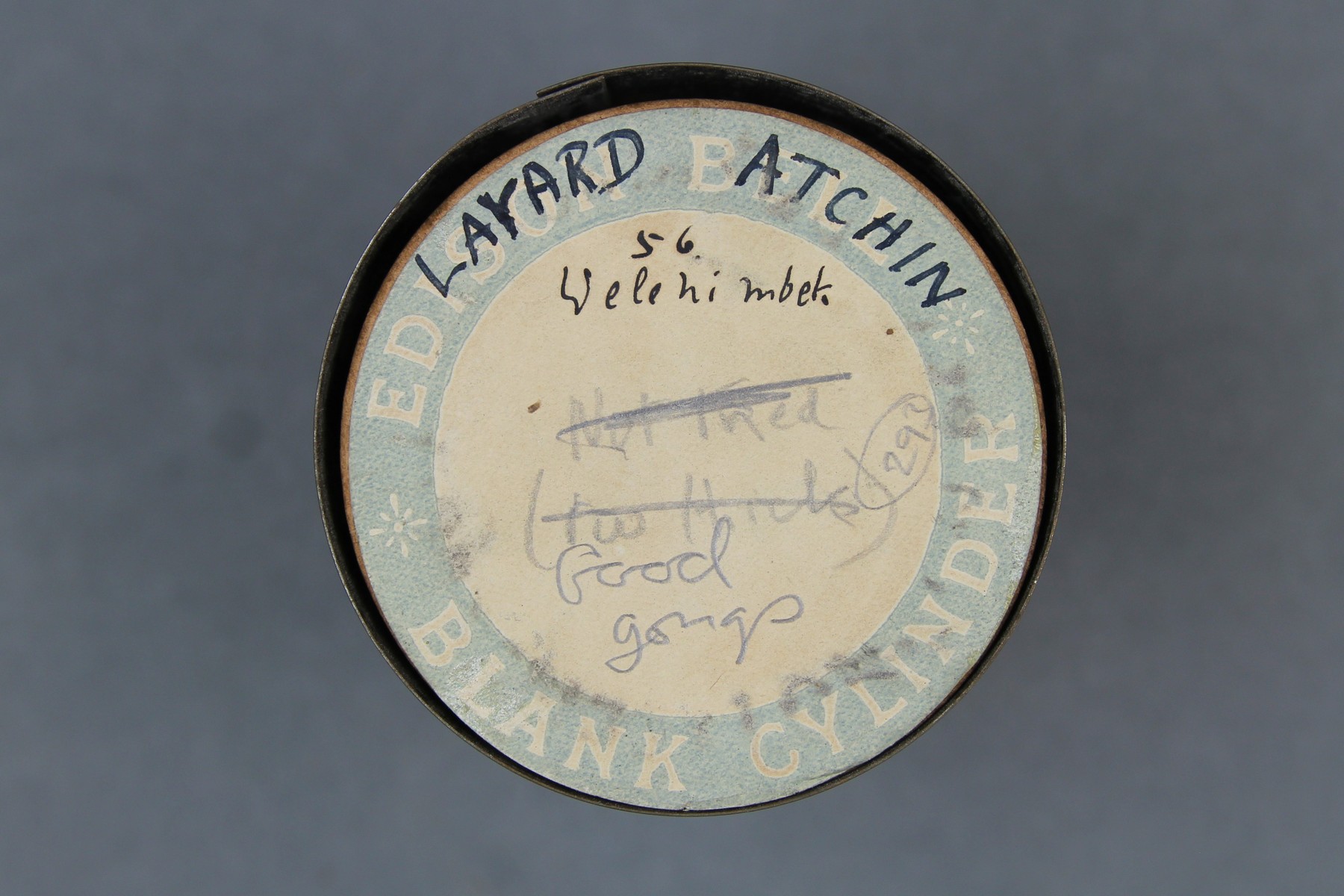     | Layard's fieldnotes are in the John Willoughby Layard papers (MSS 84) in the Special Collections & Archives of the University of California, San Diego. The music notes are compiled in a PDF titled ‘Unpublished Atchin book: “Folk Songs”: Annotated music books, with words and music, hand-written and typed notes, translations.’ from box 47, folder 8. This PDF is held by the British Library. | ||||||
| C177/294 | Selven [1] | Unidentified (percussion); unidentified (male chorus) | Atchin, Malekula, New Hebrides Condominium (Vanuatu) | 28 September 1914 – 9 October 1915 | 1. Male vocal group with drumming. 2. False start. 3. Male vocal group with shouts, whistles and gongs. From Layard’s fieldnotes (page 19): “Seluen, with another song and more fully. Wenen:- Ni-al we na-vül pwi ser ruru nimbwalep. Naus baus pwi awe wenu. ‘May the sun and moon shine and penetrate through the leaves. May the rain fall and cover the ground’. There is another verse: Se sal mele uri. Olewe pipi mouwat pal-pal atom re sela ghasi. ‘Let us shoot fish called pipi and mouwat and put them at the sacrificial posts and dance round them’.” | Reasonable quality recording but with some distortion. | Uripiv-Wala-Rano-Atchin | Field recordings | John Willoughby Layard, 1891-1974 | 4'26" | John Layard, 1914-1915 | Brown wax cylinder | John Layard 1914 Atchin, New Hebrides Cylinder Collection | British Library | 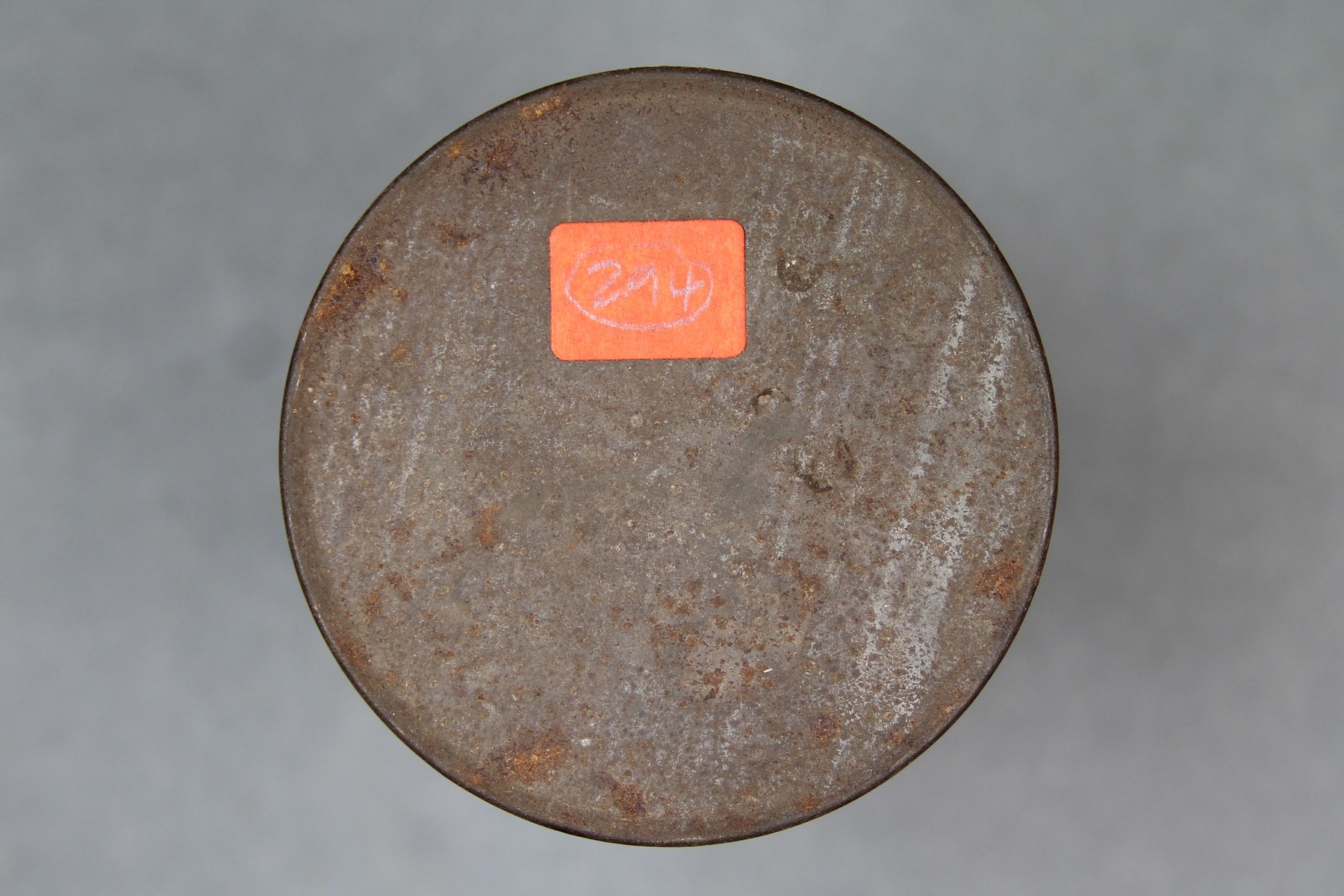 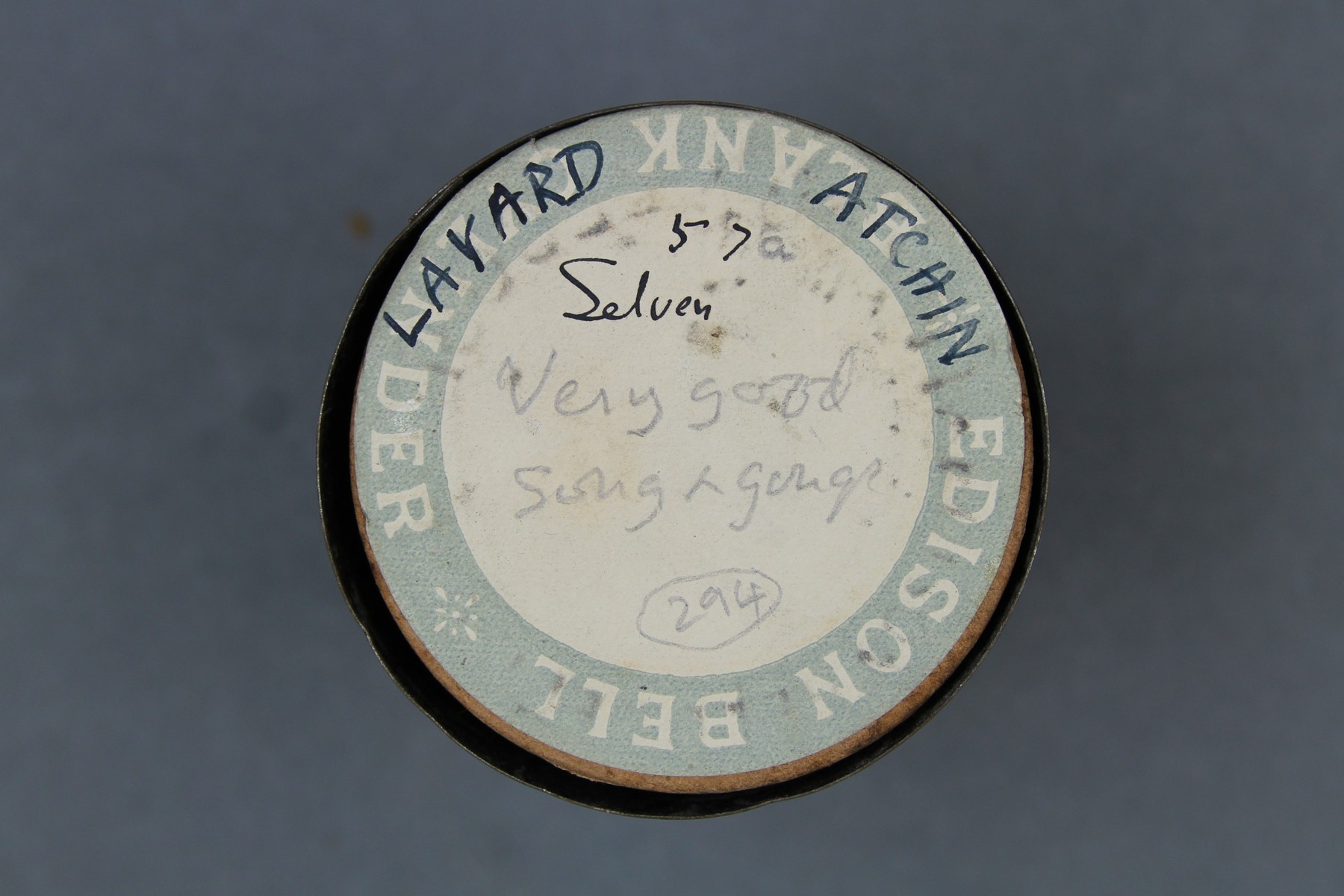     | Layard's fieldnotes are in the John Willoughby Layard papers (MSS 84) in the Special Collections & Archives of the University of California, San Diego. The music notes are compiled in a PDF titled ‘Unpublished Atchin book: “Folk Songs”: Annotated music books, with words and music, hand-written and typed notes, translations.’ from box 47, folder 8. This PDF is held by the British Library. | ||||||
| C177/295 | Selven [2] | Unidentified (percussion); unidentified (male chorus) | Atchin, Malekula, New Hebrides Condominium (Vanuatu) | 28 September 1914 – 9 October 1915 | 1. Male vocal group with drumming. From Layard’s fieldnotes (page 19): “Seluen, with another so ng and more fully. Wenen:- Ni-al we na-vül pwi ser ruru nimbwalep. Naus baus pwi awe wenu. ‘May the sun and moon shine and penetrate through the leaves. May the rain fall and cover the ground’. There is another verse: Se sal mele uri. Olewe pipi mouwat pal-pal atom re sela ghasi. ‘Let us shoot fish called pipi and mouwat and put them at the sacrificial posts and dance round them’.” | Reasonable quality recording but with some distortion. | Uripiv-Wala-Rano-Atchin | Field recordings | John Willoughby Layard, 1891-1974 | 2'32" | John Layard, 1914-1915 | Brown wax cylinder | John Layard 1914 Atchin, New Hebrides Cylinder Collection | British Library | 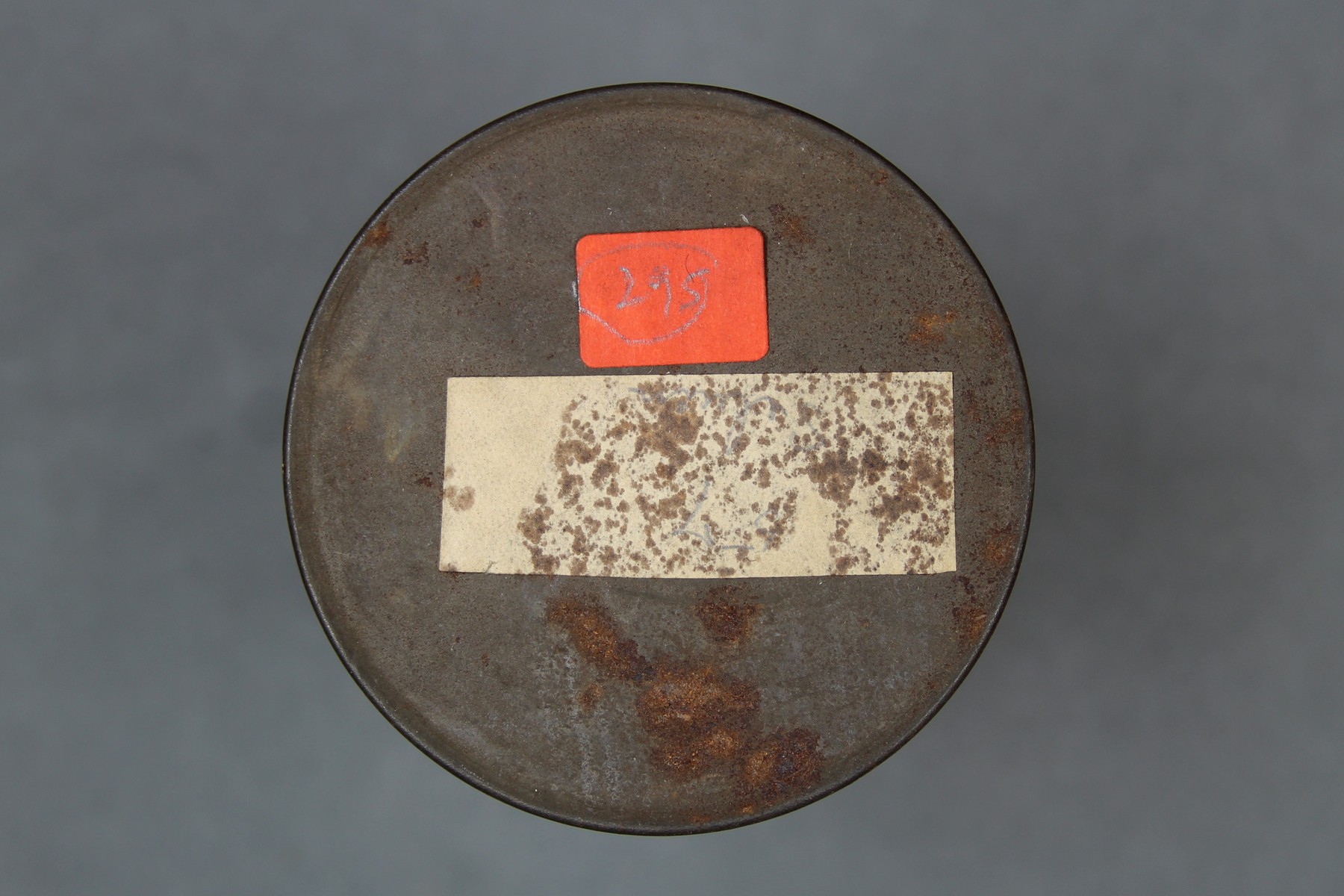      | Layard's fieldnotes are in the John Willoughby Layard papers (MSS 84) in the Special Collections & Archives of the University of California, San Diego. The music notes are compiled in a PDF titled ‘Unpublished Atchin book: “Folk Songs”: Annotated music books, with words and music, hand-written and typed notes, translations.’ from box 47, folder 8. This PDF is held by the British Library. | ||||||
| C177/296 | Dureinambwe | Unidentified (percussion); unidentified (male chorus) | Atchin, Malekula, New Hebrides Condominium (Vanuatu) | 28 September 1914 – 9 October 1915 | 1. Male vocal group with shouting and drumming. mbwe - gong ; nambwe - gong-signal (Capell and Layard 1980:119) From Layard’s fieldnotes (page 19): Durei na-mbwe. (Gong-raising),. Mish-mash tan-mwe-liw. Tamate o tai mish-mash na-mbuas pal ne winöv. ‘Mish-mash at (belonging to?) Tan-mwe-liw. The ghost (his ghost) cut this mish-mash and killed all the pigs.’” | Reasonable quality recording but with strong signal resulting in distortion. | Uripiv-Wala-Rano-Atchin | Field recordings | John Willoughby Layard, 1891-1974 | 4'50" | John Layard, 1914-1915 | Brown wax cylinder | John Layard 1914 Atchin, New Hebrides Cylinder Collection | British Library | 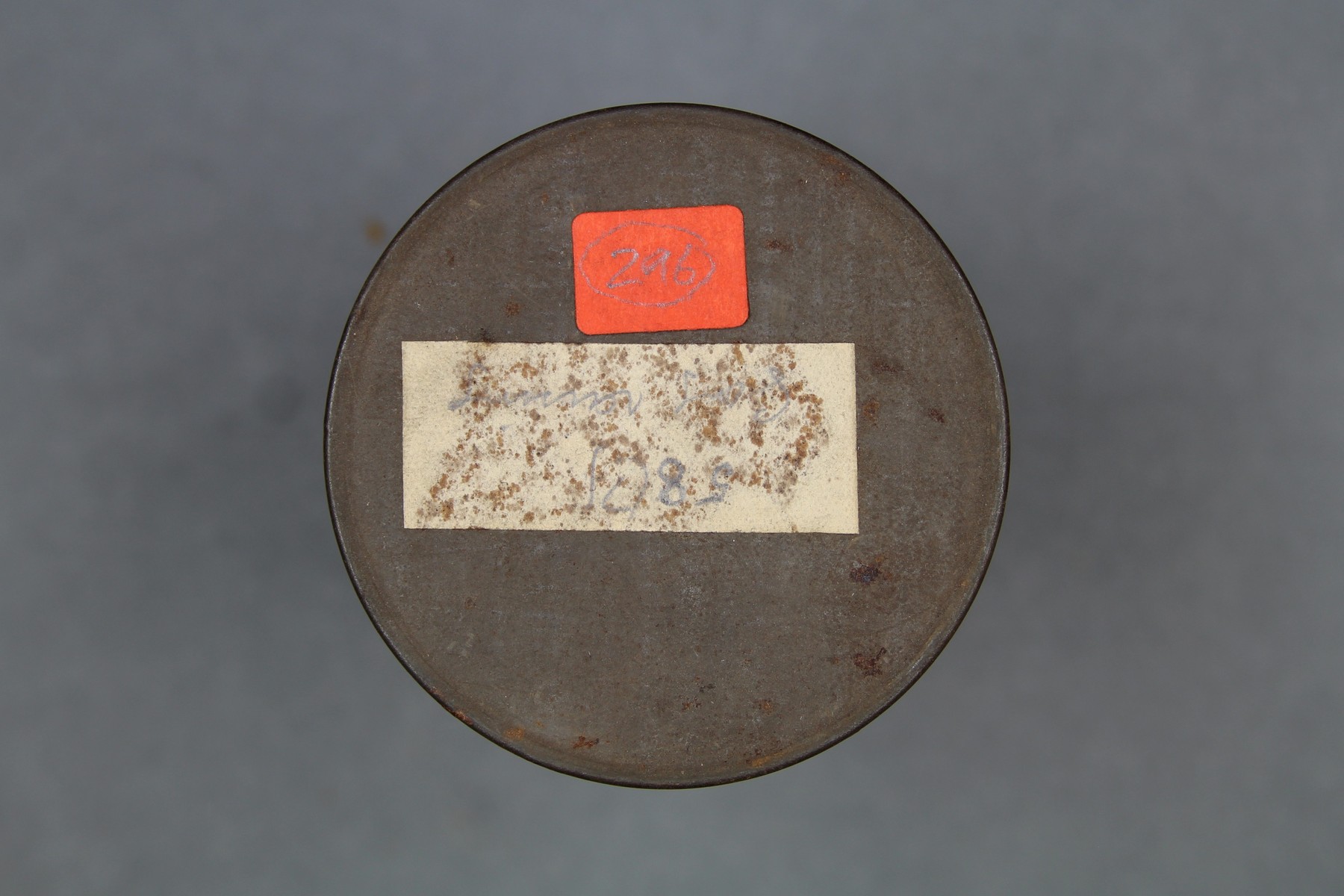 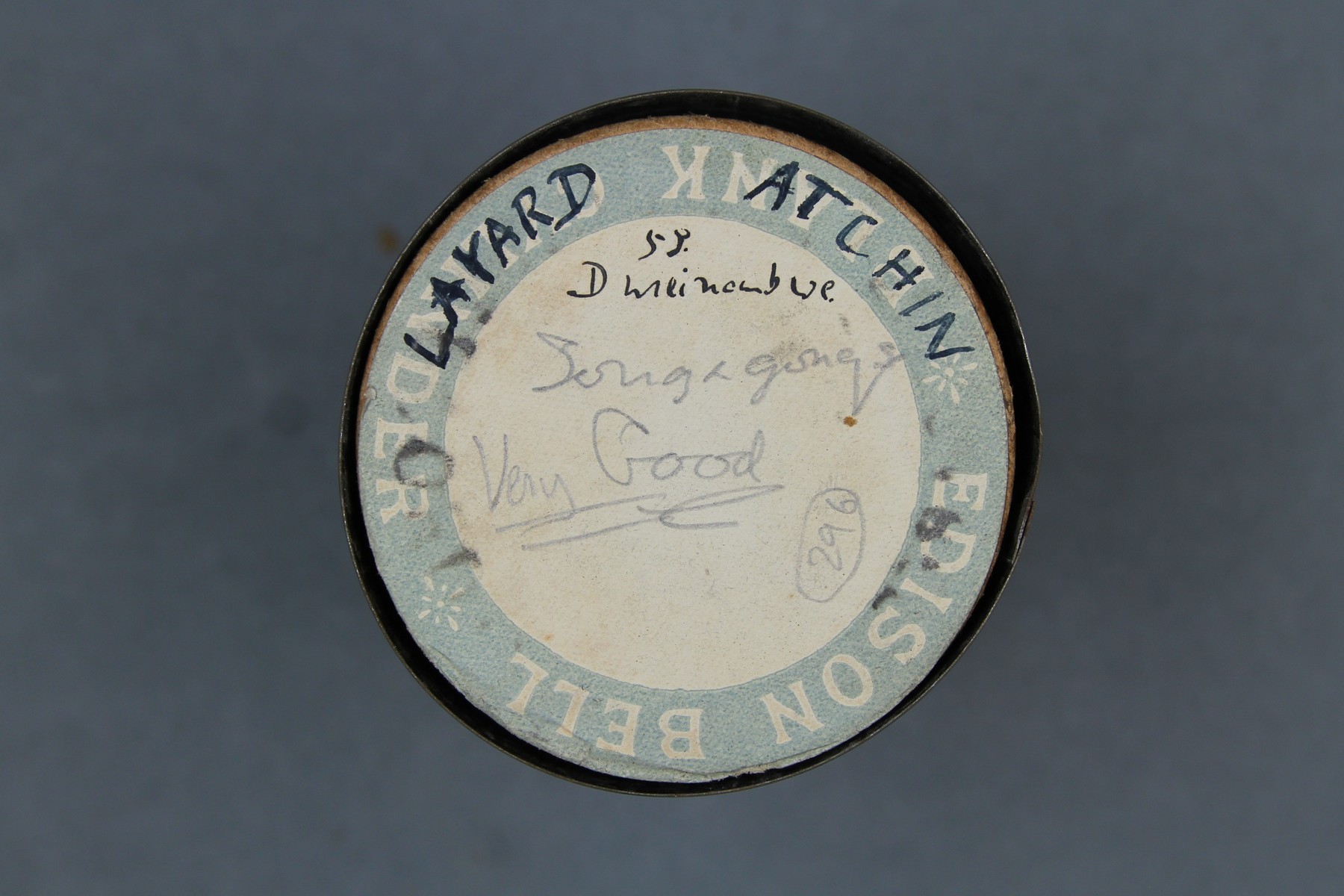     | Layard's fieldnotes are in the John Willoughby Layard papers (MSS 84) in the Special Collections & Archives of the University of California, San Diego. The music notes are compiled in a PDF titled ‘Unpublished Atchin book: “Folk Songs”: Annotated music books, with words and music, hand-written and typed notes, translations.’ from box 47, folder 8. This PDF is held by the British Library. | ||||||
| C177/297 | Welenimbek [2] | Unidentified (percussion); unidentified (male chorus) | Atchin, Malekula, New Hebrides Condominium (Vanuatu) | 28 September 1914 – 9 October 1915 | 1. Male vocal group with drumming. From Layard’s fieldnotes (page 19): "Welenimbek. (see also 56.) When silent or shouting they are running round. Savlang rov-romon. Merege romorum santsuri. Mo Nambuas. Rom sale na mesav. Tamangin oror tombat rom sal. ‘What wind? Mara takes us all pigs, float on the open sea.’ Tambangon --- men of Ambrym?” | Reasonable quality recording but with strong signal resulting in some distortion. | Uripiv-Wala-Rano-Atchin | Field recordings | John Willoughby Layard, 1891-1974 | 4'46" | John Layard, 1914-1915 | Brown wax cylinder | John Layard 1914 Atchin, New Hebrides Cylinder Collection | British Library | 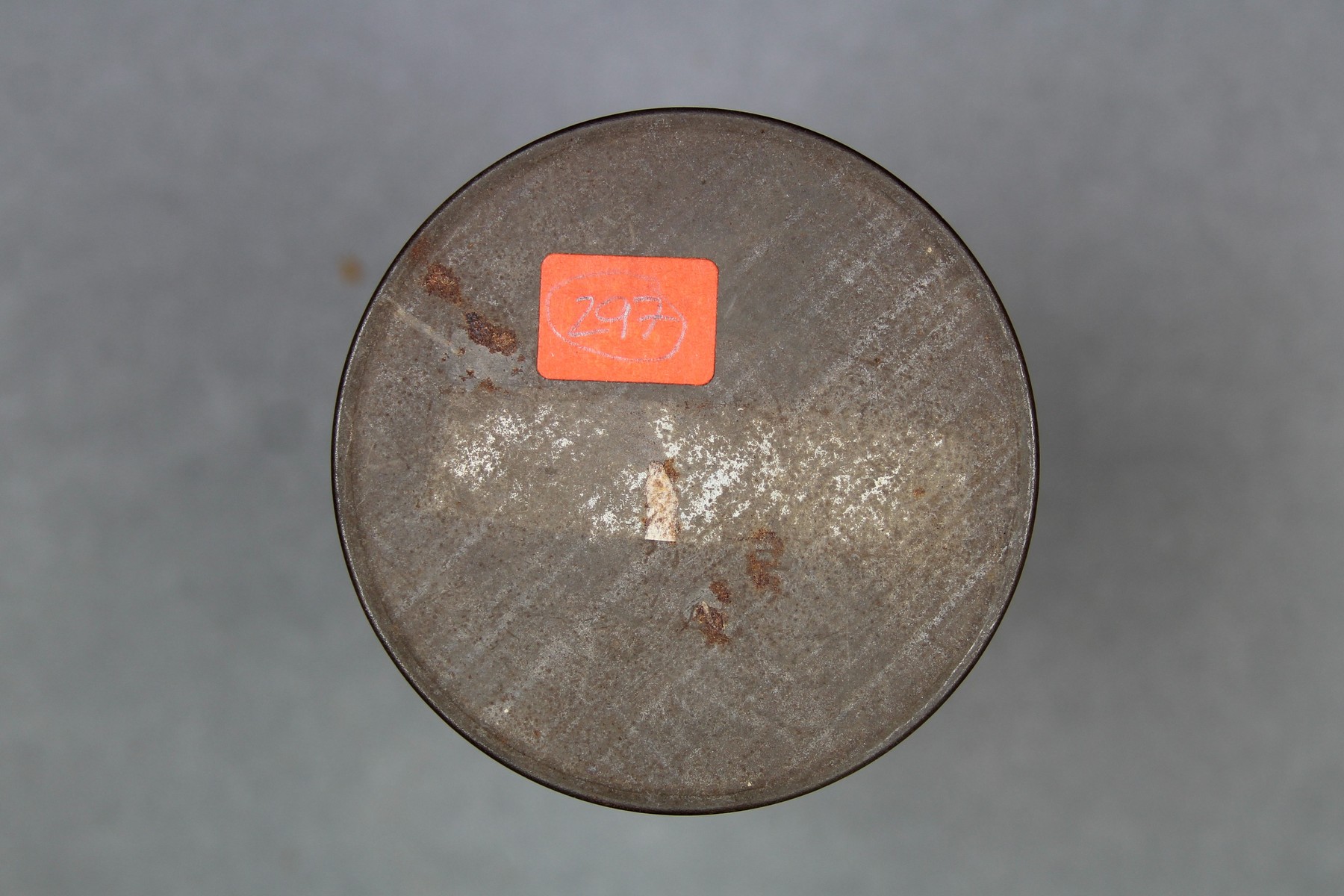 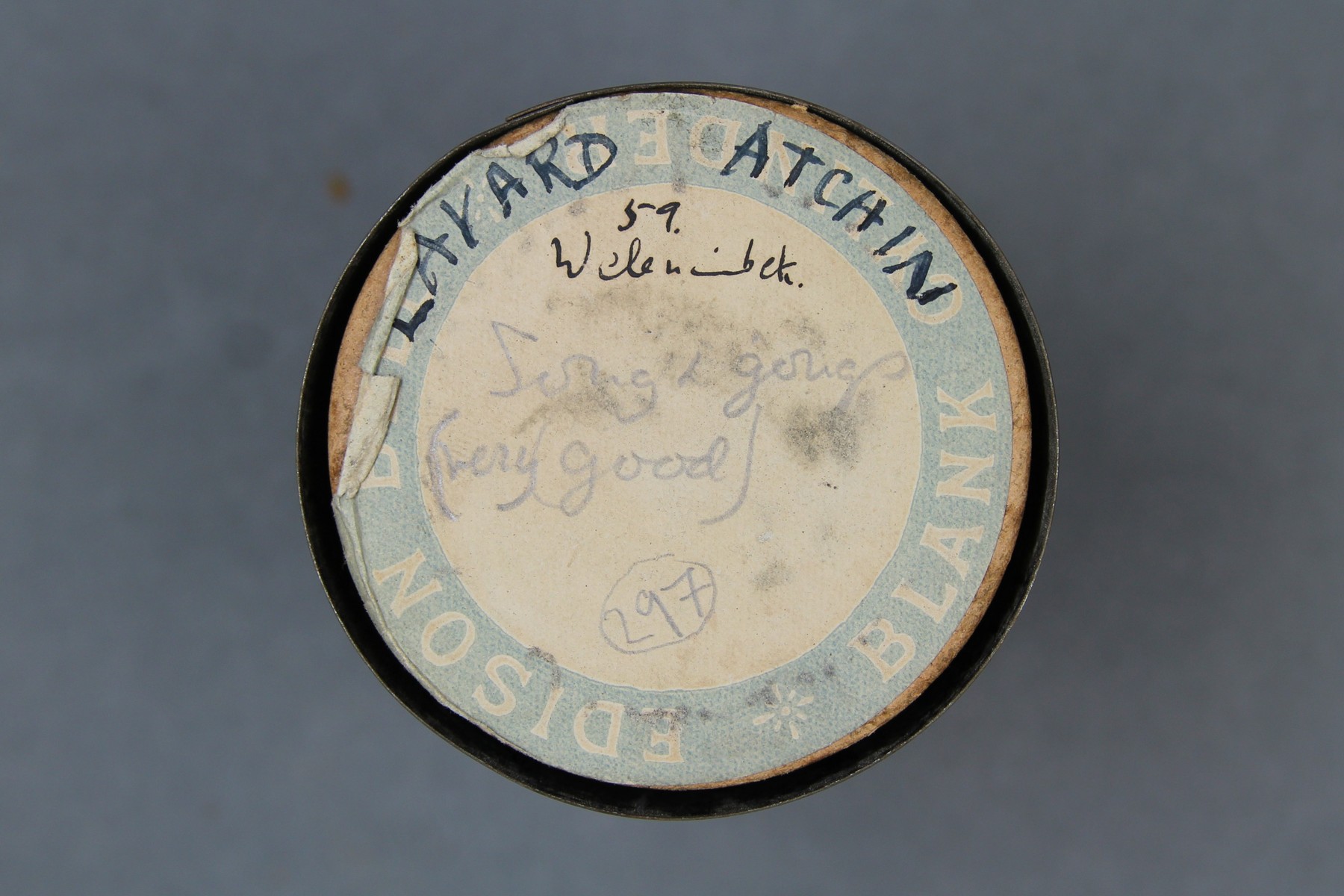     | Layard's fieldnotes are in the John Willoughby Layard papers (MSS 84) in the Special Collections & Archives of the University of California, San Diego. The music notes are compiled in a PDF titled ‘Unpublished Atchin book: “Folk Songs”: Annotated music books, with words and music, hand-written and typed notes, translations.’ from box 47, folder 8. This PDF is held by the British Library. | ||||||
| C177/298 | Welalen | Unidentified (percussion); unidentified (male chorus) | Atchin, Malekula, New Hebrides Condominium (Vanuatu) | 28 September 1914 – 9 October 1915 | 1. Ref note (probably A flat) followed by male vocal group and drumming. From Layard’s fieldnotes (page 19): “Welalen. Or lelek Meltego-to: or lelek lolo na’im: pu roror pie tsalil: (follows a 4th. stance meaning “all foreigners hear of it”) They stay (?gather) (with) Melteg-to: they stay (gather) at the house: he roofs ------ ------ outside’. Repeated with names of Rom-romon Nakur ? --- previous Singeremal occupiers Korton-mal of the ground?” | Reasonable quality recording but with strong signal resulting in some distortion. | Uripiv-Wala-Rano-Atchin | Field recordings | John Willoughby Layard, 1891-1974 | 5'05" | John Layard, 1914-1915 | Brown wax cylinder | John Layard 1914 Atchin, New Hebrides Cylinder Collection | British Library | 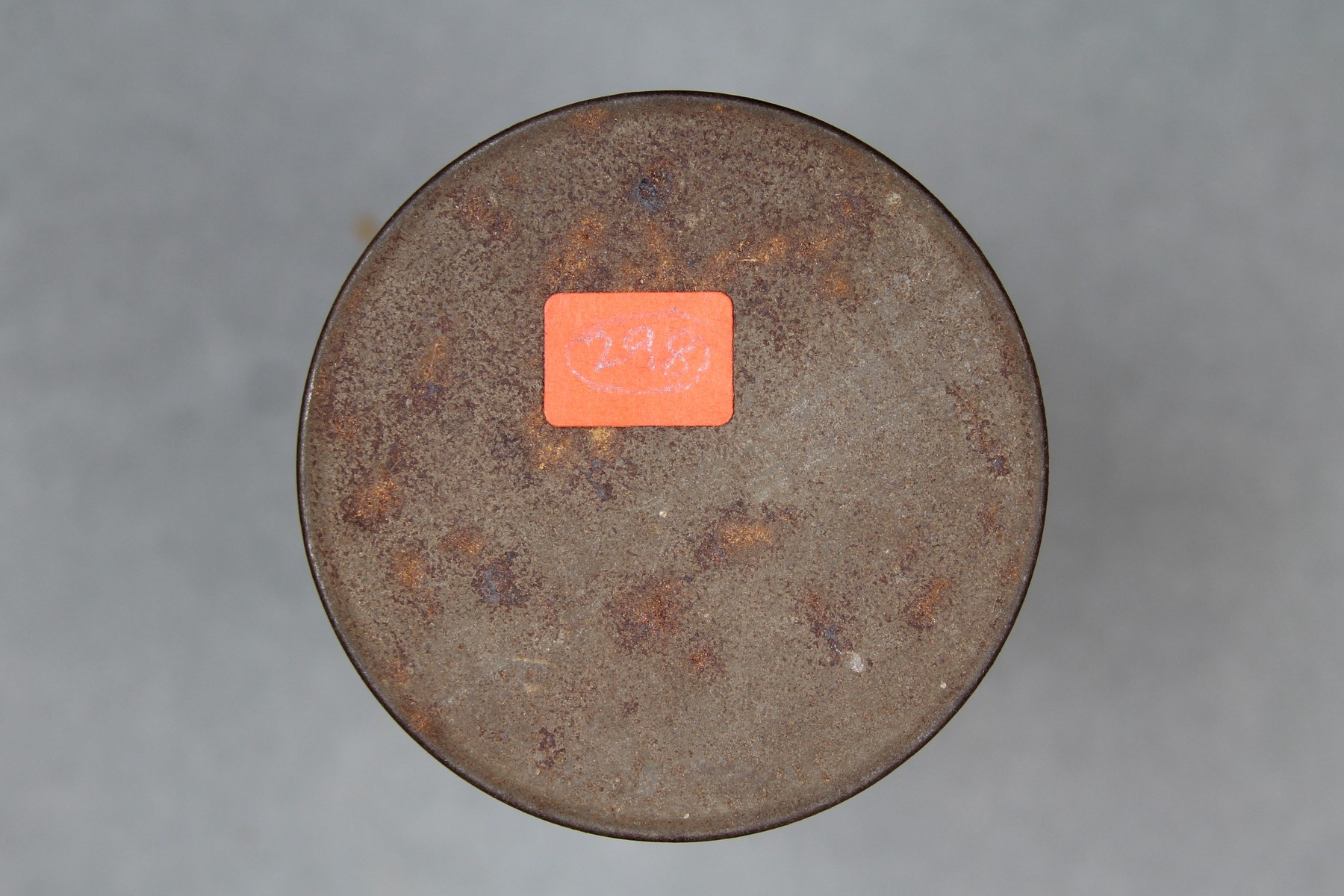 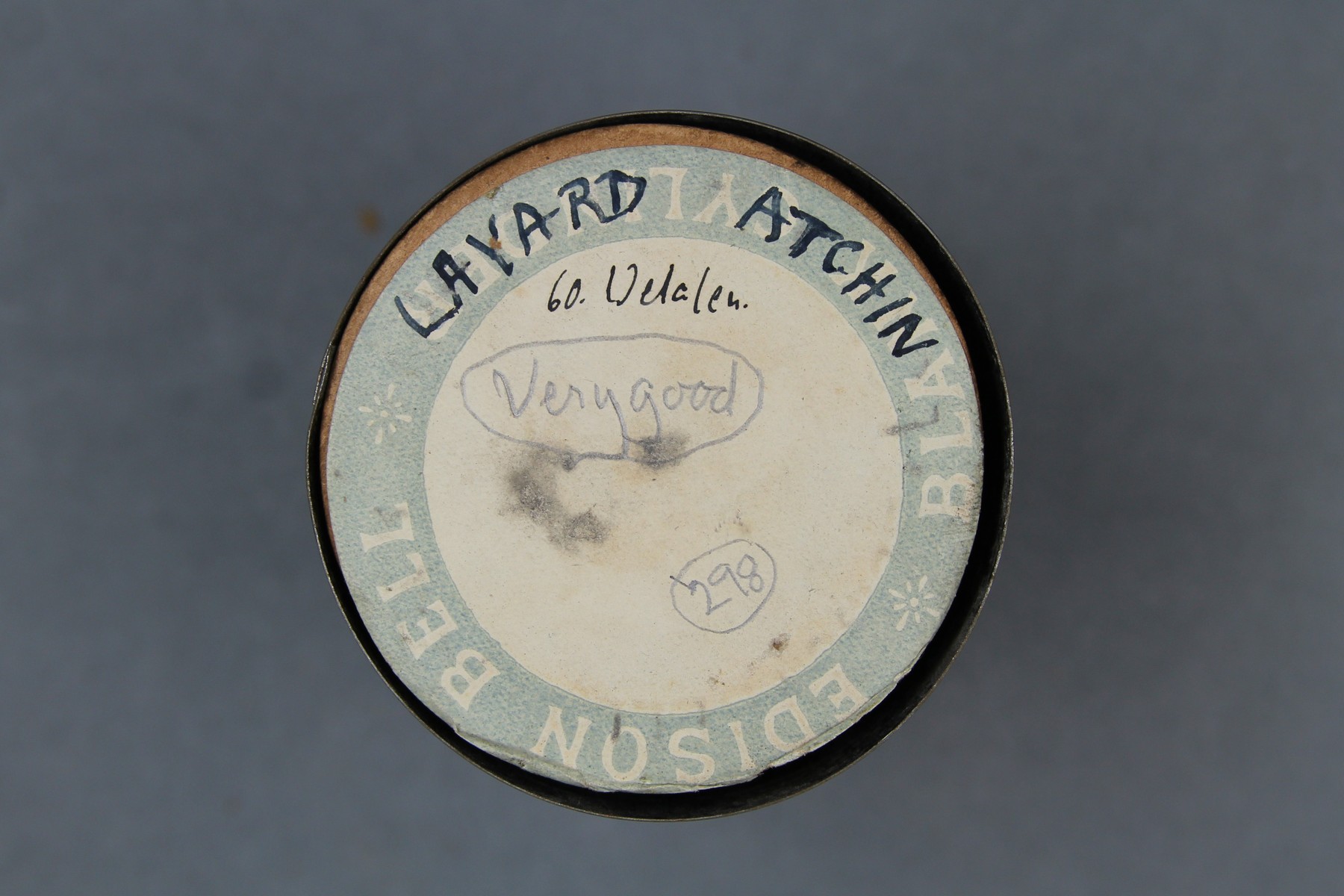 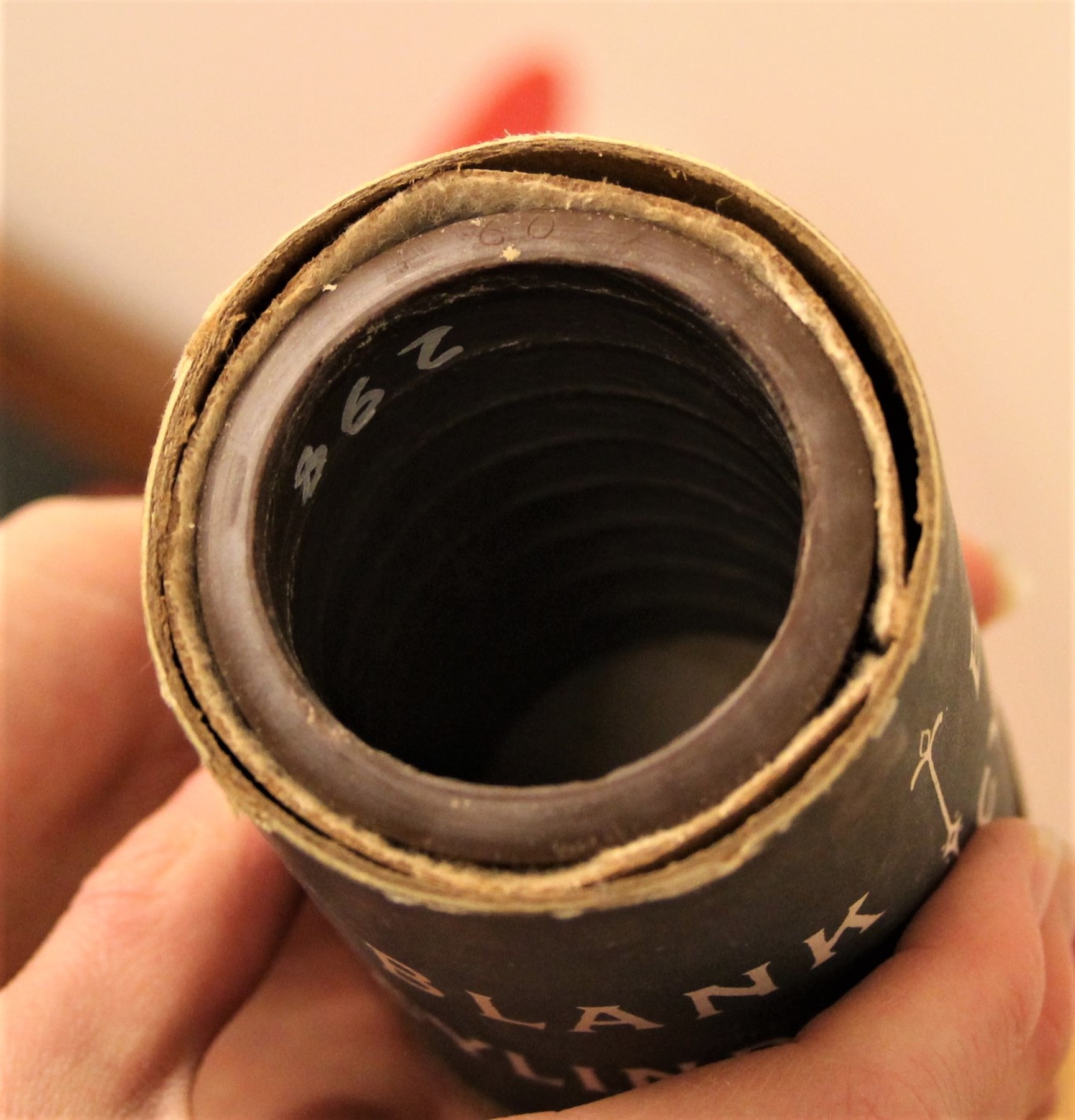    | Layard's fieldnotes are in the John Willoughby Layard papers (MSS 84) in the Special Collections & Archives of the University of California, San Diego. The music notes are compiled in a PDF titled ‘Unpublished Atchin book: “Folk Songs”: Annotated music books, with words and music, hand-written and typed notes, translations.’ from box 47, folder 8. This PDF is held by the British Library. |
The Phonograph and Cylinders
In correspondence with Hornbostel, before departing for Vanuatu, Layard noted that he borrowed “phonographical apparatus” from Charles Myers for the trip (Layard to Hornbostel, 24 June 1914).2Layard to Hornbostel, Buxton (Derbyshire), 24 June 1914. Uncatalogued correspondence, Museum für Volkerkunde, Berlin. Huffman noted that Layard took “an Edison Type 2 ‘Standard’ wax cylinder phonograph” (Huffman 2009:212). Layard’s phonograph is in Cambridge’s Museum of Archaeology and Anthropology. It is not clear from the photographs whether this is the same machine that Myers took with him on the 1898 Cambridge Anthropological Expedition to the Torres Strait; the case, and the metal reinforcing brackets on the edges of the cylinder machine look different. The serial number of the machine itself, H1198, dates it to July 1897, which is before the 1898 expedition left. However, the serial number on the box, 10022, dates it to December 1898. It is possible that the machine was taken on the 1898 expedition, but that it was given a new case and new reinforcing brackets at some point after that.
These 32 brown wax cylinders are in cardboard cylinder boxes, and also a second container, a metal ‘cocoa tin’, now quite rusty. This has kept the cylinders and their cardboard boxes in very good condition.
All of the cylinder lids have “LAYARD ATCHIN” written in ink around the edge, and a number or letter often in the same ink. This identifier lists the cylinders as A-E, 1-16 and 50-60. Many of the cylinder lids have a title written on them in black ink, and most also have comments on the quality of the recording in pencil. All of this information is in Layard’s handwriting (confirmed by Huffman, email to Barnecutt 8 July 2021).
The information listed below is from the British Library’s SAMI (Sound and Moving Image) catalogue, edited by the True Echoes team. Any information recorded on the metal cocoa tin is recorded, then information from the cylinder box and the cylinder itself, and finally the Performance notes which come from the Recording level entry on SAMI and were written by the audio technician who digitised the cylinders.
Performers, Places, Instruments
Eighteen of the cylinders feature men singing, sometimes with drums, ten recordings are of drumming, three are of conch sounds, and one features an aerophone. Cross-referencing the words written on the cylinders suggests that many, if not all, of the recordings were made on Atchin; there are a number of specifically Atchin words used or place names referred to. None of the place names used are from Vao, as far as we understand.
One of the complications in identifying performers is that “men’s names… change on Malakula, depending on their perpetually shifting social status/rank.” (Huffman 2009:216), so whilst Layard identified the performers on the cylinders, the names he used would have been correct in 1914-1915, but not for long.
Meldektaus
Meldektaus is the singer on Songs of Durenambwe (C177/272) and is also a performer (drums) on one track of Tunes on Nambu marur (C177/275).
Melteris / Malteris / Mal-teris
Melteris (also known as Malteris or Mal-teris) is the performer (drums) on a track on Tunes on Nambu marur (C177/275).
The catalogue record for this photograph states “Layard notes in his autobiography (MSS 84 USD library, page 96) that his cook boy on Atchin was named Mal Teres, who was not born on Atchin, his father being from Wala island. As an outsider he had more time on his hands to work for Layard, and he also spoke good pidgin which was beneficial to his research. [H. Geismar 7 April 2004]”.
The same entry notes that “These are not pan pipes but they are “bundle flutes” rather than blowing across like pan pipes, there is only a small hole at the node which is blown at an angle producing a sound like the wind. At the same time, a drum beat is tapped on the side with the fingernails. [Kirk Huffman 16/12/04]”.
The catalogue record for this photograph notes of the seated figure, “To his belt there is attached a pan-pipe of “raft” type called na-mbu pal-pal (or bu pal-pal) consisting of six bamboo tubes closed at the nether end by nodes. These tubes are accurately cut to produce the desired series of notes according to various traditional patterns. [T]hese closed pan-pipes may be used only on the Malekulan mainland in places which women may not approach. The pan-pipe is held in both hands in such a way that two pipes are end-blown at the same time, producing high and piercing notes, excepting at the end of final phrases when a single final note is blown. These instruments were usually played in pairs tuned in unison with one another to procure beat (vibrating) tones. If women hear these they are told they are the voices of ghosts. Some of these closed pan-pipes have eight tubes.” [Layard Papers held in the Mandeville Library, University of San Diego (MSS 84. box 31, folder 6): “Copy of catalogue of my photographs (some of my Cambridge collection). Made for and sent to Jean Guiart with help of Raymond Clausen circa 1963.”].
This photograph was also published in Geismar and Herle (2008:88) with the caption: “Malteris and Malgunsun (sitting) in front of Nem won [house of a married man] of Malteris. [John Layard, Atchin, 1914, HL] They are holding and wearing objects Layard collected for CUMAA.”
Olep
The cylinder recordings may include references to place names. One of these is Olep, which is noted in a number of recordings.
Instruments
Definition of gongs from Layard and Capell’s Atchin dictionary:
“mbwe – gong; gong-signal (nambwe). E tuhu na-mbwe wenen ‘he sounds the wenen gong-signal’; na-mbwe nòsòs, na-mbwe e bure-buren i ‘gong-rhythm dancers taking a serpentine course’; na-mbwe n’äi ‘gong rhythm’; ma-mbwe e wala ‘gong signal, visiting signal’; e re pär-pari na-mbwe ‘gong signal’; na -mbwe ril-dralän ‘gong signal’; na-mbwe na-läŋ ‘small portable slit gong’ ; na-mbwe bạt-e möw ‘gong signal’; nambwe mätä n’äi ‘wood’s eye signal’; e pari na-mbwe ‘to beat a gong (without a special signal)’; na-mbwe tuhaän ‘gong signal’; na -mbwe nuar ‘nautilus shell pattern on woman’s dress’” (Capell and Layard 1980:119).
Probable gong-related words from the cylinder collection: Dureinambwe, Nambwe Humanen, Nambwe Noso̊s, nambwe rildralin.
See information on Meldektaus and Malteris above.
Nambu Marur – na-mbu\marur ‘open musical pipes’ (Capell and Layard 1980:119).
mbu is bamboo, (na-mbu) pan-pipes, bamboo tubes or receptacles. (Capell and Layard 1980:118).
Other words from cylinder lids
maki – The name of the ceremonies at which degrees are taken (Capell and Layard 1980:114).
One of the common features of the coastal peoples of Malakula is “the public degree-taking institution known by the name of Menggi, Mangki, or Maki” (Layard 1928:142).
maki merer-pekes ‘circle tusker maki’ (Capell and Layard 1980:114).
mal – A maki title (Capell and Layard 1980:114).
Palu-ulen is referred to as “the feast of Palu-ulen” (Capell and Layard 1980:209); “the festival of the New Year” (Layard, quoted in Geismar and Herle 2009:148).
Naleng – “The word Na-leng includes Mumming plays of two kinds, namely tragedies dealing with mythological subjects and comedies which are skits on everyday life [and] formal Figure-Dances, consisting of a chorus acting in conjunction with players of individual roles …The performances usually occur at dawn on the day of an important rite after the close of the preceding all night dance” (Layard 1942:336).
Naru – Name of lodge of Pwetertsüts
Niwara – war(a) A pig, the tusk of which has re-entered the jaw (ni-wara) (Capell and Layard 1980:152)
Welenimbek and Welewelen – wele A little, only, just… Reduplicates as wele-wele ‘smallest’, or as noun, ‘a small stone’ (Capell and Layard 1980:154)
- Capell, Arthur and John Willoughby Layard. 1980. Materials in Atchin, Malekula: grammar, vocabulary and texts. Pacific Linguistics, Series D, 20. ANU Press.
- Clausen, Raymond. 1958. A Musicological Study of the Layard Collection of Recorded Malekulan Music in Its Social and Ritual Setting. Thesis (B.Litt), University of Oxford, two volumes. https://solo.bodleian.ox.ac.uk/permalink/f/89vilt/oxfaleph018972343
- Eberhard, David M., Gary F. Simons, and Charles D. Fennig (eds.). 2021. Ethnologue: Languages of the World. Twenty-fourth edition. Dallas, Texas: SIL International.
- Geismar, Haidy. 2005. ‘Footsteps on Malakula: a report on a photographic research project’ in Journal of Museum Ethnography 191-207
- Geismar, Haidy. 2009. ‘Stone Men of Malekula on Malakula: An Ethnography of an Ethnography’ Ethnos, 74:2, 199-228, DOI: 10.1080/00141840902940468
- Geismar, Haidy and Anita Herle (eds). 2009. Moving Images: John Layard, fieldwork and photography on Malakula since 1914. University of Hawaii Press
- Herle, Anita. 2009. ‘John Layard long Malakula 1914-1915: The Potency of Field Photography’ in Geismar and Herle (eds) Moving Images: John Layard, fieldwork and photography on Malakula since 1914, University of Hawaii Press pp 241-263
- Huffman, Kirk. 2009. ‘T’soni, yu save resis (Johnny, you can run fast): Memories of John Layard: Travelling photos, voices, songs, men, pigs and spirits amongst the ‘Sea Peoples’ of Northeast Malakula’, in Geismar and Herle (eds) Moving images: John Layard, fieldwork and photography on Malakula since 1914. University of Hawaii Press pp. 205 – 244
- Langham, Ian. 1977. ‘Obituary: John Willoughby Layard’, Oceania, Vol. 45, No. 3, pp. 237-239
- Layard, John Willoughby. n.d. Unpublished Atchin book: “Folk Songs”: Annotated music books, with words and music, hand-written and typed notes, translations. Box 47, folder 8 of the John Willoughby Layard papers (MSS 84) in the Special Collections & Archives of the University of California, San Diego.
- Layard, John Willoughby. 1928. ‘Degree-Taking Rites in South West Bay, Malekula.’ The Journal of the Royal Anthropological Institute 58:139-223
- Layard, John Willoughby. 1942. Stone Men of Malekula. London: Chatto and Windus.
- Layard, John Willoughby. 1944. ‘Song and Dance in Malekula.’ Man, Journal of the Royal Anthropological Institute 44:121-122
- Pitt Rivers Museum Annual Report 1957-8, http://web.prm.ox.ac.uk/sma/index.php/museum-annual-reports/258-1957-58-annual-report.html
- Speiser, Felix. 1913. Two Years with the Natives in the Western Pacific. London: Mills and Boon, https://www.gutenberg.org/files/27578/27578-h/27578-h.htm












![On Catalogue Card: “Gong orchestra at Pwetertsuts. Ruruar village. Atchin.” From Layard’s fieldnotes: “Gongs being beaten after the erection of the rafters (Nerets). Kilin, Melkelauuli, Meltegto, Malsibini, Meltegnapi, Manimbo, Melkeleruriye. [John Layard, Atchin, 1915, HL, TL1] Gong orchestra at Pwetertsuts](https://www.true-echoes.com/wp-content/uploads/cache/N_98603_LAY_001/1805164832.jpg)
